If you liked this research article please consider supporting the author, by scrolling down for various options, on the main page or sharing a link to this blog post or blog www.isutrikanda.com on your social media so others can also read it. You can also follow me on X @stijnvdhoven Thank you!
Author: Stijn van den Hoven – 5 January, 2024 – www.isutrikanda.com

“Ancient religions and mythology have a common origin in constellations, astronomy, seasons and the rotation of the sky, time and eternal creation itself. “
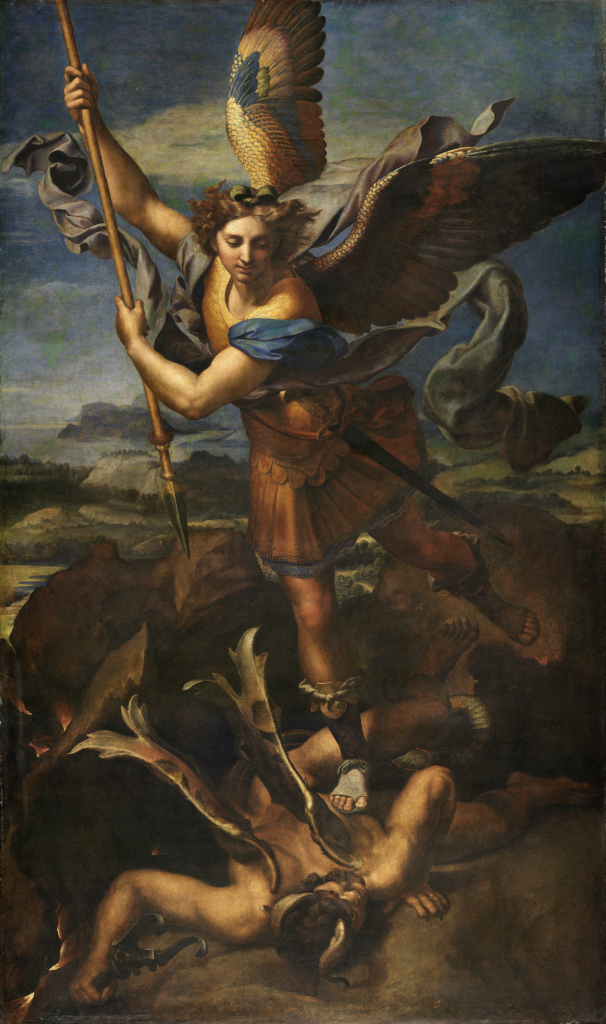
Throughout the ages man has worshipped a variety of different gods in many cultures
From the Egyptian gods, the ones in Babylon, South America, Greece, Rome, India and the middle east, to name a few varieties. Many of these religions have perished with time, gone out of fashion like an old wardrobe, their religious buildings and temples crumbled to ruins. Their gods names and places of worship are either a memory of the past, with some in current decline. Christianity, Islam, Hinduism and Buddhism are the world’s current main religions. As an example, the Greek, Roman, Mayan, Egyptian, Assyrian and Babylonian religions and their gods perished in time.


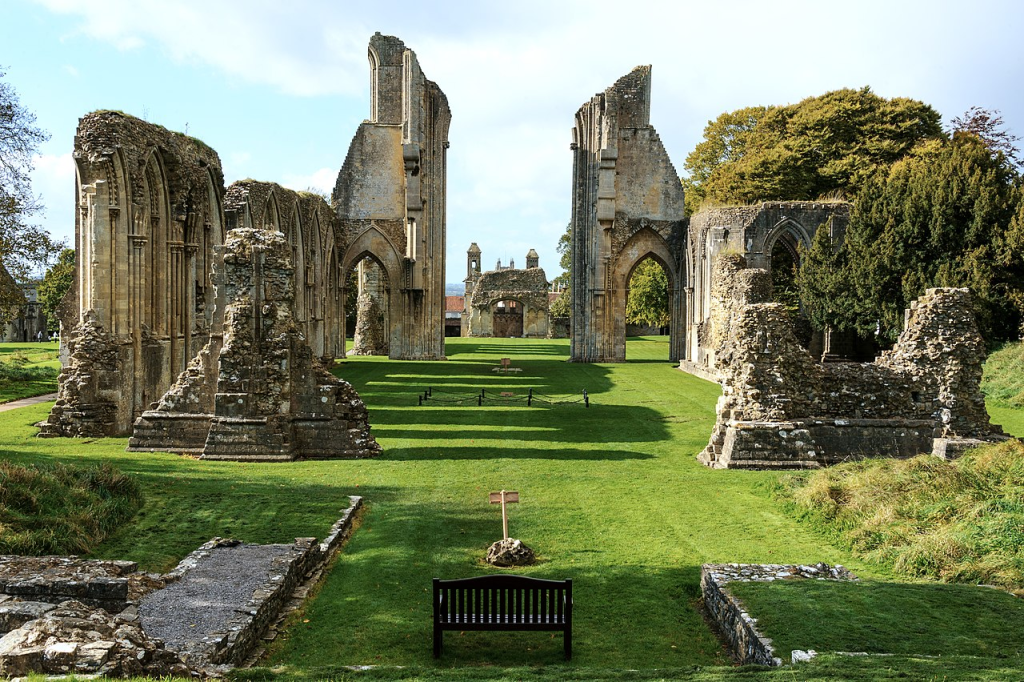
Images: Ruined and forgotten temples. Source: Wikipedia https://commons.wikimedia.org/wiki/File:Egypt,_Temple_half-buried_in_sand.jpg – https://upload.wikimedia.org/wikipedia/commons/1/1f/Tree_roots_and_temple%2C_Ta_Prohm%2C_Angkor%2C_Cambodia.jpg – https://en.wikipedia.org/wiki/Glastonbury_Abbey#/media/File:Glastonbury_Abbey_church_view_from_east.jpg –

Hi there, I appreciate you reading my blog! 👀
The information presented here is free to read, with no ads. If you like this content, please consider supporting my writing by clicking on the link to become a member at Patreon Instead of a monthly recurring Patreon membership, you can also make a once off donation via Paypal or subscribe to my Youtube channel or follow me on X. 👇🏻
Thanks for your support!
Most people are born into a religion, because their parents had that religion. Some are married into a religion and convert on marriage. Some believe in multiple gods, the polytheist and the abrahamic religions Some decide that they do not believe in any gods, the atheist.
In the western world, we were told about “Go(o)d” or “The Creator” and his adversary the “(D)evil” or Satan, lucifer or Azazel as personifications of the apparent perceived respective good and evil forces in the world we live in.
This document looks at these aspects
- How did religion and the various gods associated with it, change over centuries and regions? Why was that “Main god” called so many names in ancient times: Anu, Baal, Zeus, Jupiter, or, more recently Vishnu, Shiva, Brahma, Jaweh or Allah in various recent religions? We need to look at the origins of the relatively modern religions and identify where these came from, or where these were based on.
- Are there any relations between them or common origins, to understand the concept of God(s) throughout the ages?
- Discussing many world religions, some long gone and finding paralels and syncretism to the new ones. Old wine in new flasks.
- The asociation of rulers with religion or symbolism of gods, in their appearance and buildings
This was not an easy task. When people study academically, they usualy specialise as an Egyptologist or Greek/Roman history as example. However for this task a global approach was needed, to understand if there are relations and common origins comparing cultures with their gods, through the ages.
Time, (re)creation itself, constellations was personified and worshipped as such. Even the mathematics of creation Pi, in the pyramids slopes and temples and churches proportions. As a symbol of eternal life, the tree of life, or the evergreen pine tree with its fibonacci pinecone.
“God and religion was a human attempt to try to capture the essence of time and creation itself with the use of allegories about the rotating constellations, fictional characters and personified deities.“
The practice of human worship in the form of a god, has been going on for centuries, from the ram headed Knuhm (He will later proven to be of significance in relation to the later Jaweh) and Amun-Ra, as main creator deities and Sah/Sopdet and Osiris/Isis as lesser figures with the Egyptians. Anu, Enki, Enlil, Ishtar/Inanna/Astarte with the Babylonians and more importantly in our context:
“The true shepherd of Anu” as the constellation Orion.
Zeus and the “previous son of god” Hercules/Heracles with the Greeks and Romans, Baal/Asherah and Melqart with the Phoenicians, Jaweh, Maria and Jesus by the Catholics. All these are syncretised versions related to the same skies and astronomy as we will see, in relation to Orion, Sirius, the central skygod and the opposite of Orion, ophiucus. The same star clusters, locations in the sky over the year, with many varying “personified” names.
What is presented to us as “the current truth”? The author will at this point start with a focus on the Christian bible and catholic religion and tries to assert its true hidden meaning. A task that has been attempted by many biblical scholars. Some archaeologist are desperately trying to find physical proof of Jesus and his story in the real physical world. Yet that has been in vain, as one will understand, after reading what is said here.
The author will not dissect the bible, verse by verse, but instead look at the main story line and its characters to explain certain things.
Let us start with a bold statement:
“The stories about the figures Jezus in the new testament, the 12 apostles or the 4 evangelist or Adam and Eve in the old testament, were never historical figures but references to constellations, based on previous conceived, predated, astronomical allegories.” – Isu Trikanda
It is important to understand that the bible contains two seperate stories. The old and the new testament. Stories that do not linearly follow each other, with huge apparent timegaps in between them. It is very important to see these as two separate allegorical stories in relation to the zodiac, bound into 1 book.
The author will try to show you that both are stories of turning stars in the sky creating the seasons and time itself in an ever-ongoing creation. The withering and recreation of the earth in the seasons that make up the year. The author will also dive into other symbolisms and expressions used by the Vatican and the catholic church. As a preview of this leading as an introduction, please have a look at the following diagram of the skies.

Note that both the old and the new testament are encoded in this single image.
What was said at the time about the people in power in “the whoes against the phariseas”, applies very much to our current “leaders”.
- The teachers of the law and the Pharisees sit in Moses’ seat.
- They do not practice what they preach.
- Everything they do is done for people to see: They make their phylacteries wide and the tassels on their garments long;
- They love the place of honor at banquets and the most important seats in the synagogues.
- They love to be greeted with respect in the marketplaces and to be called ‘Rabbi’ by others.
- The greatest among you will be your servant. For those who exalt themselves will be humbled, and those who humble themselves will be exalted.
- You shut the door of the kingdom of heaven in people’s faces. You yourselves do not enter, nor will you let those enter who are trying to.
- You travel over land and sea to win a single convert, and when you have succeeded, you make them twice as much a child of hell as you are.
- You give a tenth of your spices—mint, dill and cumin. But you have neglected the more important matters of the law—justice, mercy and faithfulness. You should have practiced the latter, without neglecting the former. You blind guides! You strain out a gnat but swallow a camel.
- You clean the outside of the cup and dish, but inside they are full of greed and self-indulgence.
- You are like whitewashed tombs, which look beautiful on the outside but on the inside are full of the bones of the dead and everything unclean. In the same way, on the outside you appear to people as righteous but on the inside you are full of hypocrisy and wickedness.
- ‘If we had lived in the days of our ancestors, we would not have taken part with them in shedding the blood of the prophets.’ So you testify against yourselves that you are the descendants of those who murdered the prophets. Go ahead, then, and complete what your ancestors started!
The new testament
We start with the new testament as it is closest to most people and to the Christian faith as a whole. There is no current “worship of Adam and Eve” in churches, besides the 10 comandments, it is mostly focused on the teachings of Jesus and his disciples, with the believers hoping that “the savior” or messiah one day will return. Till date, people have been waiting for 2000 years for such a miraculous event. In Islam, Jesus is seen as a prophet and not as the son of god. But both scriptures mention him.
What are the main facts that are presented to us?
- 4 evangelist wrote the books, their respective signs where: Mark (Lion), John (Eagle),Matthew (Man), Luke (Bull)
- A figure called Jesus, portrayed as a shepherd
- Born of Maria, a virgin immaculate conception
- Jesus and the donkeys
- Born in a stable, between an ox and a donkey
- Jesus had 12 apostles
- The two thieves
- Jesus was “The son of god”
- Jesus is often depicted or related to the symbol of a fish.
- Jesus was regarded the lamb of god
- The symbol of the dove, the holy spirt
- Walking on water
- Entering Jerusalem through its gates as a saint and the blocking it with a cemetery.
Where did this story come from? During the reign of the Roman Emperor Constantine the Great (AD 306–337), Christianity began to transition to the dominant religion of the Roman Empire.
To understand this story we need to understand what came before this. What did people belief before Jesus, what was “the previous state religion” which got replaced by Christianity, the story of Jesus?
Lets go back to our list of bible facts and try to answer these one by one.
- The 4 evangelists.

Image: A 13th-century ivory carving of Christ in Majesty surrounded by the creatures of the tetramorph, in the Musée de Cluny, Paris. Source: https://en.wikipedia.org/wiki/Tetramorph#/media/File:CLUNY-Coffret_Christ_1.JPG
The 4 evangelist are the 4 corners of the Zodiac as their signs indicate. Its Aquarius, Leo and Taurus, but there is no scorpio, there is an eagle instead?. Yes that is correct. Ofcourse an evangelist could not be assigned the sign of a scorpion, a perceived evil poisonous beast. So they decided to give John the sign of Aquilla, the eagle, which just sits above scorpio, still perfectly matching the 4 corners of the zodiac.

Image: Aquila replaced the scorpion at the 4 evangelst signs due to the negative connotation of the scorpion. Source: https://www.nasa.gov/audience/forstudents/k-4/dictionary/Constellation.html
Taurus “the bull”, Leo “the lion”, Aquarius “the man” and Scorpio “the scorpion” make up for what is called, the 4 corners of the zodiac. Since Babylonian times the 4 districts of the sky where charted and marked in that time by the 4 royal stars.
Quote: In astrology, the royal stars of Persia are Aldebaran (Taurus), Regulus (Leo), Antares(Scorpio) and Fomalhaut(Pisces). They were regarded as the guardians of the sky during the time of the Persian Empire (550 BC–330 BC) in the area of modern-day Iran. The Persians believed that the sky was divided into four districts with each district being guarded by one of the four Royal Stars. The stars were believed to hold both good and evil power and the Persians looked upon them for guidance in scientific calculations of the sky, such as the calendar and lunar/solar cycles, and for predictions. Source: https://en.wikipedia.org/wiki/Royal_stars
It is noteworthy that a star of Pisces and not of aquarius was chosen in those times, yet they are in the same section of the sky.
Quote: Pisces originates from some composition of the Babylonian constellations Šinunutu4 “the great swallow” in current western Pisces, and Anunitum the “Lady of the Heaven” (supposedly Inanna), at the place of the northern fish. Source:
https://en.wikipedia.org/wiki/Pisces_(constellation)
4 corner figures in Egypt
In Egypt the concept of the 4 corners was obviuously known. They alligned their pyramids to the 4 cardinal directions. But they also had personifications for the 4 corners, much like the 4 evangelist. They had the godesses Isis, Sopdet, Neith and Serketh(scorpion) for the representation of the 4 corners. In Tutankamons tomb, his canopic shrine was perfectly placed alligned to the 4 corners with the respective godesses for their directions.
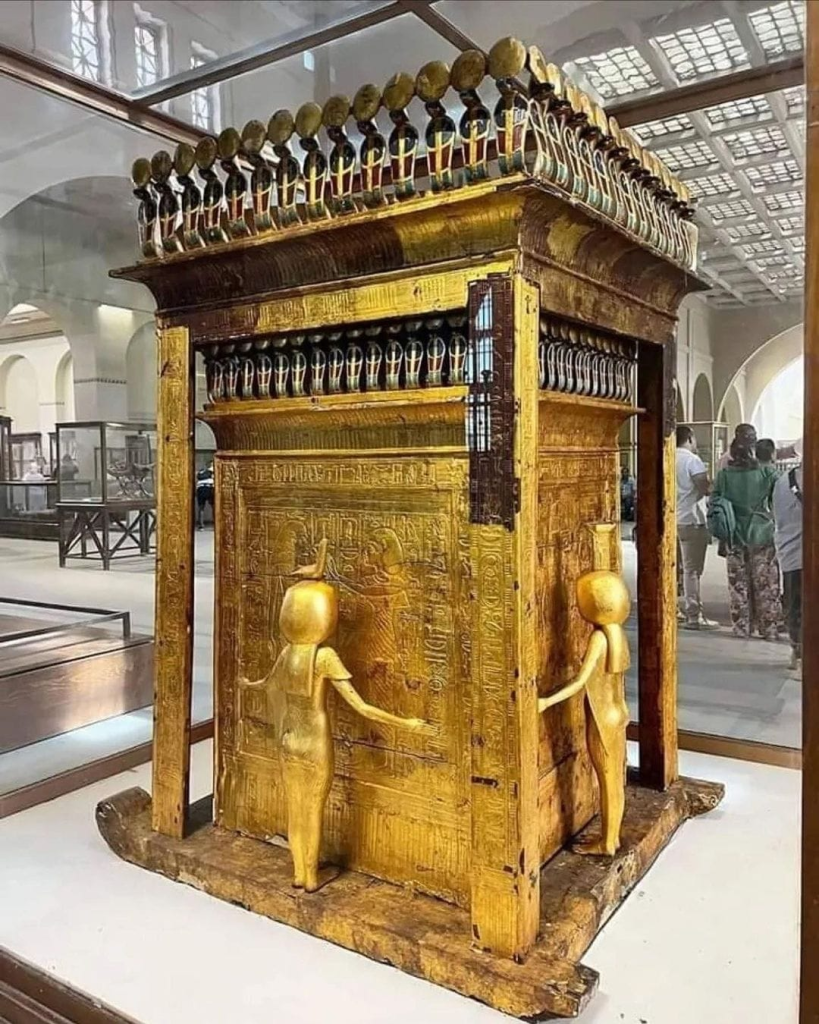

Image: Tutankamons Canopic Shrine and canopic chest. Source: https://en.wikipedia.org/wiki/Tomb_of_Tutankhamun and https://en.wikipedia.org/wiki/Canopic_chest
We see the 4 godesses upholding their respective sections of the sky also at the Denderra Zodiac

Image: The Denderra Zodiac, the original was cut out and is now at the Louvre museum in Paris. https://en.wikipedia.org/wiki/Dendera_zodiac#/media/File:Zodiaque_de_Dend%C3%A9ra_-Mus%C3%A9e_du_Louvre_Antiquit%C3%A9s_Egyptiennes_D_38;_E_13482.jpg
Canopic jars also were made in the 4 sons of Horus.
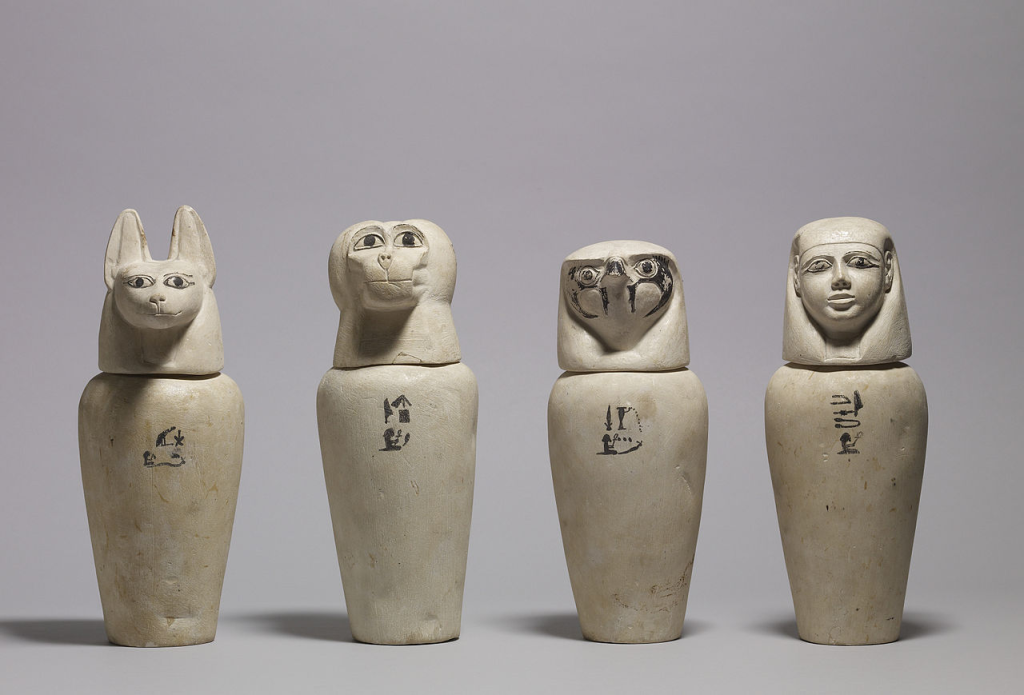
Complete set of canopic jars of the four sons of Horus; 900–800 BC; painted limestone; Walters Art Museum (Baltimore, US) Source: https://en.wikipedia.org/wiki/Canopic_jar#/media/File:Egyptian_-A_Complete_Set_of_Canopic_Jars–Walters_41171,_41172,_41173,_41174-_Group.jpg
Horus was closely linked to Osiris being his son. We can see Horus on the astronomical relief of the Dendera Zodiac. This zodiac was closely related to the babylonian version.

The point made here is that the biblical 4 evangelist are the 4 corners of the zodiac. The 4 godesses or Horus and his 4 sons, is the same concept as Jesus and the 4 evangelist. This was combined with Hercules and its 12 labours, (Orion and the 12 zodiac signs.) to make Jezus and 4 evangelist and 12 apostles.
The 4 pillars of heaven are a concept that even can be seen in the vatican altar where 4 pillars symbolically uphold the firmament. Above it the circular dome and in the 4 corners, the 4 evangelist. EVERYTHING is astronomy if you know how to read it.
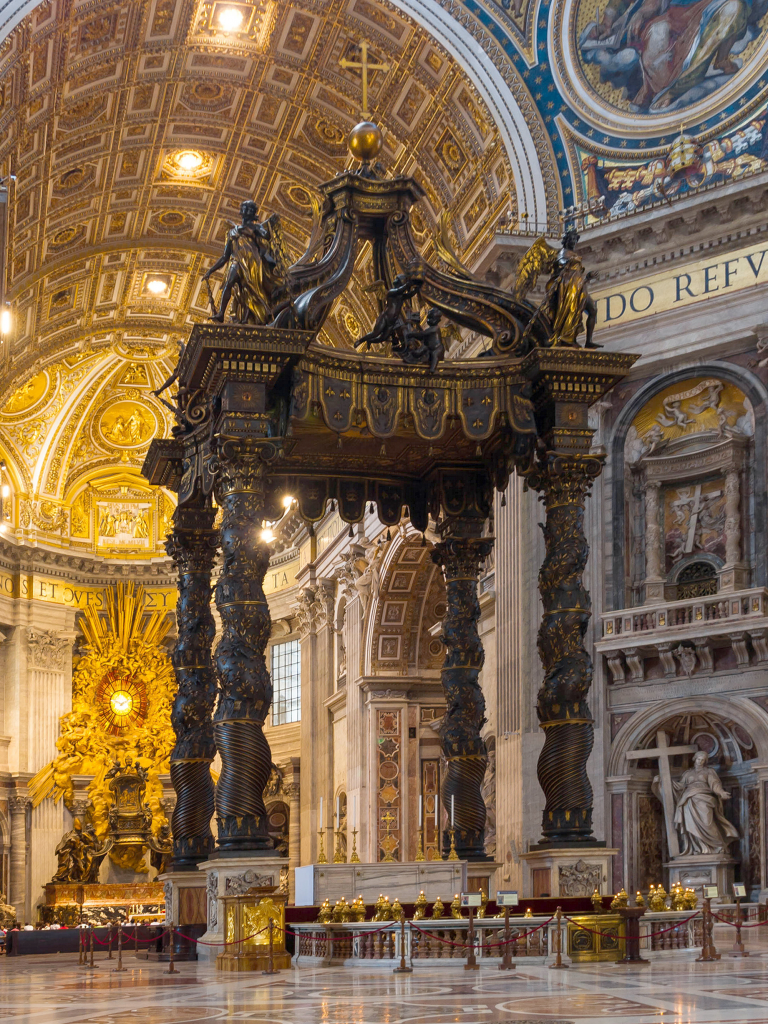

Image: St. Peters Baldachin – https://en.wikipedia.org/wiki/St._Peter%27s_Baldachin and Cupola above it with the 4 evangelist as the 4 corners of the circular sky. https://www.viator.com/en-IE/Rome-attractions/St-Peters-Basilica-Dome/d511-a14020
A Figure called Jesus, portrayed as a shepherd.
So where did this “shepherd figure” come from. This traces back to the Babylonian zodiac. Gavin White wrote a great book about this. (https://www.amazon.com/Babylonian-Star-Lore-Illustrated-Star-Lore-Constellations/dp/095590370X) See the image in the section about the rooster.

Image: from the book of Gavin White, Babylonian star lore, highlighting the area of Orion Hercules, Zeus son, and Lepus, which was a Shepherd of Anu and a rooster.
In this picture, we can see that the constellation of Orion was once called “The true shepherd of Anu”, where Anu was again, the central sky god deity, like Zeus and Jaweh, the “main god”.
The Hindus
But it goes further then this. The early hindu’s called the constellation of Orion, the “3 headed spear”, due to the 3 belt stars. It has relations to their god, Shiva Nataraja, the dancing shiva.


Images are from old Tamil books, showing Shiva as the constellation Orion. The actual name of this book is unknown to me. the online source of these are: https://www.chidambaramhiddentreasure.com/orion-chidambaram/
Hinduism is not the only link of their god to the Orion constellation.
A great article was written in 1999 by Greg Taylor of the website, dailygraal.com. This article includes that piece in full, with written permission of Greg Taylor. Similar conclusions where made independently by the author but since he wrote about it first, the author choose to fully include his article instead of rephrasing it, to explain these relations.
The God with the Upraised Arm: An Astronomical Archetype? https://www.dailygrail.com/2010/03/the-god-with-the-upraised-arm/
BY GREG TAYLOR
(This essay was originally posted to The Daily Grail in 1999)
In the depictions of mythological scenes on Near Eastern archaeological monuments and artefacts, a number of ‘archetypal images’ are apparent. One of the most intriguing of these is the ‘God with the Upraised-Arm’, which can be found in scenes from Egypt, right through the fertile-crescent to Anatolia. In Egypt it is apparent from the time of unification onwards, seen in identical depictions which capture the pharaoh in the act of smiting his enemies. This common image can be linked within a mythological context to the contendings of the gods Horus and Seth, with the king identified as Horus and the enemy Seth. Further, it would also appear that the ‘smiting pose’ was considered by the Egyptians to be visible as a constellation in their sky. The constellation of Orion presents itself as the most convincing candidate, although previous studies will have to be considered before accepting this identification.

If correct, this would suggest that some of Horus’ characteristics were due to the use of Orion as a seasonal marker. This becomes even more apparent when we shift our gaze to other parts of the Near East, where the ‘God with the Upraised Arm’ can be found in abundance. His context remains the same: either as the adversary of chaos, or as the bringer of rain and fertility. The common depiction and mythological treatment of this god across a range of cultures and time-periods suggests that it must be have been based upon an important and archetypal image. It is impossible to say for certain whether this image was Orion; nonetheless, this identification provides a comprehensive explanation for certain characteristics of the ‘God with the Upraised Arm’.
The Narmer Palette (Figure 1) is often seen as a historical depiction of the unification of Upper and Lower Egypt. The image of King Narmer, wearing the white crown of the south and smiting an enemy commonly held to be a northerner, is often cited as evidence that he was the unifier of the two lands (Grimal 1992, p. 37). This became a standard picture of the king throughout the history of Egypt (see Figures 2 and 3), whether the king holds a mace, a spear or even a bowstring in his right hand. Frankfort (1948, pp. 7-9) sees this as not only a scene showing a decisive historical battle, but also as a representation of the king as the divine ruler.

He asserts that the real meaning of the scene is that the king’s victory represents the ‘reduction of chaos to order’, an important pre-occupation with the ancient Egyptians. Chaos assumed many forms: death, drought, invading enemies; these were all seen as manifestations of Seth (Frankfort 1948, p. 183). It was the king’s job, as the earthly incarnation of Horus, to overpower Seth/chaos and maintain the established order. This is obvious from ancient Egyptian texts. For example, in the Cosmology of Abydos we find the following passage describing the triumph of Horus over Seth: ‘Dignity has been set in place, honesty has been established through his laws, evil has departed, wickedness is gone, the land is at peace under its lord’ (Colless 1994, p. 23). If the Narmer Palette scene is thus considered a symbolic representation of Horus defeating Seth, we would expect to see similar representations explicitly showing these gods battling. There is ample evidence of this and, importantly, certain elements such as the ‘upraised arm’ seem to hold great significance.

At the Temple of Edfu there is an abundance of imagery concerning the contendings of Horus and Seth. On approaching the temple one is immediately met by huge images on the pylons of the king in ‘smiting pose’ in the presence of Horus (Figure 4). Inside the temple is found the dramatic text ‘The Triumph of Horus’ with associated scenes. Dated to approximately 110 BCE, its antecedents would appear to be in feasts and texts from the earliest dynasties (Fairman 1974, p. 34). The drama concerns the harpooning of Seth by Horus (10 times, a symbolic detail which perhaps shares a common origin with the 10 decapitated bodies on the Narmer Palette), after which Horus is crowned the King of Upper and Lower Egypt. Fairman (1974, p. 32) points out that this was not just the re-enactment of myth, but also a means by which the success of the king was ensured each year. Again, Horus is depicted with his arm raised (Figure 5), this time harpooning Seth (represented by a hippopotamus).


That this pose is not simply incidental is confirmed by the naming of Horus in the text as ‘Him-with-the-upraised-arm’ (Fairman 1974, pp. 106, 117). This was originally the epithet of Min, the god of rain and fertility, for obvious reasons (see Figure 6): he is pictured with an upraised arm holding what is thought to be a thunderbolt. Horus and Min became increasingly identified as one and the same during the Middle Kingdom,

Although Min was already associated with the Pharaoh at least as early as the 4th Dynasty. On the verso of the Stela of Sobek-iry is found the Hymn to Min, which includes the verse ‘I worship Min, I extol arm-raising Horus’ (Lichtheim 1973, p. 204). The overall impression is that the upraised arm of Min-Horus was considered to be a characteristic pose of vital importance.
Another crucial point to emerge from the ‘Triumph of Horus’ is that Horus was the ‘Great God, Lord of the Sky’ (Fairman 1974, p. 90), a quote which is followed by the passage ‘we grant strength to thine arm’. There are numerous other references implying that Horus is to be looked for in the sky; for example ‘the gods of the sky are in terror of Horus’ (Fairman 1974, p. 102). Significantly, Min in pre-Dynastic times was a sky-god called the ‘Chief of Heaven’ (Arnold 1999). This raises the question of whether the archetypal image has its origin in the sky. A look at the astronomical ceilings of Senmut and Seti I confirms this. On Senmut’s ceiling (Figure 7) there is an almost identical depiction of Horus as at Edfu, with the arm upraised in the act of harpooning Seth (this time represented as the constellation Meskhetiu). There is also an unidentified individual in the same pose amongst the group of constellations at the lower part of the image, this time harpooning a crocodile (another incarnation of Seth). He appears almost identically on the Seti I ceiling (Figure 8). Thus the ‘God with the Upraised Arm’ can be considered a constellation recognisable by the ancient Egyptians. The obvious question therefore, is which one?


The outstanding candidate to fit the description is the constellation of Orion (Figure 9), at the very least on sheer resemblance. This constellation was well known to the Egyptians, mentioned in the Pyramid Texts in connection with the stellar destiny of the ‘resurrected pharaoh’. For example, in Utterance 442 we find ‘Lo, Osiris has come as Orion’ (Lichtheim 1973, p. 45). That Osiris is seen as Orion is not considered a problem to the thesis currently under discussion; he was also thought to be incarnate in the Moon and the Nile, and ancient Egyptian cosmologies often contain seemingly contradictory concepts (Frankfort et al. 1946, p. 47).

Turning our attention to Horus, we find evidence in Plutarch’s Isis and Osiris (1927, p. 53) of a connection with Orion: ‘the soul of Isis is called Sothis (Sirius), the soul of Horus is called Orion, and the soul of Typhon (Seth) the Bear’. Plutarch may be thought of as slightly unreliable in regards to the recording of Egyptian culture, however, considering the correct attribution of Isis and Seth to their respective constellations the conflation of Horus and Orion should be taken seriously. More circumstantial is the story recorded on the Metternich Stela in which the young Horus is stung by a scorpion, a mythological motif suggesting the setting of Orion as Scorpius rises (Krupp 1991, p. 137). It should be taken into account as well that Horus was said to have been placed upon the ‘seat of his father Osiris’, perhaps an indication that they were both identified with Orion.
One of the arguments against this identification could well be that the constellations on this section of the ‘astronomical ceilings’ are all supposed to be north of the ecliptic (Parker 1974, p.60). It is pertinent to note that Parker actually says ‘we are reasonably sure they are all north of the ecliptic’. Neugebauer (1957, p.89) names them as the northern constellations directly after mentioning that ‘artistic principles determined the arrangement of astronomical ceiling decorations’. Also, in describing the northern constellations on the Denderah Zodiac, Parker (1974, p. 63) mentions that these are ‘presumably all north of the ecliptic but none is depicted in the usual group of northern constellations’. Interestingly Plutarch (1927, p. 93) mentions that the Egyptians hold the lion in honour because the Nile overflows when the sun comes into conjunction with Leo, which is on the ecliptic (Leo and Sirius rise almost together in Egypt). This suggests that the ‘Lion’ constellation on the astronomical ceilings may in fact be Leo (contrary to current thought). Lastly, to illustrate that the Egyptian conception of the sky was perhaps completely different to ours, consider the following passage from a tomb at Luxor, describing the movements of the ship of Re: ‘Once the constellation of Masheti (Meskhetiu) has been passed, they reach shelter in the centre of the sky on the side south of Sah-Orion, and they turn towards the western horizon’ (Zinner 1957, p. 28). From this account of the east-west passage of the sun, the ancient Egyptians’ conception of the heavens appears to be more complex than usually thought. Another argument against the Horus-Orion link may be that the figure with the upraised arm is sometimes reversed, however, the same is true of the northern constellation of the hippopotamus on the Denderah circular zodiac. Probably the most difficult problem is that on the decanal list on the Senmut ceiling Isis is illustrated with her arm upraised, the significance of which is not clear. However, accepting a link between Horus and Orion has the strong point of explaining the attributes of the god, especially once Orion’s role as a seasonal marker is understood.
Using stars and constellations as seasonal markers was commonplace in the ancient world. The heliacal rising of Sirius in July was considered by the Romans to be the reason for the sultry weather (Krupp 1991, p. 222). To the Egyptians this same event signalled the beginning of the Nile flood and thus the New Year. The heliacal rising of a star or constellation was seen as its resurrection after being ‘dead’ for a period of time. This is due to the apparent motion of the sun through different portions of the sky (a result of the actual motion of the Earth around the sun). When the sun moved into the vicinity of a certain star or constellation it would only be seen late in the west just after the setting of the sun, and after a time would eventually ‘disappear’ (when the sun was in direct conjunction with it). Once the sun moved further still the star/constellation would then appear in the morning sky in the east just before dawn: this was its heliacal rising. Sirius and Orion both ‘died’ for approximately 70 days, which could well be the origin of the embalming time for Egyptian mummies (Neugebauer 1957, p. 87).
In the time of the ancient Egyptians, Orion was ‘dead’ from around the spring equinox through to mid-summer. Interestingly, Frankfort et al (1946, p. 35) note that in Egypt the prevailing wind is from the north, which gives relief from the heat of the sun and makes life much more comfortable. However, late spring (at the time of Orion’s ‘death’) was the season of hot dry winds bringing ‘sandstorms and a brittle heat out of Africa to the south’. It was from this period until Sirius’ heliacal rising that the Nile was at its lowest ebb also. Plutarch (1927, pp. 93-99) states that Seth was considered the power of drought and the south wind, while Horus was the north wind, the ‘seasonal tempering of the surrounding air’. He asserts that the story of their battles is actually an allegory for the seasonal changes: so as Horus ‘dies’ in spring, Seth gains the upper hand until the reappearance of the rightful king. Thus Orion, connected with Horus, seems to have been used as a seasonal marker indicating the return of ‘orderly’ weather. As Krupp (1979, p. 189) says, the ‘apparent connection between celestial and terrestrial phenomena greatly affected the Egyptian view of the world’. This is just as evident when we turn our gaze to other parts of the Near East.
The ‘God with the Upraised Arm’ was present in many cultures and across a wide timeframe in the Near East. The gods Teshub, Hadad, Baal and the unnamed Hittite weather god (Figures 10 – 13) all had similar appearances and mythological contexts and could be considered incarnations of this one god (Krupp 1997, p. 147). A common motif in the depiction of all of these is the upraised arm wielding a mace or lightning. Also sometimes present is a vertical object in the left hand such as a spear or lightning, which has a parallel in the depictions of the Egyptian pharaohs in their smiting pose (see Figure 2). The god is also often presented as riding on two mountain gods, or some sort of animal (another parallel with Horus standing upon the hippopotamus).




All of these characteristics are indicative of the constellation Orion (see Figure 14 which is an Islamic depiction of Orion, portrayed from outside the celestial globe, hence it is reversed), although it far from proves the case. Treating the Ugaritic god Baal as representative of this group of gods may prove illuminating however.

The myths concerning Baal have two major themes, which are very similar to the mythic themes surrounding Horus. The first is Baal’s battle with Yamm, which personifies the battle of order against chaos. The other is Baal’s death at the hand of Mot, and subsequent resurrection. This myth clearly suggests the yearly cycle, and also that Baal may well be a constellation. In a direct parallel to the Horus-Seth confrontation, Baal finds out that he is to be swallowed by Mot, the god of death and drought. His descent suggests that he is a sky-god: he is to be ‘numbered with those who descend into the earth’ and set his face ‘to go to the mountains where [the sun sets]’ (Colless 1994, pp. 166-167). Also, after his death Athtar (who is identified with Venus) tries to take Baal’s throne, but he cannot reach it (Gray 1969, p. 75). In his absence ‘Shapash (the Sun) the luminary of the gods glowed hot, the heavens languished under the hand of Mot (drought)…the days passed into months’ (Colless 1994, p. 169), a clear indication of the heat of summer. Baal’s return heralds the return of the rain, for he was believed to be manifest in the storms of late autumn and winter (Gray 1969, p. 81). While acknowledging that cultivation was of the utmost importance to these early civilisations, it is difficult to subscribe to the common opinion that this is a ‘vegetation myth’ (Ringren 1973, p. 134). Certainly this is part of it, but it encompasses more than this. For the result of the weather gods’ disappearance is not restricted to the suffering of vegetation; every aspect of life is affected (Deighton 1982, p. 71). This indicates an allegory for seasonal change. And the seasonal marker par excellence of the Mediterranean was Orion. His heliacal rising indicated summer, and the time of threshing; his evening appearance the approach of winter and its attendant storms (Allen 1963, p.306). Even taking into account the precession of the equinoxes, this attribute of Orion would have been reasonably constant for the time period concerning ancient civilisation in the Near East.
The similarity in depictions of this god across the Near East argues for its importance. Deighton (1982, p. 29) mentions that ‘certain types of scene are repeated time and time again…the wealth of meaning which must have lain behind the monuments…was so alive to those who produced them that they did not require any explanatory notes’. Also the common mythological motifs: Baal goes into the earth, the Hittite weather god is deemed to have withdrawn into a hole; Horus’ victory marks the return of the cooling north wind, Marduk’s vanquishing of Tiamat results in the ‘bringing of rain and coolness’ (Colless 1994, p. 102). The acceptance of this ‘God with the Upraised Arm’ as Orion, and as seasonal marker, fits the pictorial and textual evidence well. Needless to say, restricting any definition of these gods to one particular manifestation is unwise. The significance of the ancient gods was manifold to their respective cultures, the many aspects of Osiris being good evidence of this. But the archetypal model upon which the ‘God with the Upraised Arm’ was based is quite probably the constellation Orion, in both depiction and ‘nature’. Describing these mythological concepts as agricultural in nature only covers part of the territory, as agriculture depends upon the celestial cycles. The importance of these cycles to ancient people cannot be underestimated. It is a proven fact that they recognised significant ‘markers’ within this cycle, and it is only natural that one of most important of these should be the constellation of Orion. To paraphrase Sir James Frazer in The Golden Bough (1922, p. 506): in the course of our enquiry it has, I trust, been made clear that there is another natural phenomenon to which the conception of death and resurrection is as applicable as to the agricultural cycle. This phenomenon is the yearly death and resurrection of the constellation of Orion, as represented in the mythic themes concerning the various incarnations of the ‘God with the Upraised Arm’.
References
Aldred, Cyril, 1965. Egypt to the End of the Old Kingdom. Thames and Hudson,
London.
Allen, Richard Hinckley, 1963. Star Names: Their Lore and Meaning. Dover
Publications, New York.
Arnold, April 1999 ‘Min’, Ancient Egypt: The Mythology,
http://www.ixpres.com/netjert/min.htm.
Colless, Brian, 1994. Hieroglyph and Cuneiform: Ancient religious writings.
Deighton, Hilary J. 1982. The ‘Weather-God’ in Hittite Anatolia: An
Examination of the Archaeological and Textual Sources. Biblical Archaeology
Review, Oxford.
Fairman, H. W. (ed.), 1974. The Triumph of Horus: An Ancient Egyptian Sacred
Drama. B. T. Batsford Ltd, London.
Frankfort, H. and H. A., Wilson, John A., Jacobsen, Thorkild, Irwin, William
A., 1946. The Intellectual Adventure of Early Man. The University of Chicago
Press, Chicago.
Frankfort, H., 1948. Kingship and the Gods. University of Chicago Press,
Chicago
Frazer, Sir James George, 1922. The Golden Bough: A Study in Magic and
Religion (Abridged edition). Macmillan Press Ltd., London.
Gray, John. 1969. Near Eastern Mythology. Hamlyn Publishing Group Ltd.,
Sydney.
Grimal, Nicolas, 1988. A History of Ancient Egypt, trans. Ian Shaw, Blackwell,
Oxford.
Guirand, Felix, 1996. The Larousse Encyclopedia of Mythology, trans Richard
Aldrington and Delano Ames, Chancellor Press, London.
Krupp, E. C. 1979. In Search of Ancient Astronomies. Chatto and Windus,
London.
Krupp, E. C. 1991. Beyond the Blue Horizon: Myths and Legends of the
Sun,
Moon, Stars and Planets. Harper Collins, New York.
Krupp, E. C. 1997. Skywatchers, Shamans and Kings: Astronomy and the
Archaeology of Power. John Wiley & Sons Inc., New York.
Lichtheim, Miriam. 1973. Ancient Egyptian Literature, Volume I: The Old and
Middle Kingdom. University of California Press, Los Angeles.
Neugebauer, O. 1957. The Exact Sciences in Antiquity. Brown University Press,
Providence, Rhode Island.
Parker, Richard A., ‘Ancient Egyptian Astronomy’, in The Place of Astronomy in
the Ancient World, ed. F. R. Hodson, Oxford University Press, London.
Plutarch, 1927. Plutarch’s Moralia, trans. Frank Cole Babbit, William
Heinemann Ltd., London.
Ringren, Helmer, 1973. Religions of the Ancient Near East, trans. John Sturdy,
S.P.C.K, London.
Sidgwick, J. B., 1951. Introducing Astronomy, Faber & Faber Ltd., London.
Santillana, Georgio and Von Dechend, Hertha, 1969. Hamlet’s Mill: An essay
investigating
the origins of human knowledge and its transmission through myth. David R.
Godine, New Hampshire.
Zinner, Ernst, 1957. The Stars Above Us. George Allen & Unwin, London.
Text is copyright © 1999 to Greg Taylor. Published on the internet on
4th November 1999, at the “Daily Grail” website (http://www.dailygrail.com/)
Greg is the owner-editor of The Daily Grail, as well as the author of a number of books including Stop Worrying, There Probably is an Afterlife.
After the earlier images that Shiva is also derived from Orion this aditional information showing why that would be the case is adding to the bigger picture. It doesnt take much imagination to see that Hadad, Teshubs and Baals lightning bolt or Vayra combined with his bull transmuted into the Trishula of Shiva and that Greg is indeed spot on with his relation to Narmer and Min and even Osiris in Egypt. A pattern is starting to emerge in “Gods the ancient world.” They all are derived from astronomy and specifically, the Orion constellation.


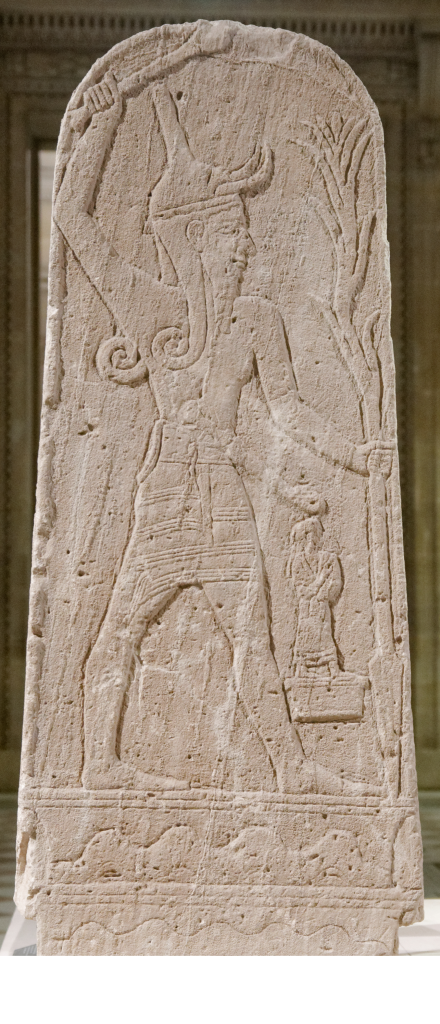
3 images showing better how Hadad, Teshub was the likely candidate for Shiva, something that Greg did not include in his article, but what he did include is of great significance.
Nandi Bull
It is also not surprising that Shiva is allways paired with a Nandi bull in Hindu temples, where he Nandi bull facing Shiva. This is because sihiva’s Nandi bull is Taurus and the dwarf he dances on, is Lepus. This was also again related to Hadad/Teshub who was also depicted with the bull ofcourse.


The Orion constellation in sanskrit, which will be of extreme importance to the rest of this thesis, name was
Iṣu trikāṇḍā (इषुस्त्रिकाण्डा):—[=iṣu-trikāṇḍā] [from iṣu > iṣ] (iṣutrikāṇḍā) f. ‘the threefold arrow’ or 3 headed spear. Name of a constellation (Girdle of Orion), [Aitareya-brāhmaṇa]
This name is for Shivas weapon, the Trisula or 3 headed spear. But it is the name for spear that is of great importance here, next to the earlier babylonian asociation of the sheperd. It is ISU, close to a spelling variant of Jesus used in certain languages, Isus, Isoes. There is a spear relation mentioned in the bible to the roman soldier who poked jezus side when he was “on the cross”.
In the previous shown image of the 4 evangelist, take specific note of the tablets 3 “iron holders” which are, 3 spears. A detail only understandable if one knows this relation. One that tablet, one can also see the figure of Jesus in the middle, “riding on the ecliptic band” the invisible “band in the sky” on which the constellations move through the seasons.
This is the basis for the cross, as it’s the horizontal bar of it. The vertical one being the “pillar of heaven”. This is why the cross is such an important symbol on Christianity as it is the ecliptic band, just as much as it was with the Maya King Pakal’s tomb lid as the “tree of life”. Santiago de Compostela, refers to “the field of stars” / Compo Stella.
The constellation of Orion resurrects yearly as it changes its position in the sky with Hydra, the snake over the seasons. Spring was the ancient start of new year, still celebrated as Newros in Iran. A festival of torches and light. Orion was the spring constellation, that “resurrected” every year. “The resurrection”, is the return of the constellation of Orion. There is no further need to wait, or be falsely promised, for Jesus to return. He does so every year. When the sun passes over the club of hercules, he becomes, the torchbearer, of the bringer of light, conquering darkness,
- Born of Maria an immaculate conception. Now that we determined Jesus as a constellation, we need to look at his birth and where he was born. Well, Maria. Our Lady, Star of the Sea, is an ancient title for the Virgin Mary. The words Star of the Sea are a translation of the Latin title Stella Maris. What is the “star of the sea”?
In this case its not as easy as just looking at Hinduism or at Durga with its Tiger. One needs to take into account that the Virgin Mother or great mother celestial asociaton is likely not that of Virgo and Leo, whilst this is the case for Durga. I would possibly related Adam and Eve to Orion and Virgo, or, Orion and Artemis but it’s a bit more complicated.
Medusa is a form of the virgin Virgo. Medusa was raped as a virgin(Virgo) in the temple of Athena by Poseidon (Aquarius) and turned into Medusa by Athena. Here she dwelled in the underworld as the Kneeler constellation, currently falsley attributed to Hercules, as I described in a seperate blog article.
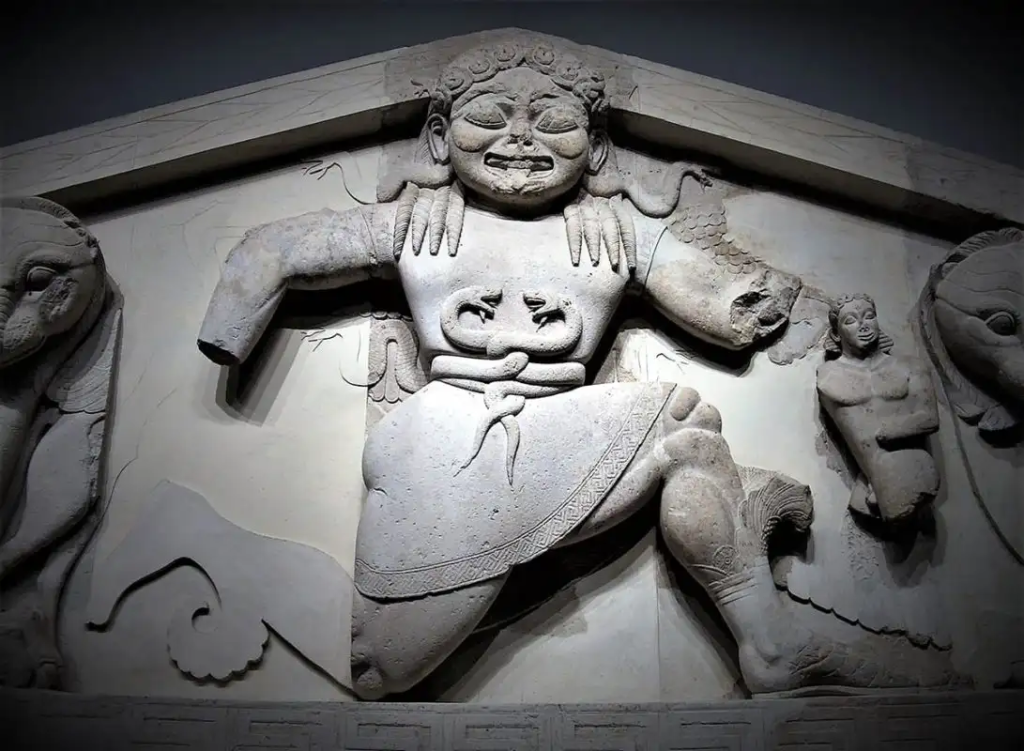
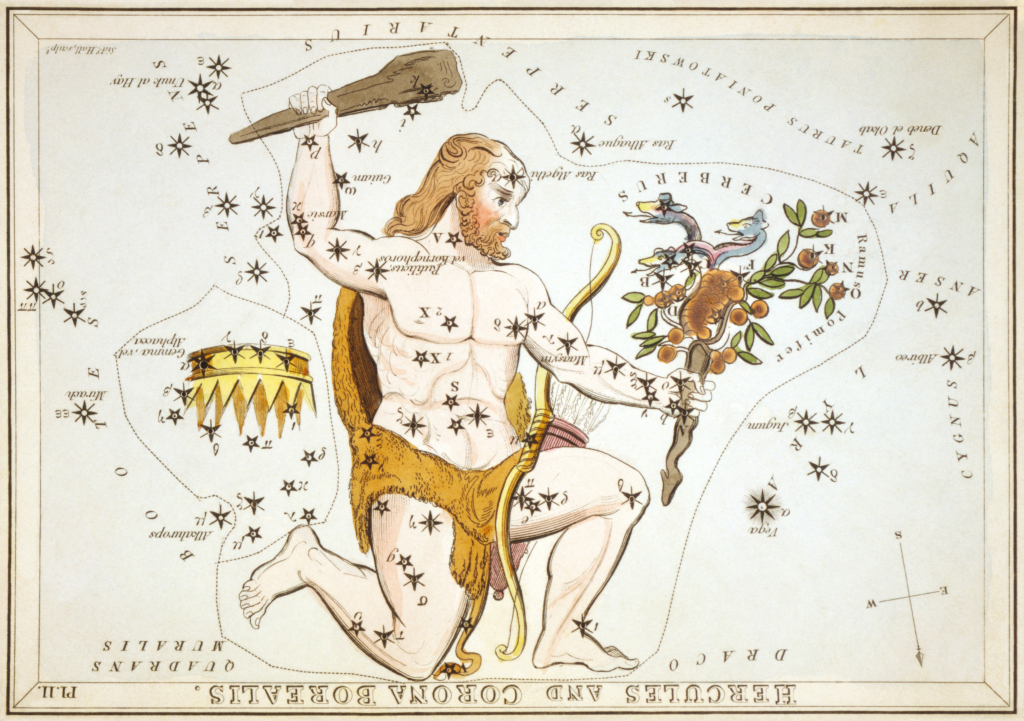
Image: Pediment of the artemis temple in Corfu and image of “The kneeler” constellation which is in my view is Medusa and not Hercules. Source: https://www.thecollector.com/temple-artemis-corfu-medusa-head/ and https://en.wikipedia.org/wiki/Cerberus_%28constellation%29
There are multiple celestial women and its not so easy to afiliate them all. Whilst Sopdhet was Sirus as consort of Sah, Jezus never had a partner just a mother, whilst Adam and Eve where a pair. The great mother, as Hathor, the female cow or Sopdhet is a more likely candidate for Maria oposed to Virgo. Also because Isis, then Osiris consort, was also sirius. Jet Jesus is not Horus although all in the same star region (the Falcon on the perch, the arrow constellation). Its rather complicated.

Image: Isis and Horus, Source: https://www.metmuseum.org/art/collection/search/545969
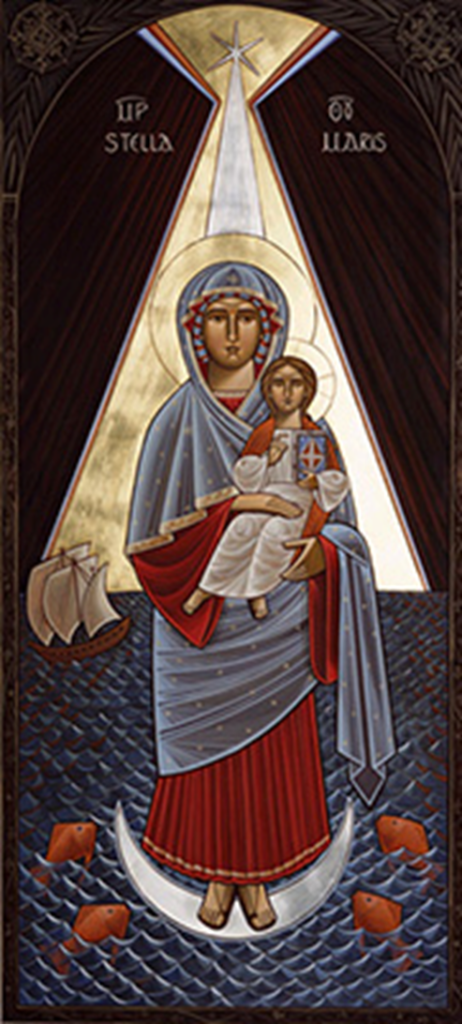
Image: Stella Maris, star of the sea, https://udayton.edu/imri/mary/s/stella-maris.php
Quote: “Stella Maris (The Star of the Sea) has long been the favourite title by which people of the sea have called on her in whose protection they have always trusted: the Blessed Virgin Mary. Her son, Jesus Christ, accompanied his disciples in their vessels, helped them in their work and calmed the storms. And so the Church accompanies seafarers, caring for the special spiritual needs of those who for various reasons live and work in the maritime world. – Pope John Paul II
The Sea covers two thirds of the planet and the people of the sea, those who live, work or have their present or past way of life linked in any way to the sea are served by the Church through the Apostleship of the Sea (AOS). The AOS is often known locally as Stella Maris after the name given to the many seafarers hostels provided in ports around the world.
The AOS today has a presence in some 116 countries and is striving to serve many millions of people. These are people who may always be on the move or who may be shore based. These are people involved in the international seafaring and coastal seafaring trades, in commercial fishing and in subsistence fishing communities, in the offshore oil industry or in the cruise shipping industry plus the many contract sailors employed in yachting around the world. Our Lady Star of the Sea is the patron of the AOS and all those who contribute to this work of serving the People of the Sea.
This Icon of our Lady Star of the Sea was painted in the Neo-Coptic style by the internationally renowned iconographer Dr. Stephane Rene who is the only exponent of this sacred artistic tradition in the West.
The Coptic icon is the direct heir to the spirituality of the Desert Fathers who were the first Christian Monks (Coptic period second to seventh centuries) and lived in the deserts of the Middle East. They led a prayerful and reflective way of life and developed a spirituality which shaped many monastic rules such as that of St. Benedict. St. Jerome was a Desert Father and he identified in his writings that Mary, the Mother of God, was the Star of the Sea.
The Star of the Sea is the most ancient of titles for Our Lady. It is premised that in the time of Our Lord the equivalent phrase of Our Lady in the Aramaic language of that day meant pilot, leader or guide–someone who could navigate through the sea or the desert by the stars and lead people to safety. The stars were and are used as a guide to safety and to new life. The sea covers all the earth and symbolises all the people of the earth. Our Lady was therefore identified from the very earliest days of the Church as the guiding light to her son, Our Lord, for all the people of the earth.
The Icon of Our Lady Star of the Sea–Stella Maris
The Icon Stella Maris is set in the context of the night and reflects the difficulties of life sensed more deeply at night and perhaps also of the times of the dark night of our souls.The triangles are symbols of fire which in turn are symbols of the Spirit.
The star is Sirius, the largest and most brilliant star in the heavens. A major star of navigation but also known in mythology as the God Star or the Dog Star that leads. This star was (and is) an object of great worship in many cultures around the world. In the middle east the rising of Sirius in the heavens in June coincided with the annual floods of the Nile upon which the lives of the ancient Egyptians depended.
The visible circulation of the minor stars Sirius A and Sirius B around Sirius itself were also part of this worship culture and form the basis of the Star of David symbol.
The Virgin and Child are positioned in the upward pointing triangle of the Spirit–linking to Sirius the lead star of navigation Mary is herself the Star which illuminates our inner darkness and leads our souls to her divine Son.
The sea has always been the most feared elements of nature because of its enormous power to sustain life or destroy. We are powerless and insignificant in the midst of its rage. Yet in its benign aspect the sea is a source of untold beauty and nourishment for mankind. The sea is therefore a metaphor for life and its perils but also for its wondrous joy and beauty. The world-wide ocean also represents all the peoples of the world.
The four fish are a reference to the four Gospels, and ultimately Christ Himself who was know to the early Christians as the Great Fish (Ethos).
The boat in the background is a symbol of the individual soul of the believer on the spiritual path. This boat of life can be navigated safely by turning to Christ as guided by Our Lady star of the Sea, the star of our life.The boat is also an image of the Church Militant navigating through time, through life and to the promised land.
Our Lady is depicted standing on the moon, again an object of worship in ancient religions. The image also recalls the verse in Revelation Chapter 12. And there appeared a great wonder in heaven; a woman clothed with the sun, and the moon under her feet, and upon her head a crown of twelve stars.”
Source: https://udayton.edu/imri/mary/s/stella-maris.php
So, Maria is the star Sirus and Orion, was “born from her” by immaculate conception.. Indeed, as stars don’t copulate and they were never human.

Image Sah and Sopdhet. Or, the later Isis and Osiris with their sone Horus on a perch in between them. The babyloanian Arrow constellation. Gavin White equates Sirius, the arrow constellation or the Perches bird with the summer solstice, which in itself would be a fitting attribute for Horus. It is noteworthy that this was in 3000BC.
Around the year 0, Orion would mark the Spring Equinox instead due to the precession of the equinoxes and thus his resurection there and the “easterbunny” lepus. The previous roosterer.
The herald of the gods. Or, messenger of god as Jesus is said to be. The Herald of the gods was allways accompanied by the rooster. It was the rooster who played an important role in the betrayal of Jezus by Judas and it’s the very rooster that we see on some church towers. Its also the rooster we see as Lepus next to the true shepherd of Anu.


Mercury, who was the messenger of the gods, is seen with a rooster. His caduceus is like the orthodox bishops staff. More on the rooster later, lets first do the Caducueus/Snakes. They pretend to be or think they are, “the messengers of god”.

Image: Orthodox bishop staff. https://www.cbc.ca/news/world/pope-francis-demands-end-to-isis-attacks-as-he-wraps-turkey-visit-1.2855125
The two snakes are important historical astrological symbolism and as such also found on the ballustrades of temples in Egypt, Asia and Meso America. They also appear in greek art on this Pxyis box currently in the Berlin museum. With the swastikas all over it, as a symbol of the rotating sky.
i suspect that this is most likely a zodiac box with the figures around it certain areas in the sky. We see for example the master or mistress of the animals, hare and bull, horse and others, but the lid is the two snakes, the two halves of the zodiac, with possible references to the egyptian snakes around the sundisk. The cross on the lid and the two snakes is close to the staff of the bishops, in symbolism. The 4 directions and the two snakes…



The Serpent Shadows of Chichén Itzá An optical illusion at the equinox.
One has to understand all this symbolism to see that all of this is not a coincidence and indeed related. Chichén Itzá is an astronomical marvel. Not only have the steps on each side 91 steps, with the top structure making 365, it also alligns to the cardinal (The pope also has cardinals) points and this each side is a season.

Image: The serpent play at the Equinox. http://travelthruhistory.com/the-serpent-shadows-of-chichen-itza/

Image: A perfect zodiac cross, The chrisitan cross where Orion dies and resurects on. The mayan “version of Jezus” was the Maize god. Dying and resurecting, coming from a turtle. One of Orions names in star lore is a turtle. https://www.offset.com/photos/aerial-top-down-view-of-chichen-itza-pyramids-mexico-1043562
Inside a jaguar throne, its spots of the jaguar like Dyonisus jaguar and present in Egyptian and Mayan priest robes, its spotsmarking the stars.

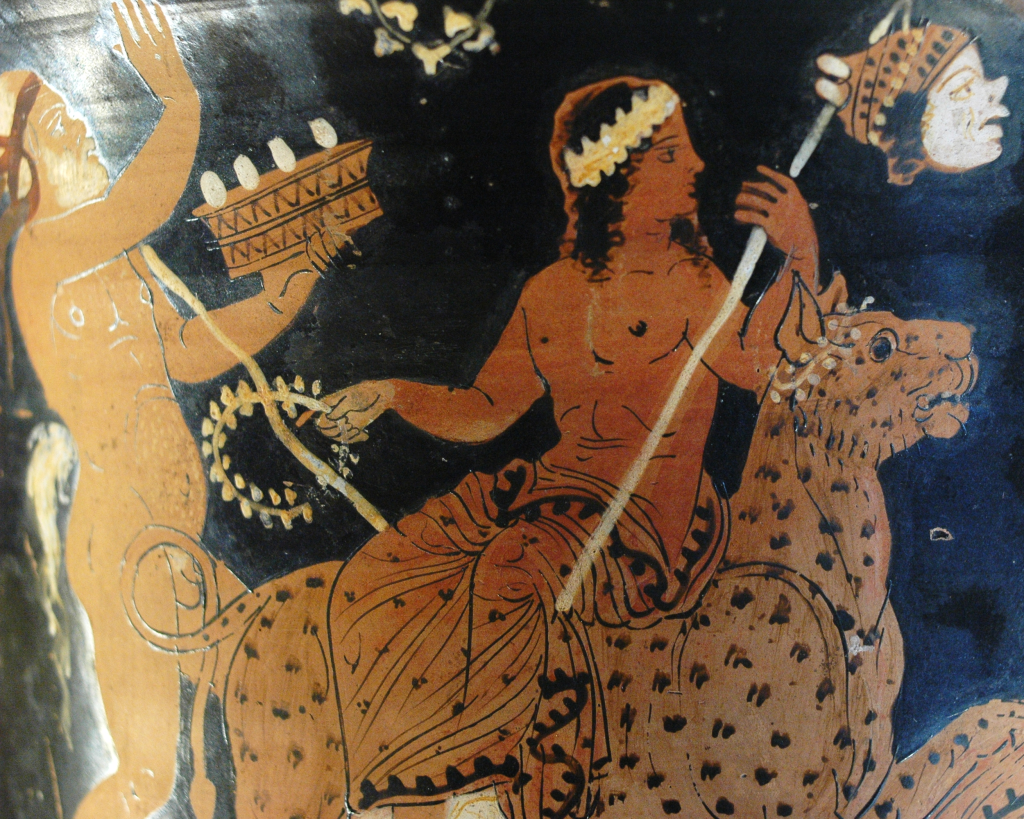
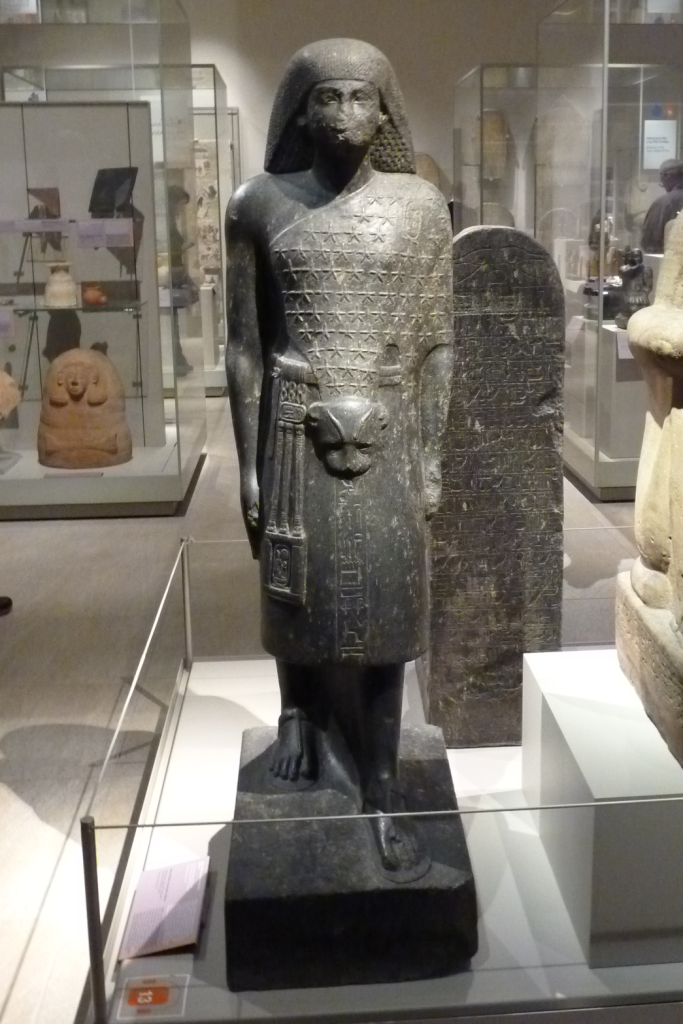
Images:
Chichen Itza Jaguar Throne https://en.wikipedia.org/wiki/El_Castillo,_Chichen_Itza
Dyonisus a form of Orion, Note the head (like the head of medusa, algol) https://en.m.wikipedia.org/wiki/File:Dionysos_panther_Louvre_K240.jpg
Statue of Egyptian priest showing that the spots of the jaguar are the stars symbolically. https://upload.wikimedia.org/wikipedia/commons/2/2d/Statue_Aanen_Turin.JPG
The spotted leopard has been used in old world cultures as symbol of the sky, notably in egyptian priest, african chiefs but also in Turkey and the etruscan civilization. One can say its “coincidence” a jaguar throne was placed on a solar pyramid in chichen Itza, as “just a powerfull animal” but there could possibly be other reasons for such. The disc found in the Chichen Itza temple displays a snake or dragon in a swastika cross pattern, for the rotation of the skies, being most likely Draco, which is the candidate for their feathered serpent. Draco had wings in Phoenician times, those where later clipped and became the little dipper.
Quote: “According to the Greek geographer and historian Strabo (63 B.C. to A.D. 21?), the seven stars we see today as part of Ursa Minor (the Little Dipper) didn’t carry that name until 600 B.C. or so. Before that time, people saw this group of stars outlining the wings of the constellation Draco the Dragon. When the seafaring Phoenicians visited the Greek philosopher Thales around 600 B.C., they showed him how to navigate by the stars. Purportedly, Thales clipped the Dragon’s wings to create a new constellation, possibly because this new way of looking at the stars enabled Greek sailors to more easily locate the north celestial pole.” Source: https://earthsky.org/tonight/how-to-find-the-little-dipper/
Thus Draco makes a perfect, feathered serpent…


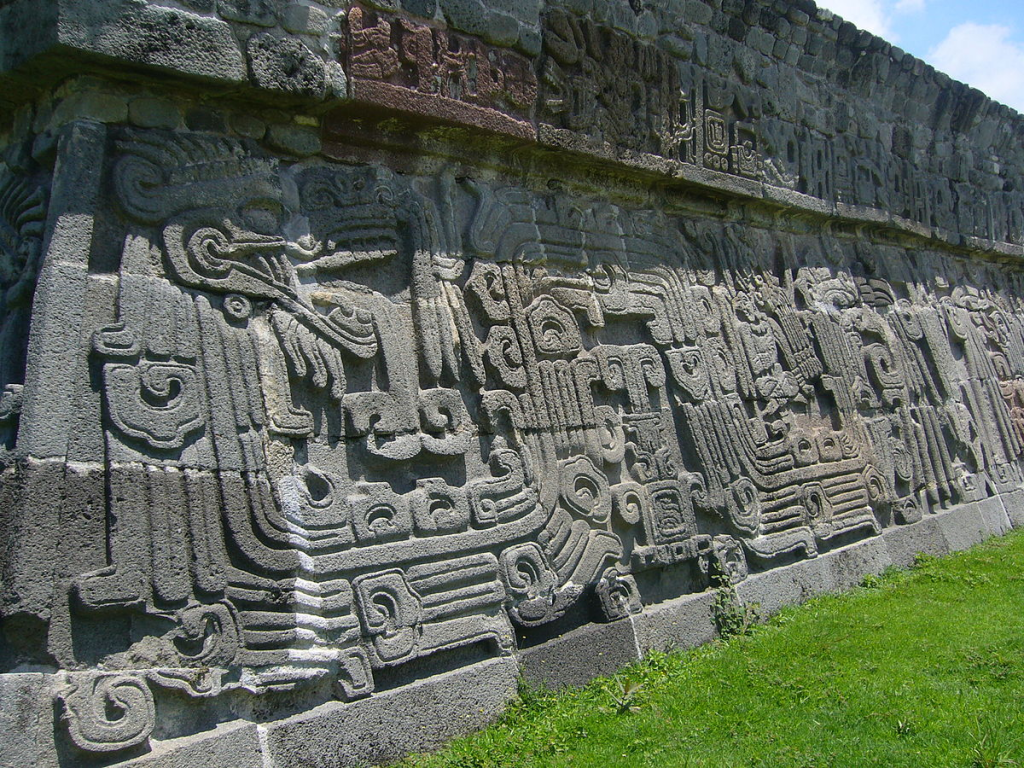
Images
Old starmap of Draco, showing the little dipper, which were ones the serpents wings. Source: https://en.wikipedia.org/wiki/File:Sidney_Hall_-Urania%27s_Mirror-_Draco_and_Ursa_Minor.jpg
Tablet found in Chichen Itza temple, showing the rotating dragon/serpent. Source: https://www.reddit.com/r/ArtefactPorn/comments/z5hfvh/a_maya_turquoisemosaic_disk_found_within_the/
Bas-relief carvings at the Temple of the Feathered Serpent in Xochicalco, Mexico, showing apparent influences of Teotihuacan and Maya art. 8th-10th century CE Source: https://en.wikipedia.org/wiki/File:Pir%C3%A1mide_de_Xochicalco.JPG
Resurection at Spring and the symbol of the cross
The symbol of the cross, with the altar at its cross section, which is a model for many old churches, is alligned east/west and north/south. The cross the pillar of heaven straight up, the cross bar is the ecliptic band. On this ecliptic band, Orion is “crucified” every year and resurected in spring at those times. Why does Jezus “resurects” at easter? Because the constellation Orion rose again after being absent for half a year when it trades places with ophiucus and scorpio. Not personified, but in the forms of Keys and gates in the vatican logo as described also in this document.
It is also noteworthy that in a church, 6 apostles sit on 1 side and the other 6 sit on the other side. At easter the priest walks in a circular motion passed all of them, just like the sun “walks past the 12 zodiac signs”.
The green man
The green man is directly derived and related to the Oak and Holly king. Where the greenman is the oak king of spring/summer. The green man is prominently featured in churches like Rosslyn Chappel. He is green full of vegetation for the obvious reasons of the returning green of the land and has its origins in Osiris, who was also depicted green and who is the Orion constellation derived from Narmers smithing pose. That was the reason they made Osiris green and why he previously was depicted as the god Min with an Erect Phallus also symbolizing the fertility of the land.
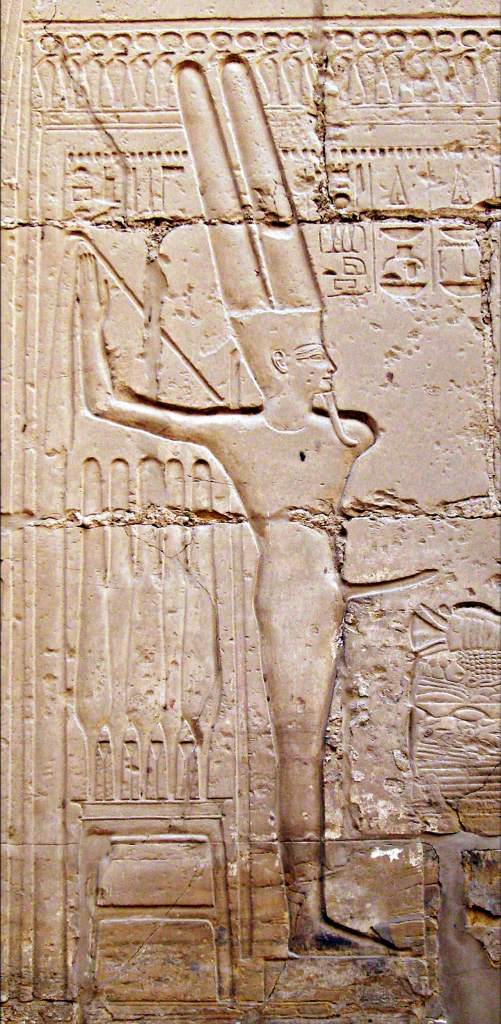
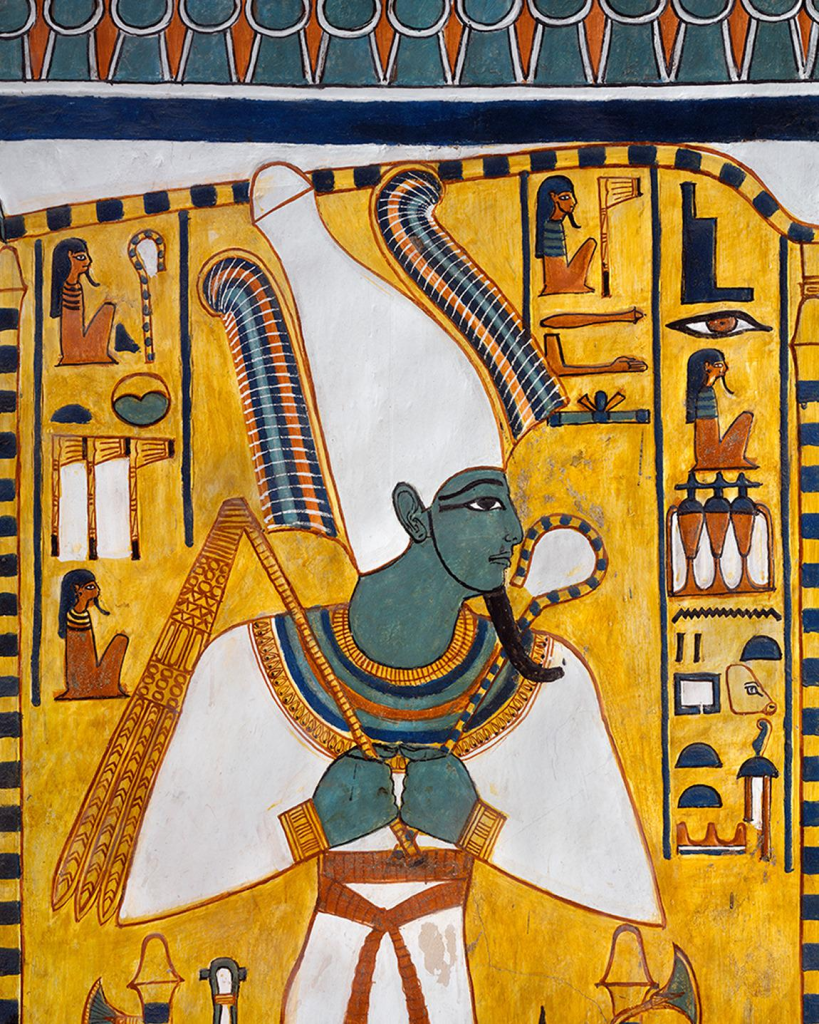
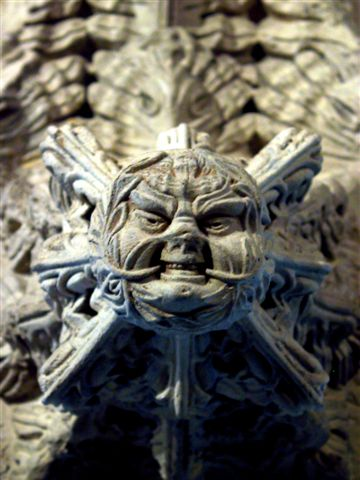
The god Min, Together with Narmer is the precursor to Osiris in the Orion place – Source: https://en.wikipedia.org/wiki/Min_(god)
The God Osiris, green-skinned; detail from the “House of Eternity” of Queen Nefertari, Valley of the Queens, QV66, west ‘Uaset’-Thebes – Source: https://www.reddit.com/media?url=https%3A%2F%2Fi.redd.it%2F324c23qej5u81.jpg
Rosslyn Chappel the Green man – Source: https://upload.wikimedia.org/wikipedia/commons/6/6b/Rosslyn_chapel_green_men.jpg
This erect phallus is also applied to the Cerne Abass giant, which again is a representation of Orion and lastly in the Shiva symbolism extensively as highligted.
The Cerne abbas giant
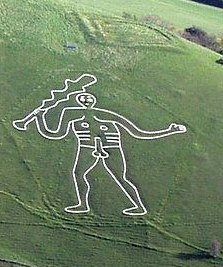

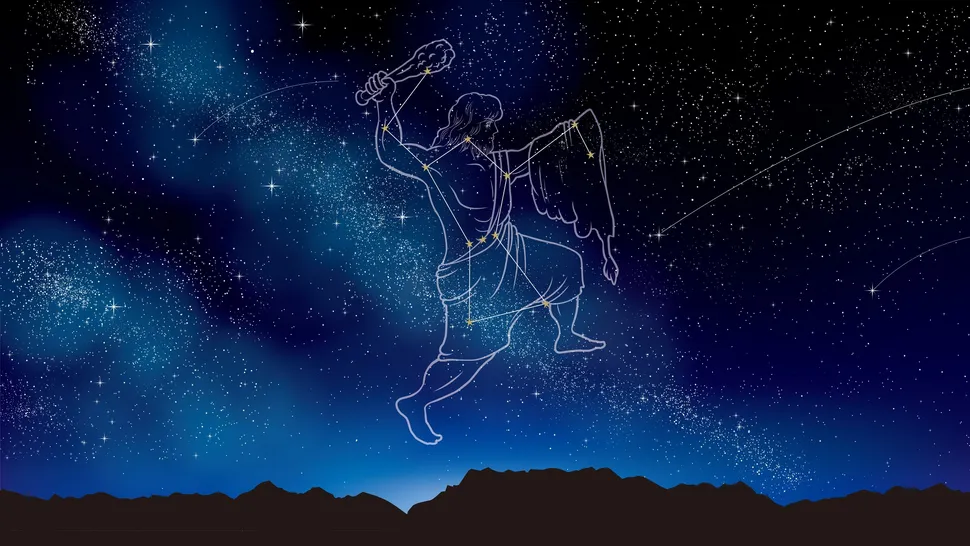
Cerne Abass Giant – Source: https://en.wikipedia.org/wiki/Cerne_Abbas_Giant
Cerne Abbas Giant Cloak found with ground radar, which is not restored – Source: https://en.wikipedia.org/wiki/Cerne_Abbas_Giant
Image of the orion constellation as Hercules with its club and nemean lion Skin – Source: https://www.space.com/16659-constellation-orion.html
The Cerne Abass giant is, a representation, of the “giant in the sky” (as is the giant in jack and the beanstalk) It is the constellation Hercules, with its club, ground radar found its cloak, which is currently not restored by the national trust. That is a disservice to this monument and hinders its identification for what it truly is. Not proof of giants, but a reference to the giant of the sky. In arabic the name for the constellation is Al-Jabbar, the giant, almighty.

Image: Jack and the beanstalk, a nod to “the giant in the sky”. Source: https://villains.fandom.com/wiki/Giant_(Jack_and_the_Beanstalk)
It perfectly aligns with the Orion worship as the “man in the sky”. Its giant phallus, a nod to fertility of spring, just like the easter hare and eggs. But also to previous phalic depictions of the constellation (Min, Shiva, Sayburc) Since the beginning of time, the turning of the skies, time and creation itself, was used to create “religions” that have their origins in the stars of Orion.


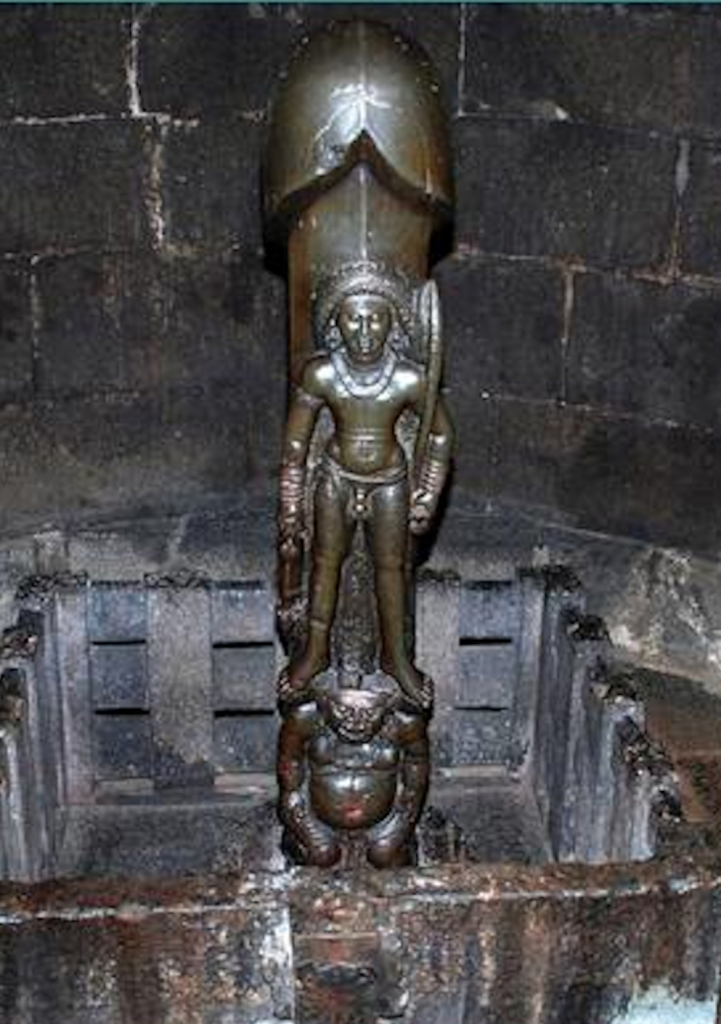
Detail of the Cerne Abass Giant – Source: https://www.independent.co.uk/news/science/archaeology/cerne-abbas-chalk-giant-snails-age-prehistoric-archaeology-national-trust-a9607891.html
Shiva as Orion constellation – Source: https://www.chidambaramhiddentreasure.com/orion-chidambaram/
The first phallic Shiva Lingam / Gudimallam Lingam – Source: https://en.wikipedia.org/wiki/Gudimallam_Lingam
It was first the Phallus symbolism and later the green color or leaves that denoted fertility of the land. Hence that the stone of kings, Jade, was refered and that there are “Emerald budhas”, not surprisingly as even Budha is derived from the Orion Constellation.
The identification of the Anatolian Sayburç relief as Orion and its relation to Indus valley Iconography
The Sayburç relief as Orion and the Aslantaş valley rock relief as a master of the animals motiv. Asserting these have relations to that of the indus valey iconography.
Adition: In a megalithomania video from 26 July 2023, they explain the name: Sayburç, Say & burç , Counting + Zodiac / Watch tower. (https://www.youtube.com/watch?v=S-kxoWYZwus) This enforces below thesis.
In 2021 there was a discovery of the Sayburç relief. It asserts that the relief and iconography of the Anatolian era is related to the Indus valley iconography. It also directly relates the rock relief at the Aslantaş valley to the master of the animal’s iconography and specifically names the constellation of Orion as the source of this imagery.

Source: The Sayburç relief (photograph by B. Köşker) – https://www.cambridge.org/core/journals/antiquity/article/sayburc-reliefs-a-narrative-scene-from-the-neolithic/3A35B54B3265C7224CB225FE70EBDD02
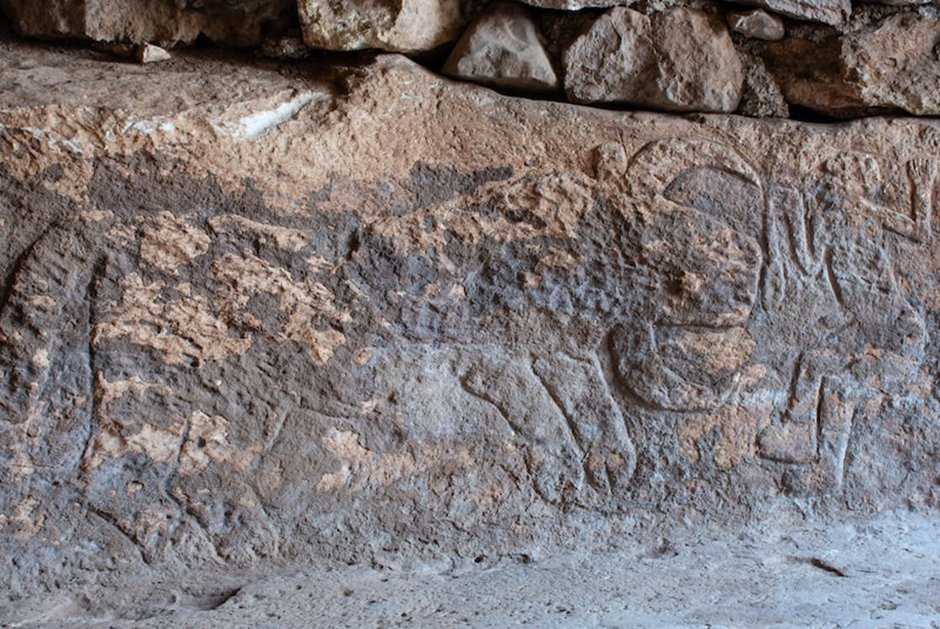
Source: The Sayburç relief detail of the left image, the man and the bull. https://arkeonews.net/a-relief-of-a-man-holding-his-phallus-was-found-in-sayburc-one-of-the-tas-tepeler/
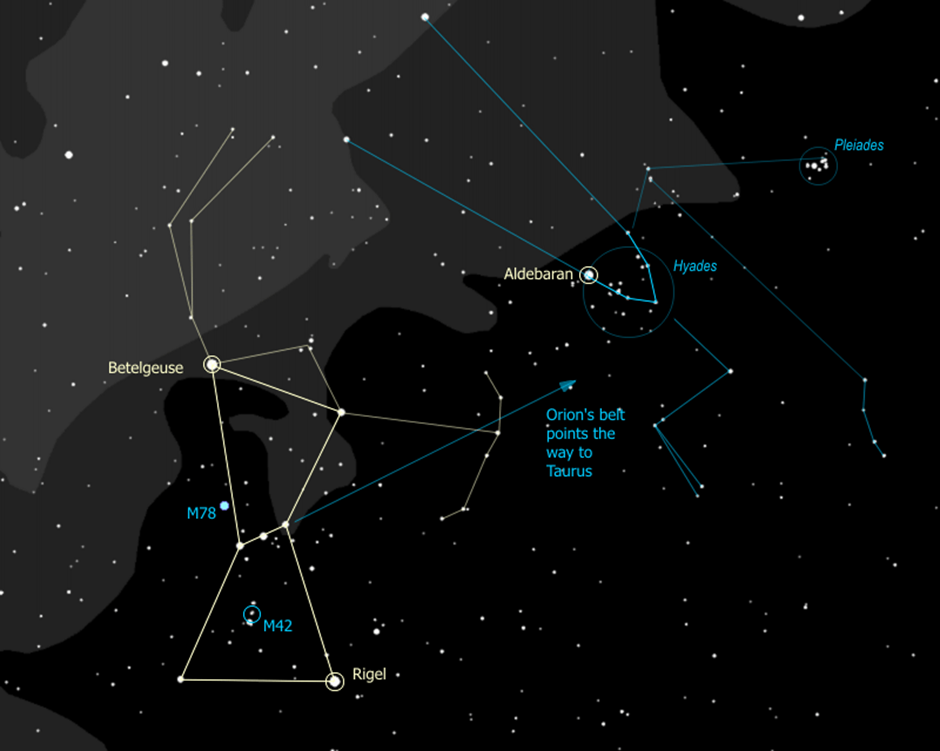
Source: The Orion constellation. http://www.rocketmime.com/astronomy/Winter/OrionTaurus.html
The Sayburç relief has not yet been officially identified or understood. The author of this paper states it’s the Orion constellation on one side and a depiction of the master of the animals relief on the other side.
Another relief that is not officially identified is the rock relief at the Aslantaş valley / “Göynüş” Valley, “Aslantaş” and “Yılantaş” Lions Rock”Afyonkarahisar” / Turkey. It has thus far not been identified or explicitly named as yet. The author of this paper asserts that both are a version of the master of the animals motive, the rock relief missing its head. This iconography is common in this era and more often used in the Anatolian civilization.

Rock relief in the Aslantaş valley, the master of the animals. Source: Wikipedia https://upload.wikimedia.org/wikipedia/commons/2/2d/Aslanta%C5%9F.jpg
The rock relief at the Aslantaş valley has not been previously identified with the master of the animals symbolism (https://en.wikipedia.org/wiki/Master_of_Animals), but is very clear, including the hole, if one compares it to this particular image of a Luristan bronze horse bit cheekpiece with “Master of Animals” motif, from about 700 BC. The horns are of particular mention as this is sometimes how he is depicted. The bullman, since its close to Orion.

An important clue in this particular image here that he is standing on “hares”, in a similar fashion to the Hittite double eagle clutching a pair of hares. More on this later.
The master of the animals is the constellation of Orion and identifies the Sayburç relief as the indus iconography “master of the animals”.
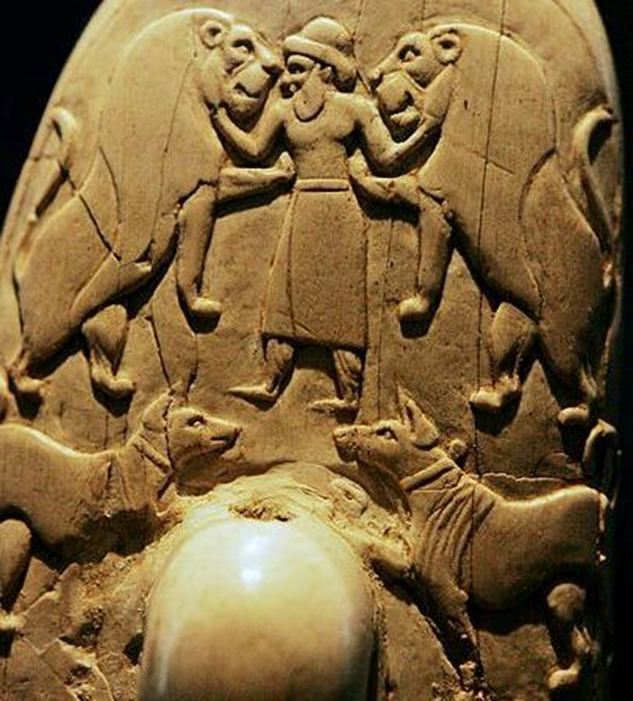
Gebel el-Arak Knife (c. 3300-3200 BC). Naqada II, Egypt The two dogs relating to Canis Major and Canis Minor

Almost indentical image of the bull relief from the indus valley.
“Gilgamesh seal 2500-1500bc)Source: https://upload.wikimedia.org/wikipedia/commons/1/1e/Indus_valley_civilization_%22Gilgamesh%22_seal_%282500-1500_BC%29.jpg
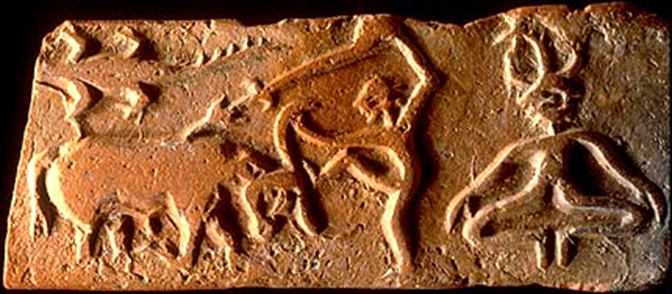
Note that the master of the animals is here in Yogi shape. The iconography of Sayburç is near identical to the iconography found in the indus valley, especially when one looks at the left figure charging the bull. The image found at Sayburç is a combination of two expressions/versions of the master of the animals motive, one being a horned figure (in a meditation state) and the other one the one clutching a pair of felines. If one knows these two expressions, the Sayburç relief can be identified as an identical expression to the Indus valley motive.
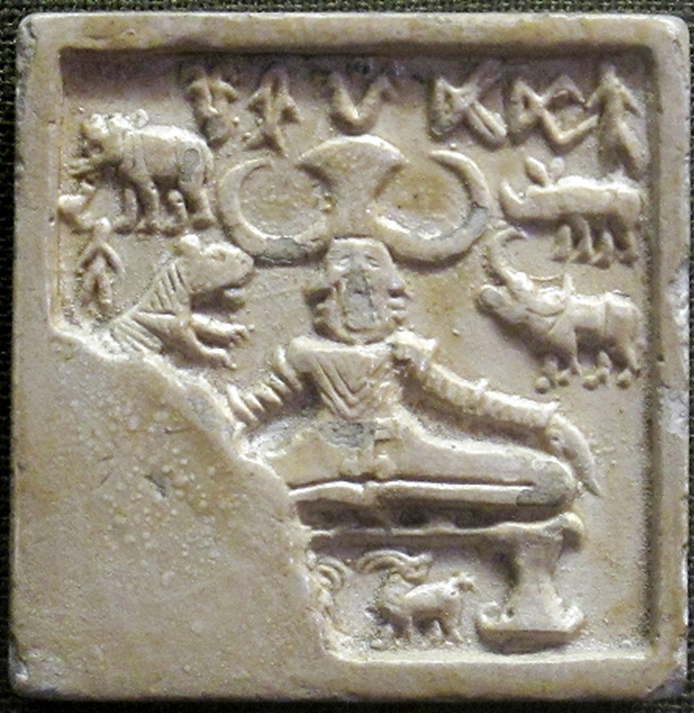
Pashupati seal. Source: Wikipedia https://en.wikipedia.org/wiki/Pashupati_seal
It had been claimed that it is one of the earliest depictions of the Hindu god Shiva—”Pashupati” (Lord of animals) being one of his epithets, or a “proto-Shiva” deity. As mentioned before, shiva itself has direct relations again to the orion constellation as Shiva Nataraja. (Source: https://www.chidambaramhiddentreasure.com/orion-chidambaram/)
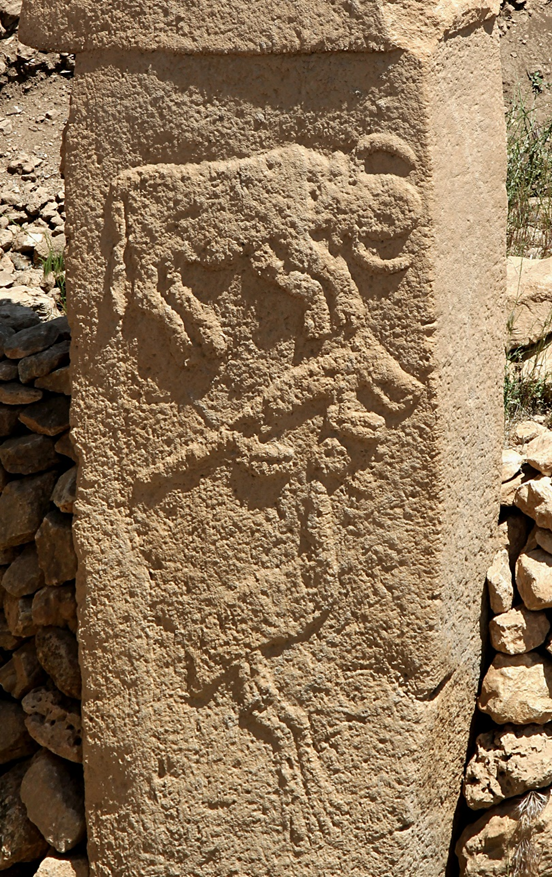
It is interesting to note, without drawing any conclusions, that the image of the bull at Gobleki Tepe follows a similar perspective / head design. Source: https://en.m.wikipedia.org/wiki/File:Reliefs_of_animals,_G%C3%B6bekli_Tepe_Layer_III,_circa_9000_BCE.jpg
These links can be further corroborated by other depictions/versions of the master of the animals motif in Anatolia and the Indus valley in the form of a bird headed figure clutching a pair of felines, its is a second variant of the same figure yet now the bird aspect, related to the constellation of Lepus below it, is emphasized.
Now this is where we go into strange territory, as, the Anatolian civilization is currently dated at 9000BC, whilst the Indus civilization is dated at 3000bc. The “master of the animals motif could not possibly have survived for 6000 years, so is there a dating discrepancy? Clearly we see similar symbolism. I will keep this open without making any assumptions.
The iconography of a bird headed figure, the third version of the master of the animals figure, the one with a bird head, clutching the pair of lions can also be found in other places in Anatolia.
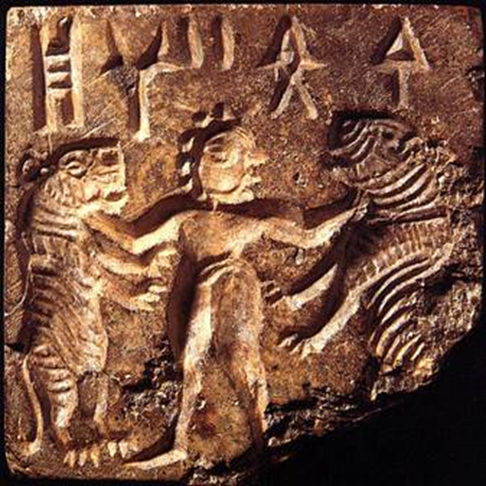
Bird headed deity wrestling felines, Harappa. https://www.harappa.com/blog/deity-fighting-two-tigers-seal
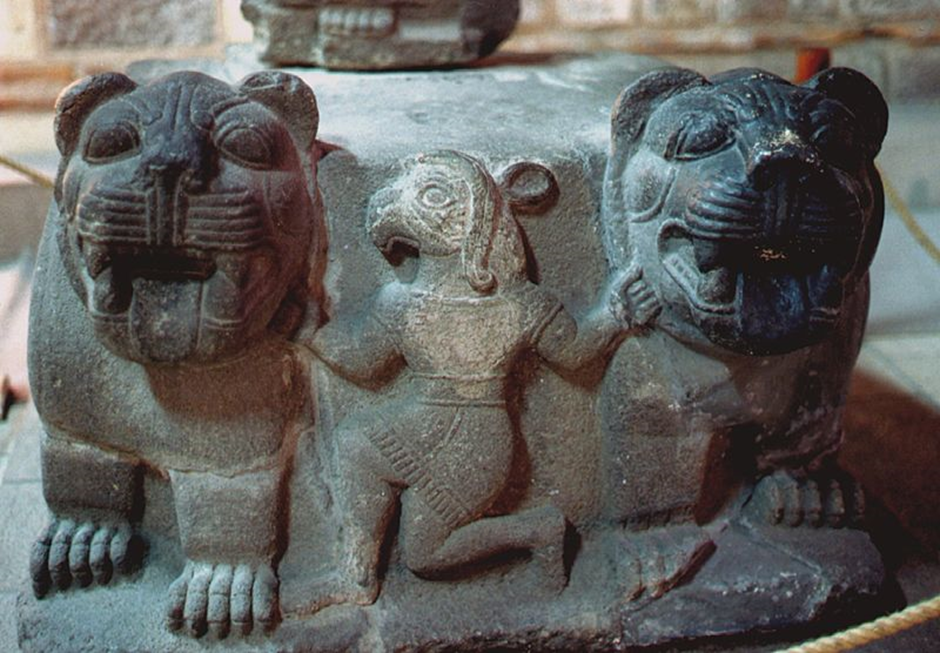
Source: Wikipedia, museum late 9th century BC. Museum of Anatolian Civilizations, Ankara. https://commons.wikimedia.org/wiki/File:Hittite_relief,_demon_between_two_lions,_9th_century_BC,_MACA,_3091.jpg
Above is the second relation between the Indus valley iconography and that of Anatolia.
The reason why it’s a bird headed figure is because it relates to the constellation of Orion. In Babylonian times, the constellation Lepus underneath was a rooster. Hence the combination of these two figures creates the “bird man”. The author asserts that that is also the reason for the bird figures flanking the tree of life in Assyrian iconography and likely that of Abraxas. He is a composite figure, much like the Chimera is, representing different parts of the Zodiac. Namely, the Orion side (rooster) and the snake gods underworld / medusa side. To top it of he is shown with a wip and a sun, the wip also being the tool used for “the charioteer of the sungod.” As one can see the bird headed deity is used across many cultures and this is its reason.
It is noteworthy that the original name “Abraxas” and “Mithras” in gematria both equal 365. the number of the solar year.
Quote: “The Gnostics equated the two holy names Abraxas (ʾΑβράξας) and Mithras (Μίθρας) on the basis of the equivalent numerical value of their letters (365, corresponding to the days of the solar year). Its use was apparently introduced in Israel during the time of the Second Temple, even in the Temple itself, with Greek letters being used to indicate numbers (Shek. 3:2).” Source: https://www.jewishvirtuallibrary.org/gematria-2
This “365 detail” also is present on the temple of Chichen Itza 4×92 + 1 steps.
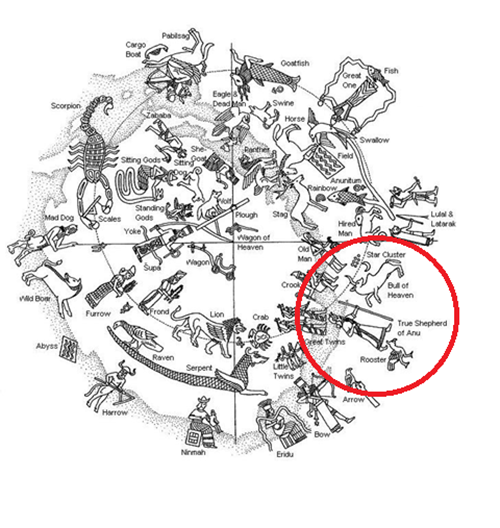


Image from the book, Babylonian Star lore, Gavin white, pointing out the old constellation of Lepus as a rooster/bird. https://www.amazon.com/Babylonian-Star-Lore-Illustrated-Star-Lore-Constellations/dp/0955903742
Abrasax: https://www.quora.com/What-were-the-powers-and-abilities-of-Helios-in-Greek-mythology
Typhon: https://mythopedia.com/topics/typhoeus
The figure Abrasax has been demonized by the church. But in fact its not a demon at all. Its a composite figure as symbol for the 365 year solar year. Combining elements of the top of the zodiac, the rooster and the bottom of the zodiac, the demon/snake symbolism, like the anguiped Typhon and also sometimes the snake or fish legged mermaid/Melusine.
Mythology as a partial symbol of Virgo (when she was in the underworld, the medusa aspect of Virgo) This Melusine has made it all the way to our times via Medusa. https://en.wikipedia.org/wiki/Melusine who also resides in the underworld.

There are clear cultural links between this civilization and that of the Indus valley iconography, which is not surprising as they are close and the master of the animals motive, Orion, was revered in ancient times in many forms, yet both these assertions explaining these two reliefs AND the clear links to the Indus valley civilization first time mentioned here.
Later the constellation of the rooster/bird, became a hare, that is found in the myth of the goddess Ostara and the origins of our easter bunny with eggs. For this reason we see the lurian iconography clutching the hares.
Symbolic Details of Jesus
- Jesus and the donkey(s)

Image: Jesus in the Triumphal Procession. Image Credit: St. JoseMaria Institute
Matthew 21:7, which is interpreted to mean that Matthew has Jesus. sitting on two animals: ‘they brought the ass and the foal to him and. they placed the garments upon them (the two animals) and he sat upon. them (the two animals)’
This Donkey and the foal, also has its origins in the stars, it refers to the constellation of Cancer as the summer solstice constellation and in particularly to two stars in it. Namely, Delta Cancri Aa (formally named Asellus Australis, the traditional name of the entire system [6 and Asellus Borealis or Gamma Cancris[14
- Born in a crib, in stable, between an ox and a donkey
Delta Cancri also marks the famous open star cluster Praesepe (or the Beehive Cluster, also known as Messier 44) The beehive, a well known masonic and Mormon symbol. It is on rosslyn chappel and on the church of the latter day saints.

Beehives on the doorknobs of the Salt Lake Temple of the church of the latter day saints, with a palmette and beehive symbolism, a reference to the summer solstice. Source: https://exponentii.org/blog/november-2012-visiting-teaching-message-teachers-choice-from-conference/
The Beehive Cluster (also known as Praesepe (Latin for “manger” or “crib”), M44, NGC 2632, or Cr 189), is an open cluster in the constellation Cancer.
This is where the crib/manger comes from. The Ox and the donkey, refer to Taurus and Cancer respectively. The bright star of Bethlehem Sirius and the 3 kings a nod to the belt stars of Orion. It is noteworthy though that there is no reference in the bible to Jesus being born in a manger, this is lore that came from outside of the written scriptures and is accepted as current iconography by people placing such models under the Christmas trees. There is however clear symbolism in these and star references.

Image: The stable of Jesus. Manger, Crib, Ox, Ass, Maria. https://www.amazon.com/Nativity-Painting-Picture-Decoration-24x32inch-No/dp/B0957VRZQ9?th=1
- Jesus had 12 apostles
This is a reference to the 12 constellations. 12 months in a year. Indeed, Hercules had 12 labours. This relates directly to the 12 zodiac signs and him being the constellation of Orion. The 12 labors of Hercules, became the 12 apostels.

Image: Last supper, by Leonardo da Vinci. Restored image. As per the fresco in the Santa Maria delle Grazie, Milan.
Source: https://commons.wikimedia.org/wiki/File:The-Last-Supper-Restored-Da-Vinci_32x16.jpg
The 12 apostels are the 12 constellations and Jesus, the constellation of Orion at spring.
He sits in the middle, six each side, but they are grouped in sets of 3, 3 months per season. The void on the left of Jesus represents the milkyway in the authors view.
4 table posts for the 4 seasons. 4 evengelist as mentioned earlier. Two heads on the table representing the summer and winter solstice respectively. Why, because Leonardo da Vinci used the universal symbolism of the 3 doors. A larger middle door and two smaller side doors, the triptych, as seen in many church entrances as well. These have a special meaning. It represents the position of the sun on the horizon over the season, were the left door is the winter solstice, the middle door the spring/autumn equinox and the right door the summer solstice. One apostel pointing upwards as a further clue that the answers are up. Leonardo knew very well what the Jezus story was about and what he was painting.

Image: This illustration from the Chicago Tribune – related to an article on Chicagohenge – shows someone looking toward sunrise.

Image: Notre Dame Façade, like many churches featuring the triptych door assembly and in this case also the sun/ rosette window over the middle “equinox door” This is seen in many temples worldwide.
Source: https://upload.wikimedia.org/wikipedia/commons/a/af/Notre-Dame_de_Paris_2013-07-24.jpg

Image: The image of Angkor is identical symbolism to the Notre dame, or the triumphal arches. It’s the sun moving over the seasons. The sunrise on Angkor Wat during the equinox is such that someone standing in front of the western entrance on the equinox is able to see the sun rising directly over the central lotus tower. Image : https://www.khmertimeskh.com/501255614/angkor-wat-voted-worlds-best-sunrise/
Rulers, royalty and symbolism of astronomy and god
The 3 doors or 3 towers symbolism, also called the Tryptich, with its astronomical meaning, was not first used in medieval churches or temples, but has started possibly in Egypt, but definetely with emperors triumph arches. It was an attempt of the emperors to equate their presence on earth as the son of god, or to be the god on earth. The sungod was portrayed as a person in a quadriga allways accompanied by a pair of twins or two sons. This practice of a ruler equating themselves with god was not new and happened in Egypt where the Pharao linked himself to Osiris or even in the middle east as Teshub, Baal, hadad and others. All these rules equated themselves with the sungod or Orion. The particular design of the triumphal arch follows clear elements due to its underlying astronomical meaning highlighted allready here above.

Image: The Arc de Triomphe du Carrousel is a triumphal arch in Paris, located in the Place du Carrousel. It is an example of Corinthian style architecture. It was built between 1806 and 1808 to commemorate Napoleon’s military victories of the previous year. Note the two golden horse tamers. Source: https://en.wikipedia.org/wiki/Arc_de_Triomphe_du_Carrousel
The above design for Napoleon, another emperor, depicts the classical arch design with the distinct 3 doors seen in many temples and churches in all its glory. Horses of Saint Mark statues on the Arc de Triomphe du Carrousel in Paris. Now here is where its becoming obvious. It is showing the sun chariot with the two horse tamer twin sons (Ashvins) on the sides, just like the Vedic depictions of the same.
Arc de Triomphe du Carrousel
The Arc de Triomphe du Carrousel is a perfect example of a revival roman Triumph arch. Again, Its fully astronomical in its nature. It has the 3 doors, explained before. The 4 pillars represent the 4 seasons. The solar hero on top with its quadriga with his 4 horses. (The 4 horses, allways a reference to the 4 seasons, even the 4 horses of the apocalypse.) Lastly the two Dioscuri or Hero twins representing the two halves of the Zodiac. Not only in western mythology, but just as much in the Maya mythology of the Hero twins, or, in the Indian story about the Ashvini.
The Marble Arch
The marble arch was first intended to be a grand entrance to Buckingham palace. A place that would fit with its symbolism. Buckingham palace was beautifull in 1837 before they build the east wing, its current front. On the image here below we see the marble arch as the entrance to the palace, although in its incompleted state. (See later intended designs)
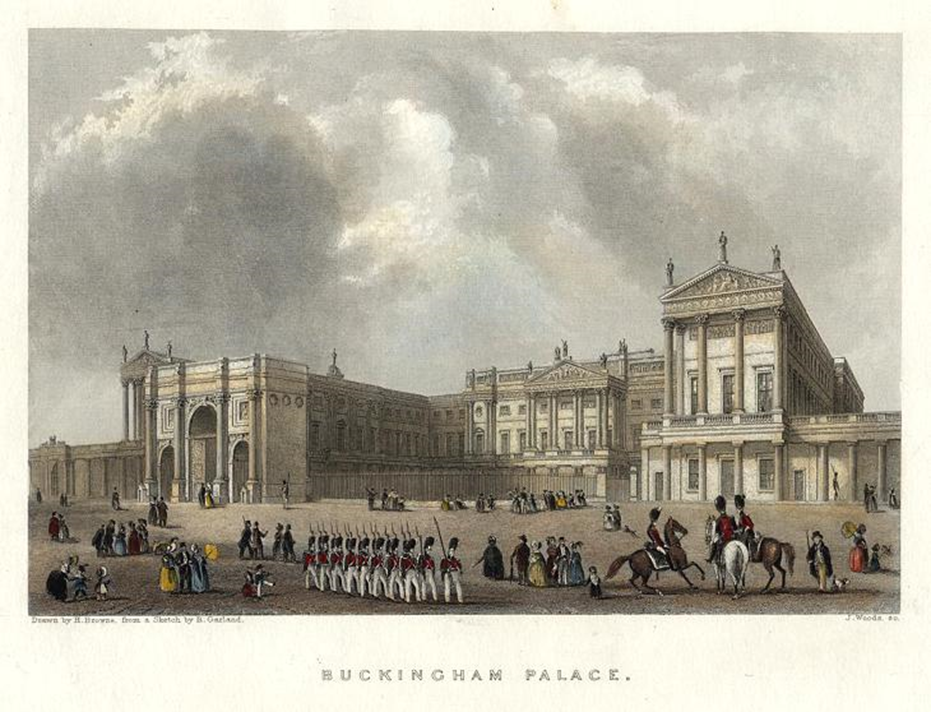
Image: “The Queen’s Palace, Pimlico, Middlesex” (Buckingham Palace) published in Dugdale’s England and Wales Delineated, about 1845. Steel engraved antique print with recent hand colour, good condition. Size 11 x 8 cms including title, plus margins. Ref H8417 Source: http://www.antiqueprints.com/proddetail.php?prod=h8417
On building of the east wing, most of this grand appeal of neo roman design got lost in favour of a plain straight façade. However they did keep true to some of the original design queues. Its distinct triple “doors” of that arch (and overal 3 design), with reference to the sungod are incorporated in that design, still, the palace lost much of its former grandeur.
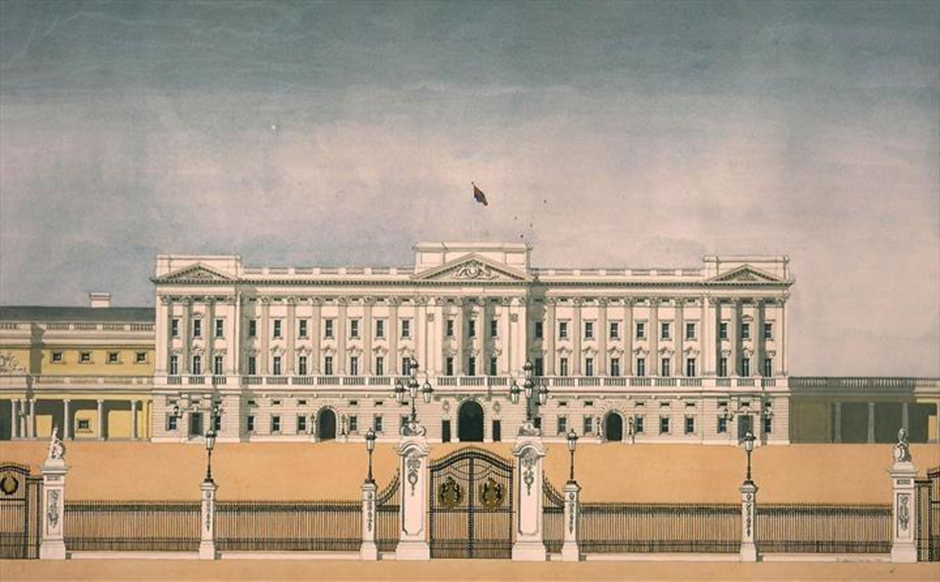
Image: Currrent façade of Buckingham palace since 1845. Note the distinct tree doors of the original marble arch still incorporated in its design.
Source: https://www.theprintsgallery.com/products/buckingham-palace
These days, a statue to victoria (or nike/victoria) the charioteer of Zeus stands in front, still honouring the symbolism we see on many palaces and the usual preferred statue on the triumphal arches as Zeus charioteer as can be seen in this paper, hence for those who understand this symbolism it clearly still shows.
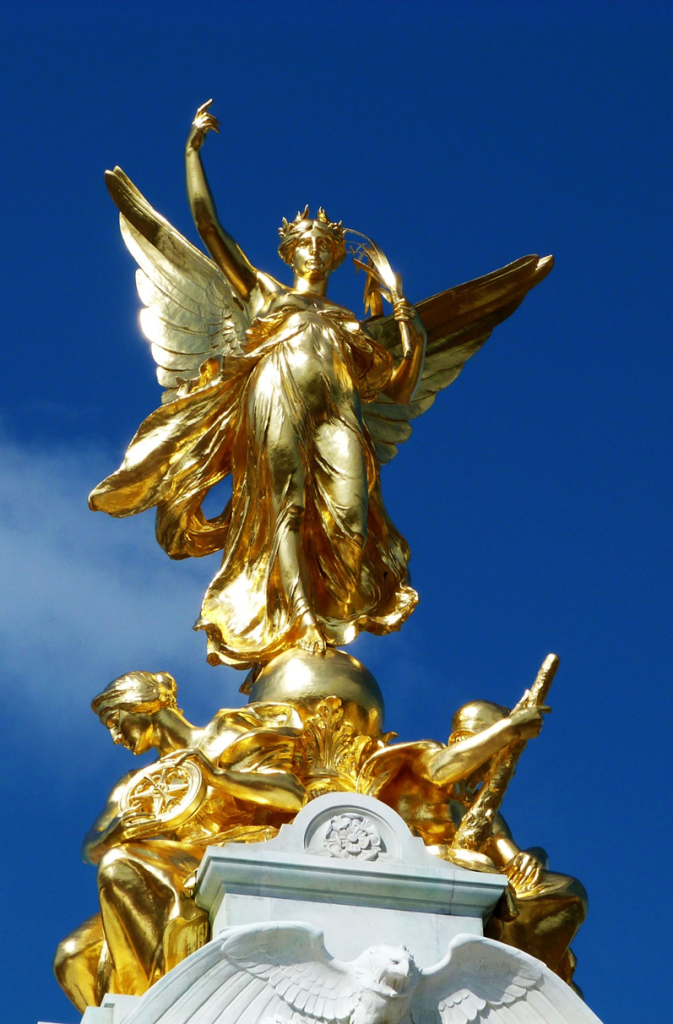

Images: Victoria in front of Buckingham palace, just like on many other palaces, government buildings.
Source: https://en.wikipedia.org/wiki/Victoria_Memorial,_London
Image: Marble arch London
Source: https://upload.wikimedia.org/wikipedia/commons/f/f5/Marble_Arch_%2829797251968%29.jpg

The story on marble arch is a very interesting one, as due to fund limitations its not even close to its intended design. The original design was beautiful. Instead of the sungod in the middle it showed a head of Leo for the summer solstice. Then on top it showed Brittania, (or Durga/virgo) and the king on a horse for the male sungod, very similar to the equestrian Statue of Marcus Aurelius on capitolone hill in Rome, which there is again flanked by the disocuri or horse twins, still perfectly in line with the “normal symbolism” for an arch that is topped by the central god and his two sons.
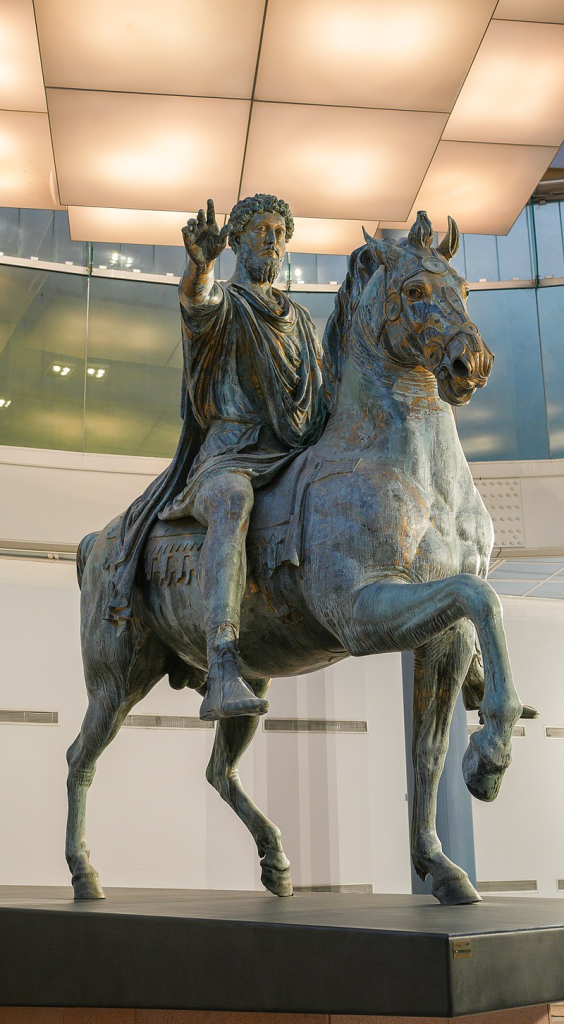
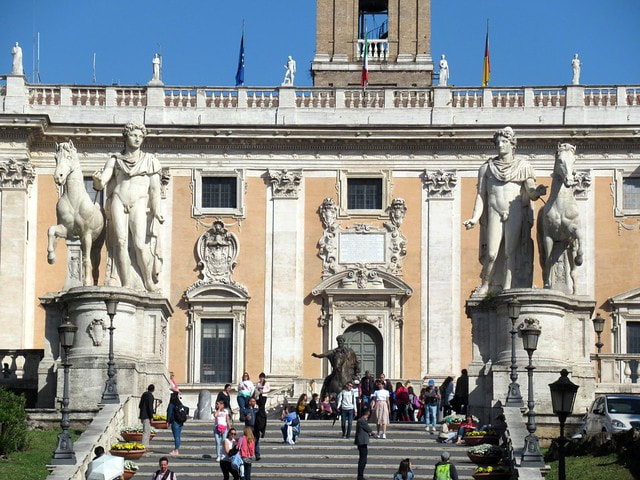
Images The statue of Marcus Aurelius and castor and pollux, Piazza del Campidoglio, Rome.
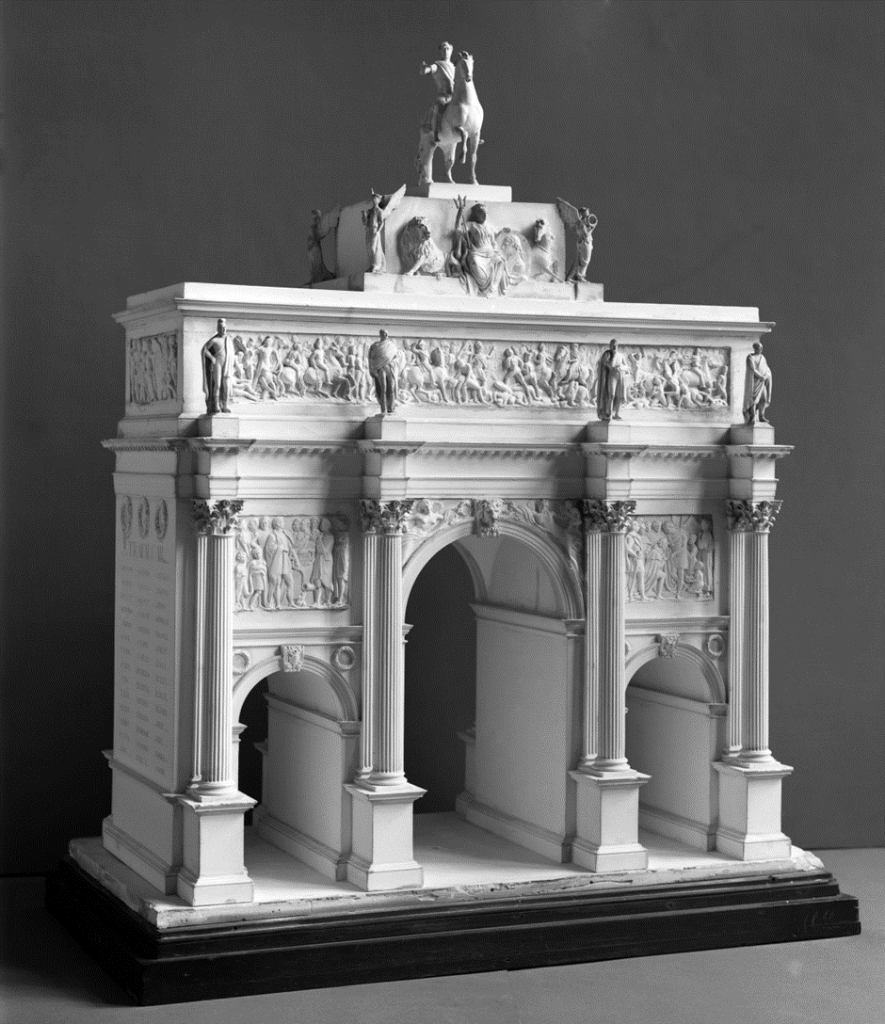
Image: Original Marble arch design. Architectural model of Marble Arch circa 1826 (front) © Victoria and Albert Museum. The lion instead of Zeus is on the original design, for Leo, mid summer. The victory angels on the side. The (sun) king on top on his horse, with below him the female Brittania or Durga, consort of god with her lion symbolism.
Source: https://marble-arch.london/culture-blog/what-marble-arch-might-have-looked-like/
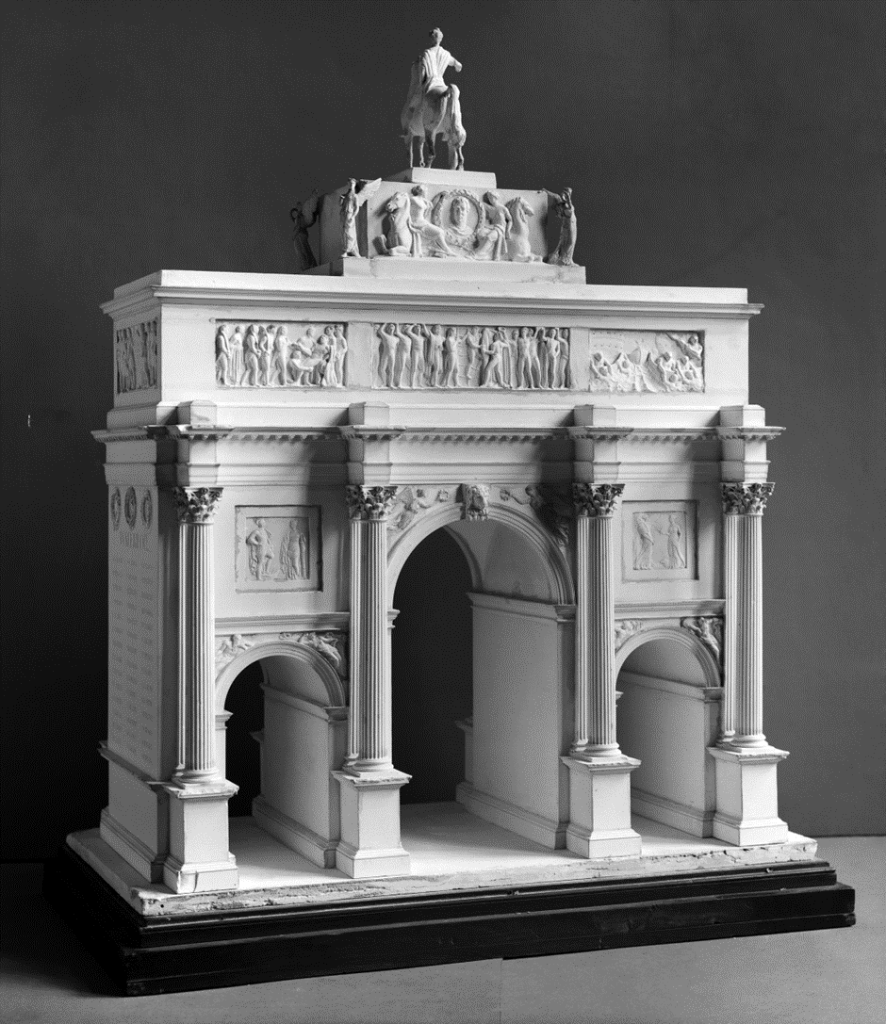
Image: Original Marble arch design. Architectural model of Marble Arch circa 1826 (rear) © Victoria and Albert Museum
Source: https://marble-arch.london/culture-blog/what-marble-arch-might-have-looked-like/
One can see the tryptich and solar symbolism allways was according to a blueprint. The original marble arch was of a grand design. The one that eventualy was build compared to it, not so much.
These arches often created as victory monuments have a distinct design copied till today in modern versions. There is an interesting story about the first triumphal arch. These arches always have the distinct “tryptich” design of a large door with two smaller doors, something seen across the world in many religious monuments as well. This has a particular reason.
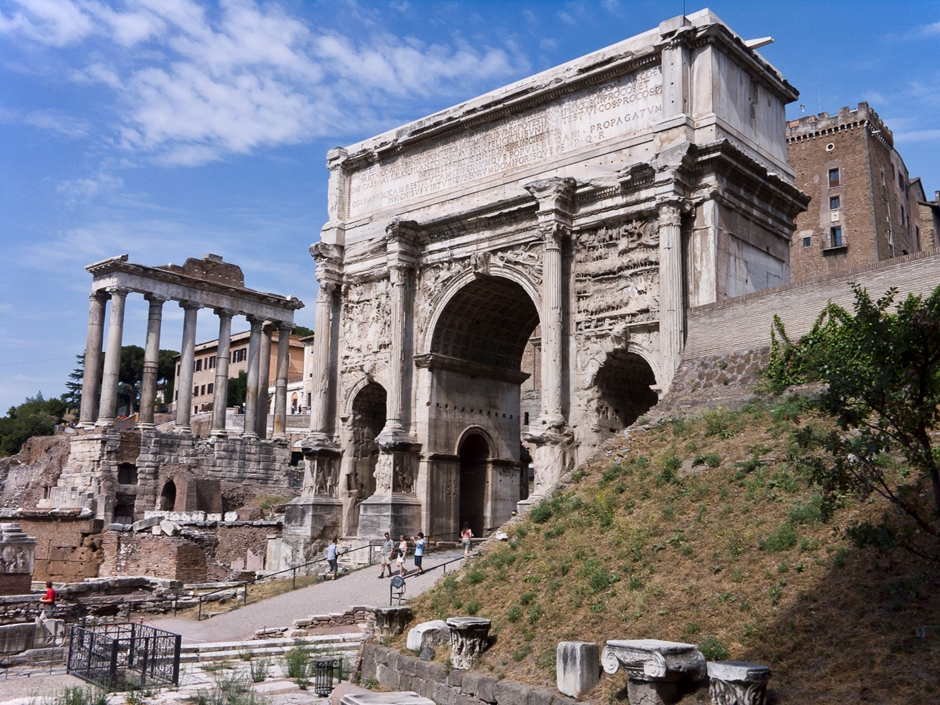
Image + Source: Quote Wikipedia: The Arch of Septimius Severus (Italian: Arco di Settimio Severo) at the northwest end of the Roman Forum is a white marble triumphal arch dedicated in 203 to commemorate the Parthian victories of Emperor Septimius Severus and his two sons, Caracalla and Geta, in the two campaigns against the Parthians of 194/195 and 197–199. After the death of Septimius Severus, his sons Caracalla and Geta were initially joint emperors. Caracalla had Geta assassinated in 212 (brothers slain each other, cain/abel); Geta’s memorials were destroyed and all images or mentions of him were removed from public buildings and monuments. Accordingly, Geta’s image and inscriptions referring to him were removed from the arch. Source: https://en.wikipedia.org/wiki/Arch_of_Septimius_Severus
The following is of particular importance for our further argument.
“A staircase in the south pier leads to the top of the monument, on which were statues of the emperor and his two sons in a four-horse chariot (quadriga), accompanied by soldiers.”
Chariot of the god and the horse tamer twins
Now this particular design element is seen on many European arches. Either a proposed single horse emperor or the charioteer Victory/Nike, the charioteer of the skygod Zeus/Jupiter

Image: Horse tamers (ashvini twins) flanking the Austrian parliament building in Vienna, Austria.
Source: https://en.wikipedia.org/wiki/Austrian_Parliament_Building#/media/File:WienParlament.jpg
The horse chariot statue (or single emperor on a horse for Revanta) on ancient buillding and triumphal arcs seen are a direct representation of Surya the sun god, or the emporer/ king as sungod on earth in his horse chariot with his twin sons. (dusk and dawn) The arch itself is the arch of heaven. However often in modern times is depicted Victoria in the horse chariot as charioteer of the sun/sky god and not the sun/sky god himself, which is why these are often in from of palaces, as the king/emporer is then the sun/skygod on earth symbolically.
There are many identical depictions across Europe and in Russia. The actual sun or sky god was omitted and only the charioteer Victory/Nike is shown in modern times. Yet she was the charioteer of the skygod.
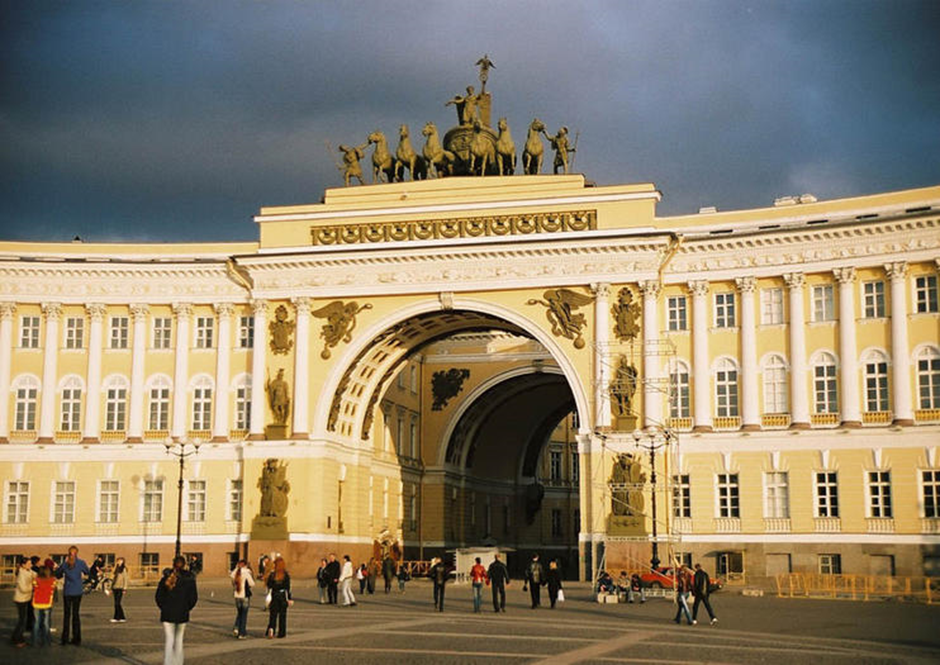
Image: St Peters palace square, st Petersburg. Showing the chariot of victory with his two horsetamer twin sons (Ashvin) on a palace entrance.
Source: https://en.wikipedia.org/wiki/Palace_Square and https://www.viator.com/St-Petersburg-attractions/St-Petersburg-Palace-Square-Dvortsovaya-Ploshchad/d908-a2964
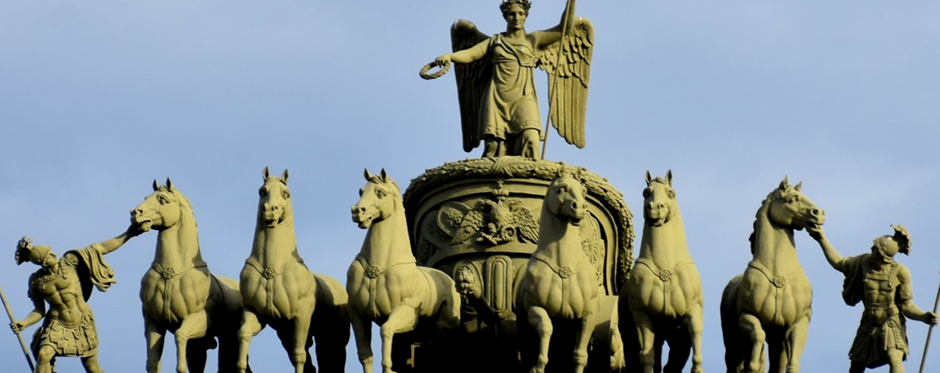
Image: St Peters palace square detail, showing the sungod in his chariot with the horse tamer suns the Ashwin. It’s a diluted image of the sky sun god Zeus in the chariot with charioteer Nike/Victoria but relates to exactly that part of mythology of the sungod and his twin sons the ashvini horse tamers.
The roman triumph was celebrated by emperors as the Sky sungod Zeus in his chariot. Her a detail from the arch of Marcus Aurelius. Bas-relief from the Arch of Marcus Aurelius, Rome, now in the Capitoline Museum in Rome.
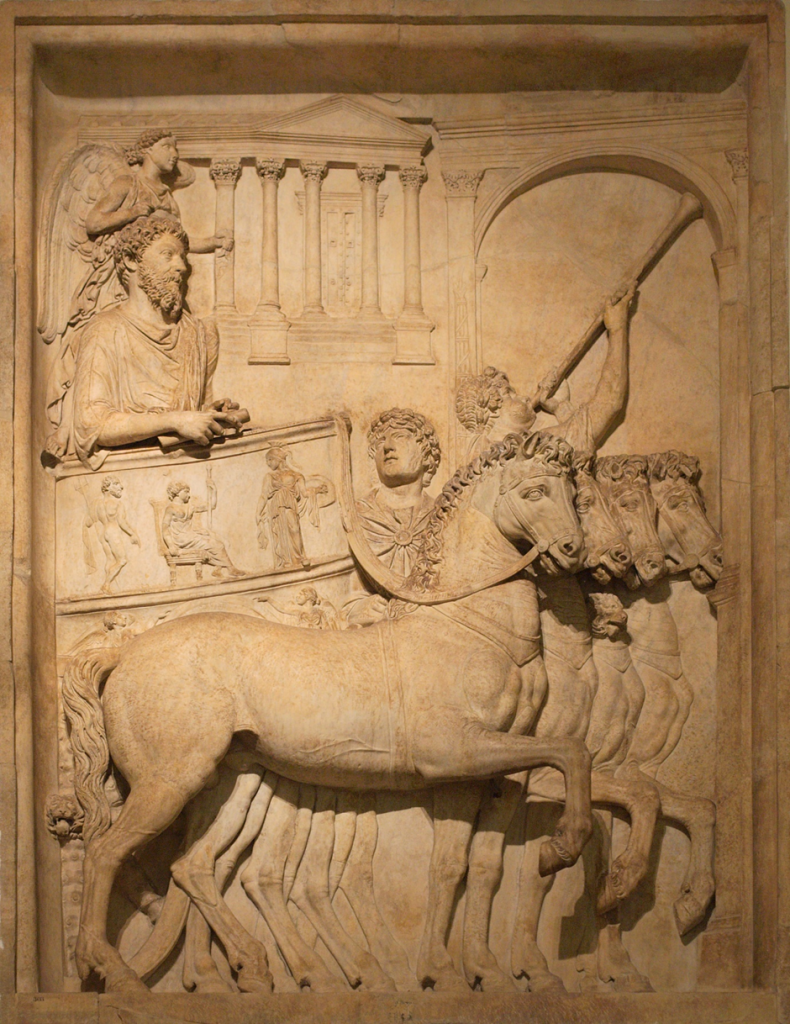
Image: Panel from a representation of a triumph of the Emperor Marcus Aurelius; a winged genius hovers above his head (this is Nike, zeus angel of victory/charioteer)
Source: https://en.wikipedia.org/wiki/Roman_triumph and https://upload.wikimedia.org/wikipedia/commons/b/b5/Bas_relief_from_Arch_of_Marcus_Aurelius_triumph_chariot.jpg
The Ashwini twins and Surya the sungod in India
Above symbology related to astronomy, has its equal in India. In fact, an indian native could think its Surya on the Triumph arches and he or she would not be wrong as there are clear links between the two.
It goes that his first wife gave birth to twins after being impregnated in the guise of a mare by the sungod who changed his form to a stallion after she fled into the forest. These twins are the Ashwini twins, which happen to be the first Nakshaastra lunar manion, in the same region as Aries. The start of the year. They are depicted as on horses or with horse heads.
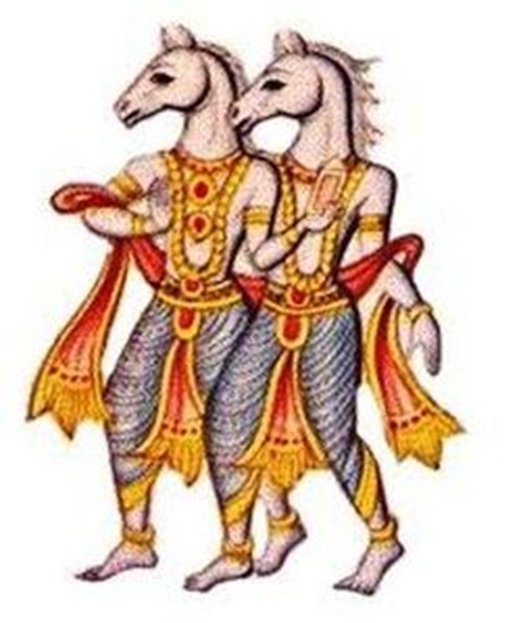
Image: The Ashwini twins in their horsehead form Ashwini Nakshastra
Source: https://www.astrosaxena.com/ashnaksh12154
The Ashwini are synonyms for sunrise and sunset, dawn/dusk and the morning and evenigstar. Revanta being brightness being the central figure sometimes replacing Surya in the triad. What is important here is the sun asocoiation, dusk and dawn and the horses. The two wifes of the sungod Surya fulfilled similar allegoric roles in that triad, where Chhaya was shadow.
The horse Chariot of the sun god Surya
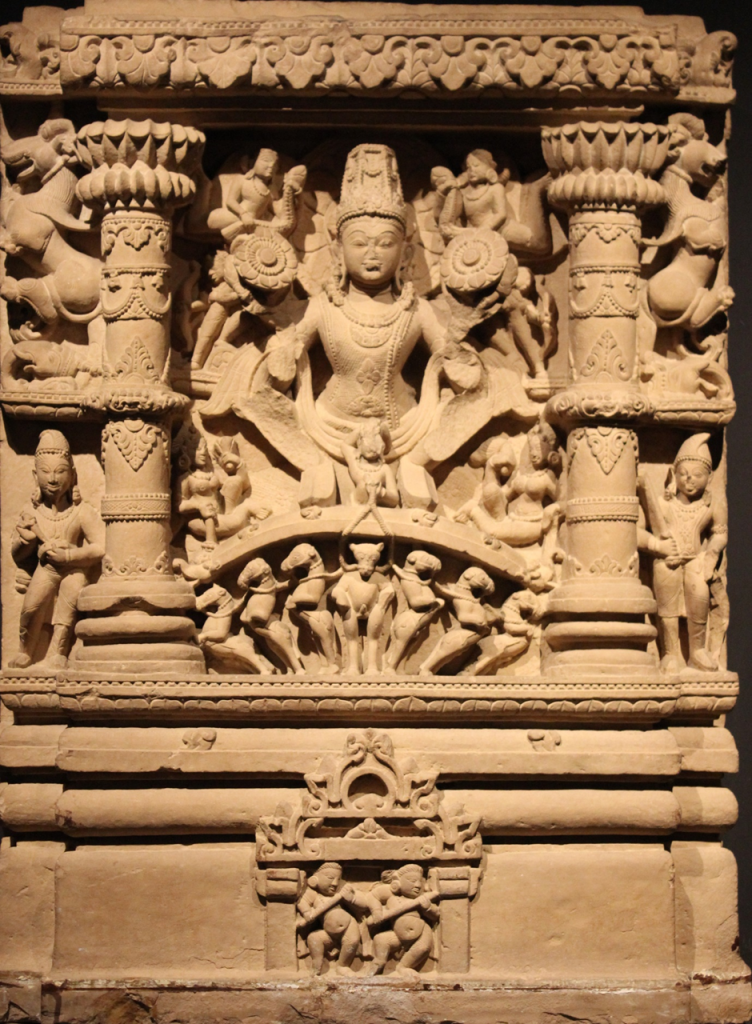
Image: Surya the sungod in his horse chariot is his often depicted form. Note: the two “masonic” pillars and compare these later to Viracocha and the Rockefeller building. Also seen here the horse twins ashvini on the side.
Source: https://upload.wikimedia.org/wikipedia/commons/e/e4/Lord_Surya.JPG
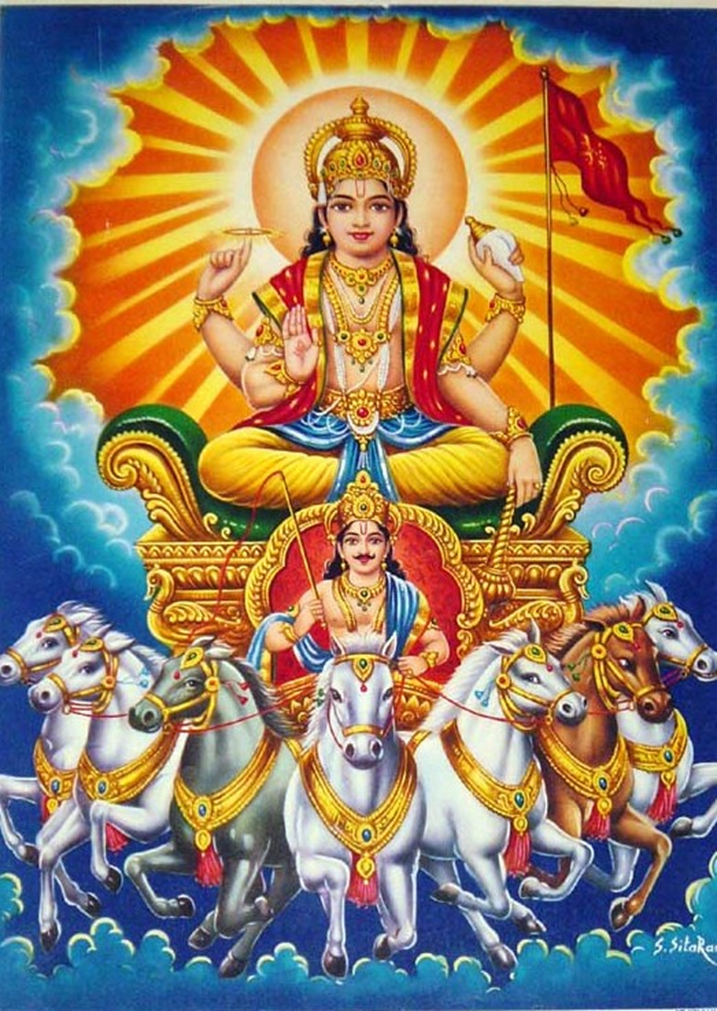
Image: Surya in his horse chariot. Note that the sungod himself, has a charioteer, Zeus had Nike. (Jupiter had Victoria, the later often shown angel of victory)
Source: https://en.wikipedia.org/wiki/Surya#/media/File:Shri_Surya_Bhagvan_bazaar_art,_c.1940’s.jpg
The 4 horses of the apocalyps
In John’s revelation the first horseman rides a white horse, carries a bow, and is given a crown as a figure of conquest, perhaps invoking pestilence, or the Antichrist. The second carries a sword and rides a red horse as the creator of (civil) war, conflict, and strife. The third, a food merchant, rides a black horse symbolizing famine and carries the scales. The fourth and final horse is pale, upon it rides Death, accompanied by Hades. “They were given authority over a quarter of the Earth, to kill with sword, famine and plague, and by means of the beasts of the Earth.” https://en.wikipedia.org/wiki/Four_Horsemen_of_the_Apocalypse
The quarter of the earth reference, most likely refers to the winter season, the underworld, which was asociated with war, hunger, death etc. It is important that John writes about this as he is in the region of scorpio, the underworld, his sign being Aquila the eagle, as they could not give an evangelist the sign of scorpion.
The tale of the two brothers, sons of the sky(god)
Besides the Dioscuri or Ashvins (in india), the horse twins “flanking the central skygod” on triumphal arcs and government buildings the two brothers appear in many other forms througout history.
The story of the two brothers or twin brothers Apollo, the two brothers, one “slaying another” in a cain and able setting, or, the Holy and the Oak king where one hands his crown to the other in a spring/summer vs autumn/winter king is a recurring theme used differetlty in many cultures.



So what is a possible explanation. There are a few candidates:
- On a year scale, (ophiucius) and Hercules (Orion) in te zodiac, changing places in the sky as the seasons pass.
- On a day scale, the night and day, or consequently, the moon and the sun, the twin “children of the sky”.
It is noteworthy here that ophiucius was identified with the god of war and underworld, later apollo and Nergal “the devil”. That was the underworld portion of the sky. Lucifer or Satan was also identified with the morningstar, which, had a twin, the evening star. These where usualy depicted as two males with torches, one up and one down, to indicate dawn and dusk. But they also depict Apollo (Ophiucius) and Hercules (Orion) or Evil and Good. Wargod vs Fertility in a zodiac space. They also appear on the Mithras scene as mentioned further below.
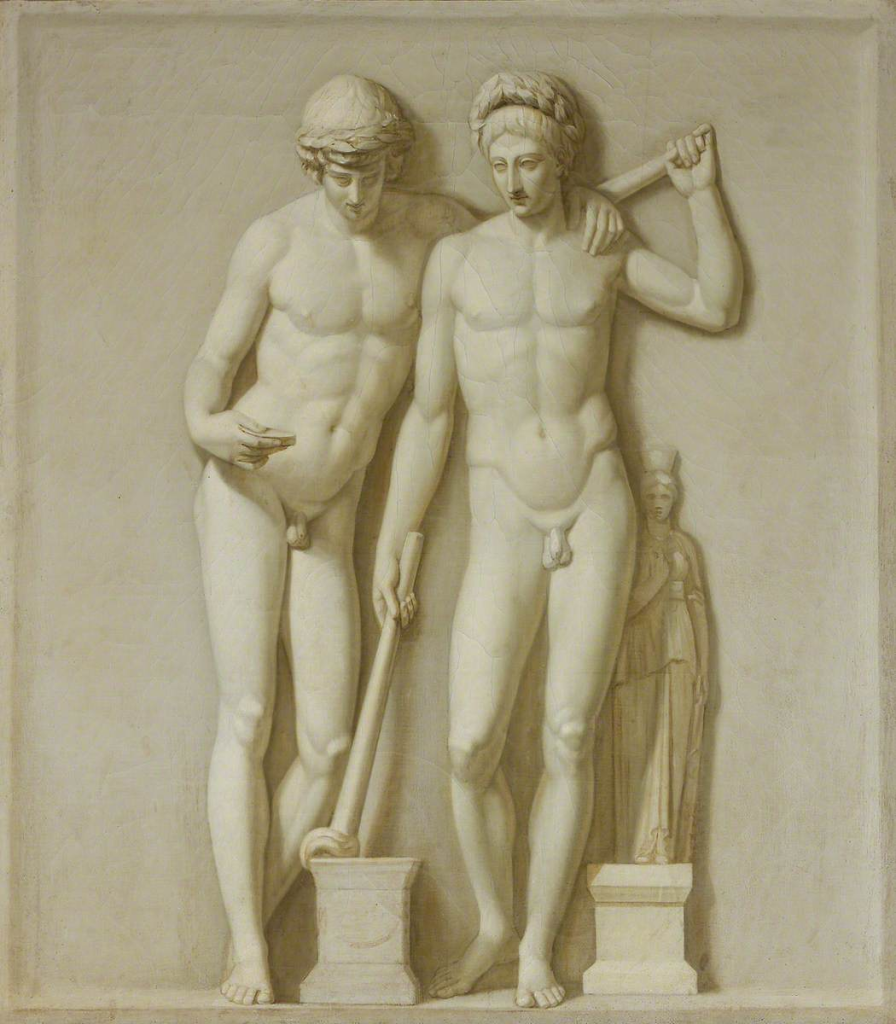
Image: Castor and Pollux, Torch up and Torch down. https://en.wikipedia.org/wiki/Castor_and_Pollux#/media/File:Dioskouroi_Met_L.2008.18.1-2_n03.jpg
- Public Domain
- File:Robert Fagan (1761-1816) – Castor and Pollux – 609090 – National Trust.jpg
- Created: between 1793 and 1795date QS:P,+1793-00-00T00:00:00Z/8,P1319,+1793-00-00T00:00:00Z/9,P1326,+1795-00-00T00:00:00Z/9
Therefor Orion, with his club is the original “torch bearer” or “Tedoforo” in italian This phenomenon is celestial in nature. It happends when the sun passes of Orions club.

The twins, day and year cycle
The story of the twin brothers reflects on the day cycle in the morning and evening star and the year cycles where Hercules battles the Hydra in the same region where Opiucius (apollo) is. They both occur as their own constellation, Gemini. It was probably known to ancient astronomical mapmakers that Ophiucius was Apollo, because even in the Gemini constellation depiction it is very clear that its Hercules and Apollo looking at their attributes.

Image: Sophisticated Gemini constellation star map from 1820 drawn by A. Jamieson. The map was first published in 1822 in London. Gemini constellation https://exiarts.com/products/gemini-zodiac-star-print-antique-star-map-professional-reproduction-of-the-constellation-gemini-wall-art-zodiac-astrology-celestial-map
The twins in Mithraism
The twins also appear in the Mithraism “religion”. No suprise here as Mithraism is also, laced with and has its origins in, astronomy. The man killing the bull, the scorpion, dog and snake biting the testikels (fertility, opposite of zodiac) is all astronomy as perfectly explained by David Ulansey:

The Origins of the Mithraic Mysteries: Cosmology and Salvation in the Ancient World
David Ulansey, 1989
The Origins of the Mithraic Mysteries: Cosmology and Salvation in the Ancient World
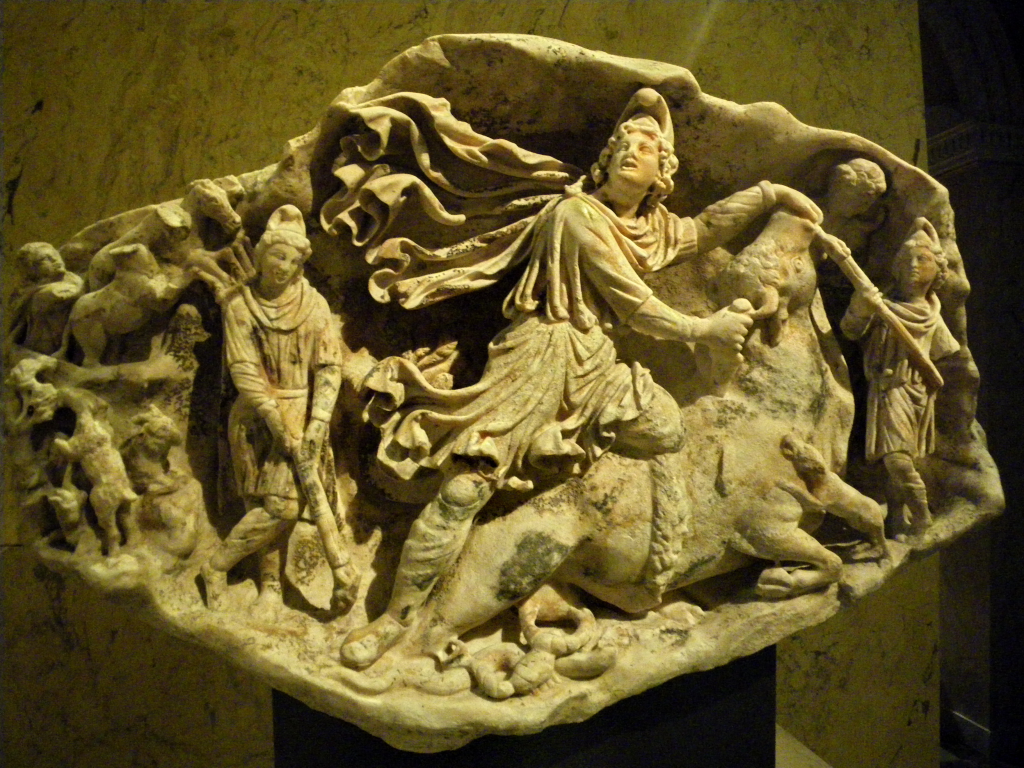
Image: More details A Roman tauroctony relief from Aquileia (c. 175 CE; Kunsthistorisches Museum, Vienna)
Source: https://upload.wikimedia.org/wikipedia/commons/5/5c/KunsthistorischesMuseumMithrabulSacrifice.jpg
Take particular note of the symbolism of the two brothers one with torch up and one with torch down. Dawn and Dusk, evening and morning star or in the macro cosmos. the two opposites of the zodiac, Orion and Ophiucius. The two brothers where “one kills another” (Cain and Able, Appollo vs Hercules) as they swap places in the sky during the seasons.
The opposites of the zodiac and the equinoxes and solstices
Like Apollo vs Hercules, Cain vs Able, the theme of the hero vs the snake or devil is seen not only in many heros vs the snake/dragon, but also in Archangel Michael vs Satan The french version is St. Michel. He fights the 7 headed dragon, which was, a symbol of evil. All this is syncretized astronomy. The archangel Michael has been equated with Horus, which is Orion, the spring equinox. But in fact he is Libra, the then autumn equinox, which is also, equal light and darkness, like spring. So when Jesus is the spring equinox, his seasonal counterpart is also a good person, being Archangel Michael. He then “fights” the winter solstice, which is, the devil. Archangel St, Michael is just another example in the bible that is astronomy. This came from Egypt where in the underwolrd the scales where Anubis(Ophiucius) and Horus(orisis)/Orion as zodiacal opposites, weigh the hart vs Maats feather. Libra means balance. Balance of the light in the autumnal equinox.



One can ignore the symbolism the sword and the scales of Archangel St. Michael and argue that Libra was a women but this old statue of the god phanes, depicted Libra as a man.

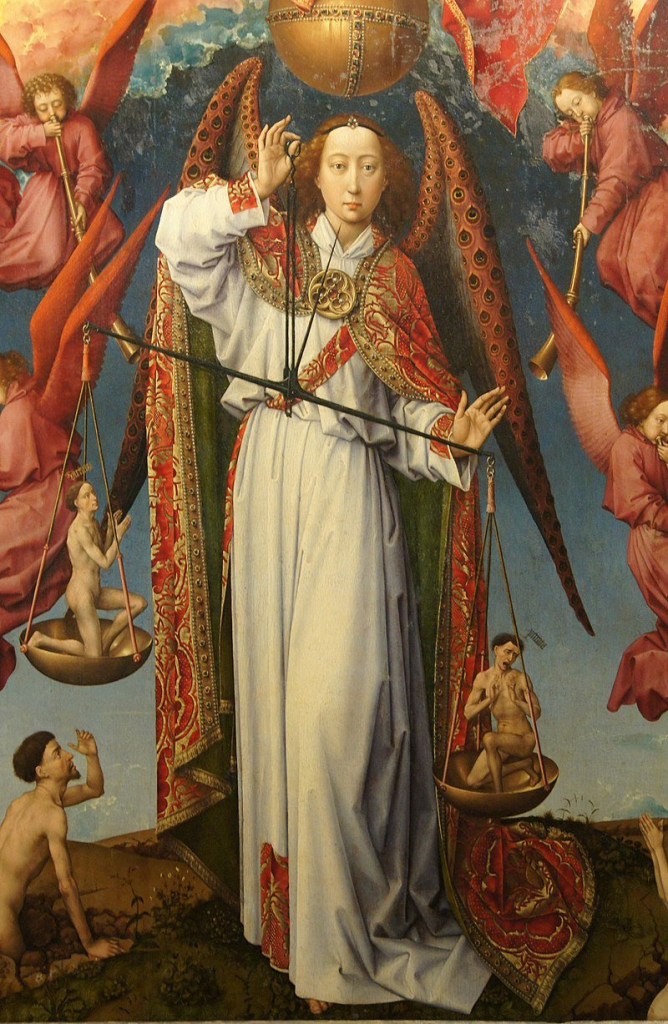
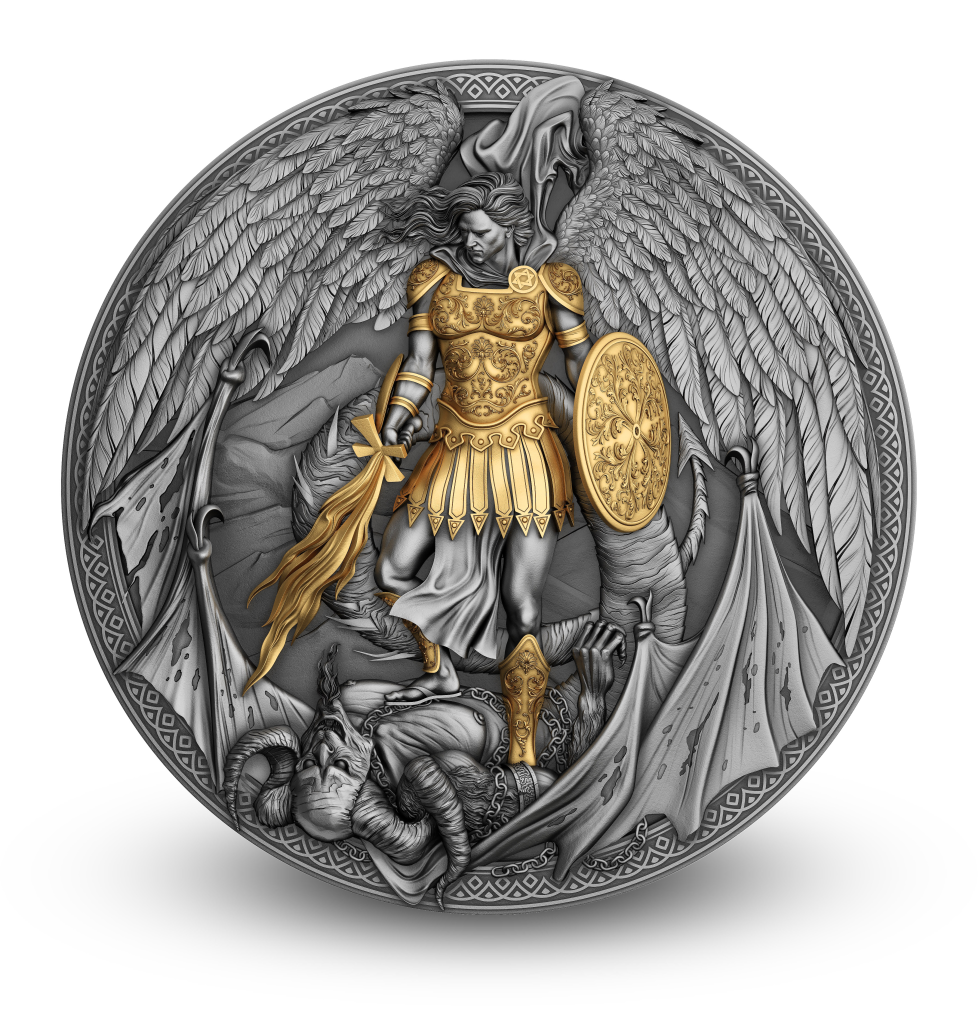
Images:
Phanes as a central deity seems to the author a composite image of the zodiac signs/seasons. The hooves of capricorns, the devil/winter, the snake of ophiucius, the ram head horns of the autumn equinox Aries. Its noteworthy that now the spring equinox is Pisces due to the precession of the equinoxes and most signs have moved one back. His chest a lion for the sun with other animals of the zodiac on the sides. He is therefor encompassing “the all” or god if you may wish. Source image: https://www.roger-pearse.com/mithras/display.php?page=cimrm695
St. Michael and his scales to weigh good and evil people. As he is autumn equinox the devil pulls to tip the scales as it goes to winter solstice. Source image: https://www.learnreligions.com/archangel-michael-weighing-souls-124002
Michael vs Satan in coin imagery, a modern version of an old zodiacal theme. Source image: https://ts-coin.com/products/michael_en/
Phanes was used as the Leontecephaline man in Mithraism
(https://www.mdpi.com/2673-9461/2/2/3) The lion/leo being closely related to the sun ad kingship in history also as the top animal of the animals as summer solstice. But the ram, was equaly revered as Aries, next to the bull Taurus. Those where the main cult animals of Egypt related to the creator god. In the authors view these are all atempts to visualize the all, the central god with the use of Zodiacal composite imagery.

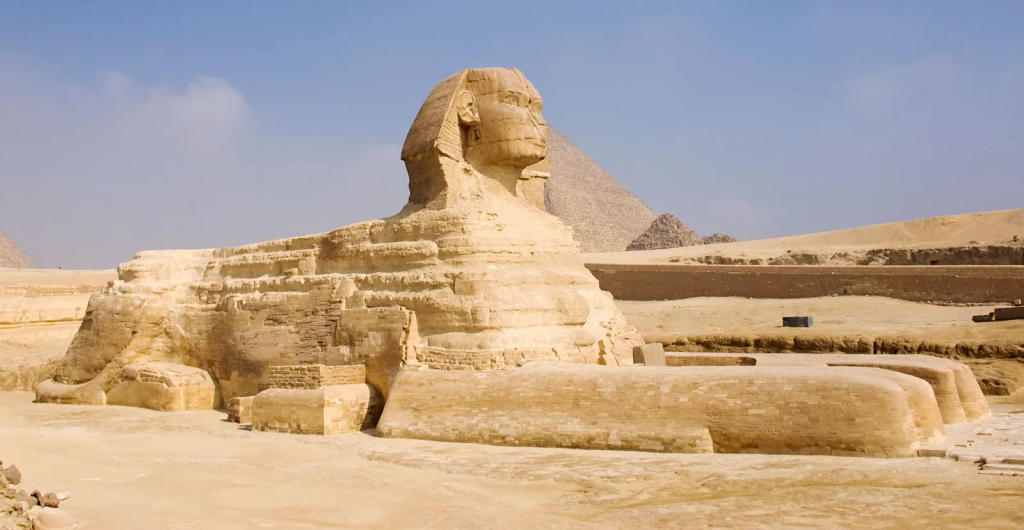

This imagery might also played a roll in the creation of the sphinx many ages before as the central solar deity Knuhm/Atum, hence the reason why we see ram headed sphinxes as well.
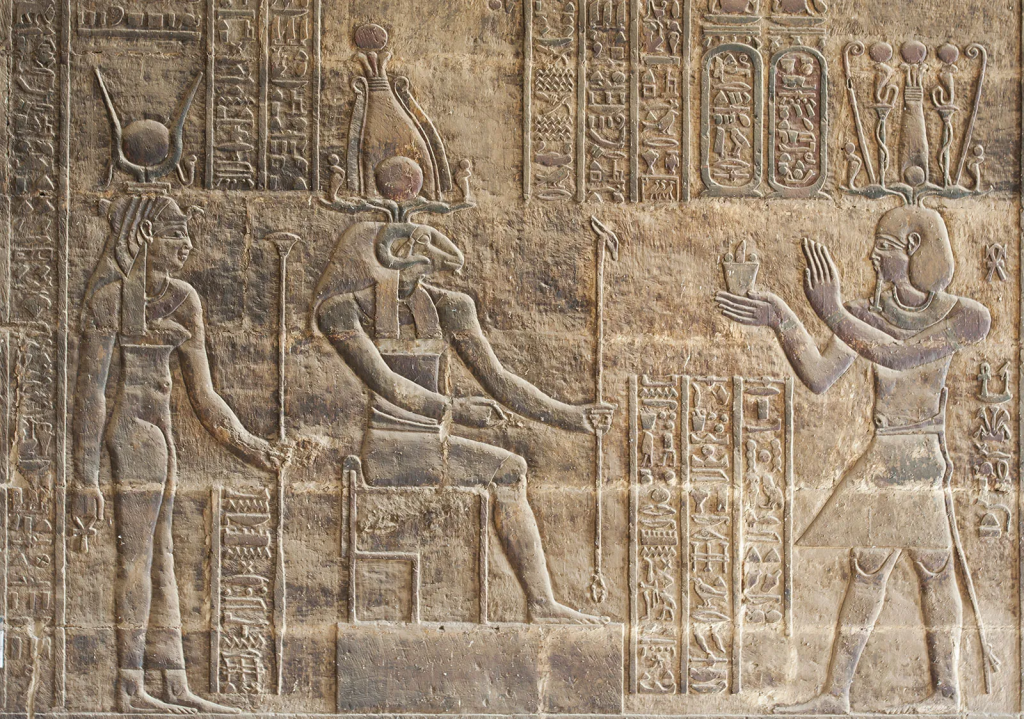
One can even say that the modern image of Baphomet, is based on the above images of Knuhm and Phanes.
Not as the devil perse, but as a composite creator god, complete with the male and female encompassing both good and evil in 1 instead of a duality view of good vs evil / god vs devil. Its all part of the same.
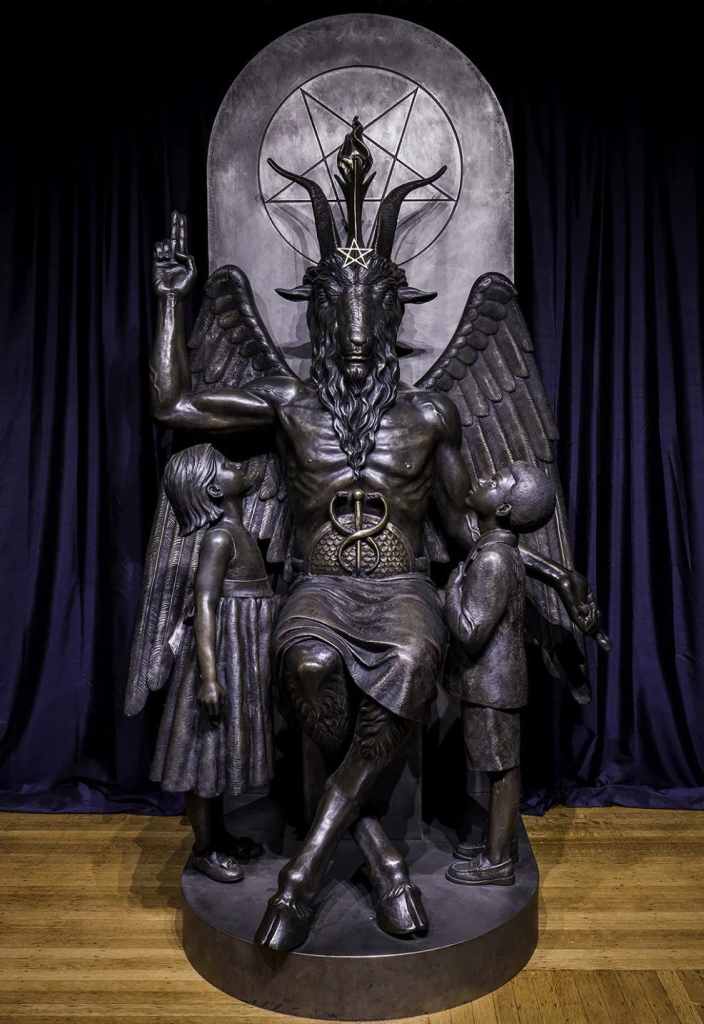
Phanes was at times depicted as a hermaphrodite as the universe is male and female in nature. So was also Baphomet, but the statue of Baphomet was chosen with a male chest for political reasons. But since time, Phanes was sometimes also hermaphodic in nature and its clear that Baphomet evolved from Phanes and Knhum.
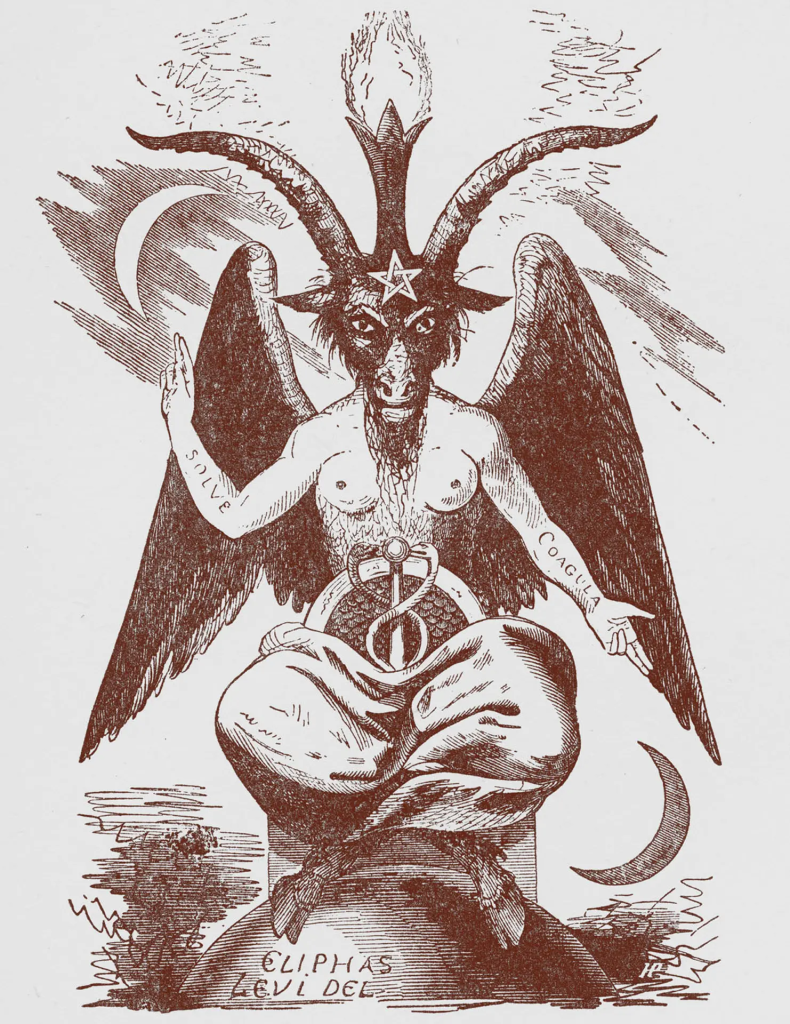
The goat/devil derived from the winter solstic at capricorn, but Pan, which looked very much like our modern devil, had a huge member, like the other name for Phanes, Lord Priapus and thus also incorporated the fertility aspect. They are composite images. just as Phanes incorporates both opposite seasons so does Baphomet with the light at the top and pentagram. He is not the the classic depiction of the devil, “he is both” or all. The creator, preserver and destroyer, Much like a single Lingam consist out of a square, octagon and circle and not seperate pieces.


A zodiac eye to art
Like Leonardos last supper painting, also here, one has to look at the painting the last judgement: https://en.wikipedia.org/wiki/The_Last_Judgment_(Memling) of Memling with a zodiac eye. Jezus is the spring equinox, St.Michael the autumn equinox, Summer is on the left panel, as Heaven, whilst hell is on the right panel as winter. When the panel is closed it shows the two opposites As Maria/Jesus as a baby (Isis/Horus) and St. Michael in the underworld part of the zodiac. Spring vs Autumn equinox.
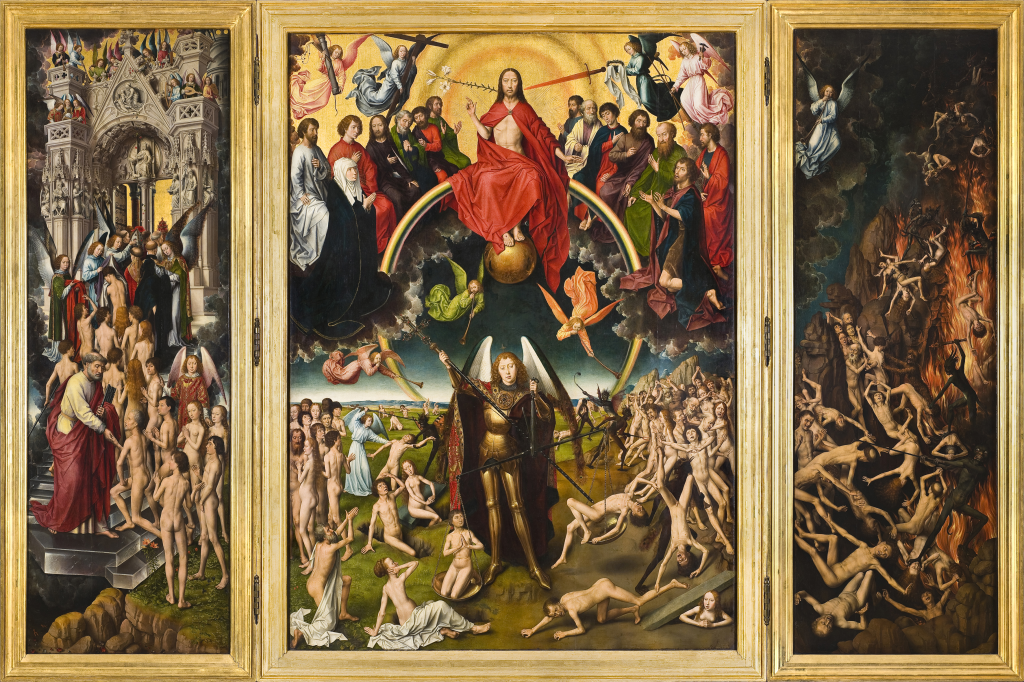
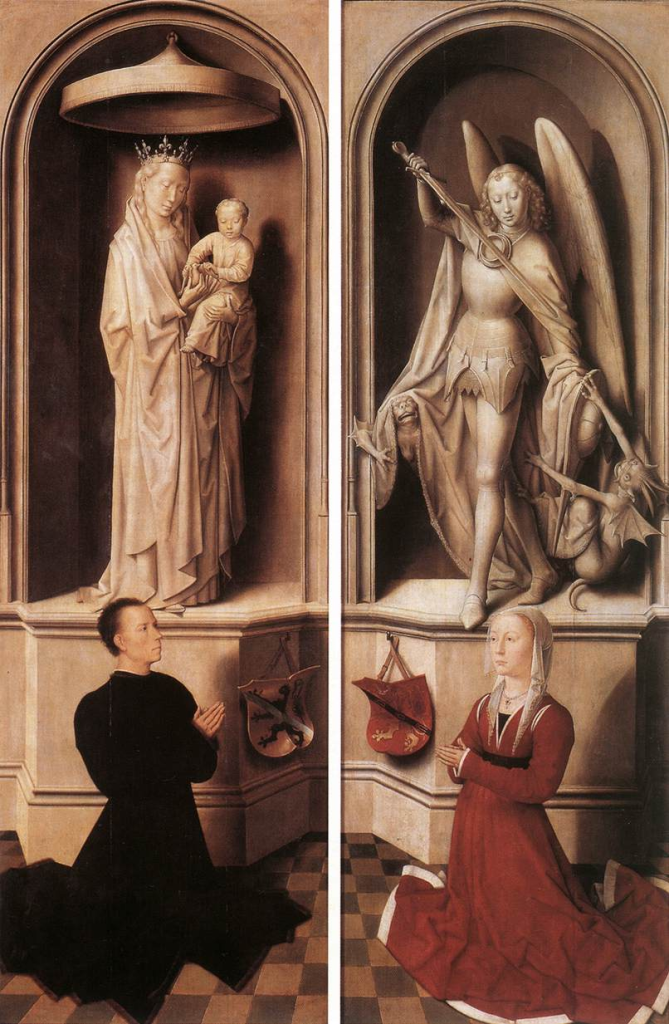
Hercules, St. George, Michael/Michelle is all the constellation of Orion, which “fight” the opposite bad side of the zodiac / winter capricorn(devil) etc. It was also orginally Belerophon vs the Chimera. All is syncretized astronomy. They simply put old wine in new flasks. Its all the same, with the exact same astronomical origins.


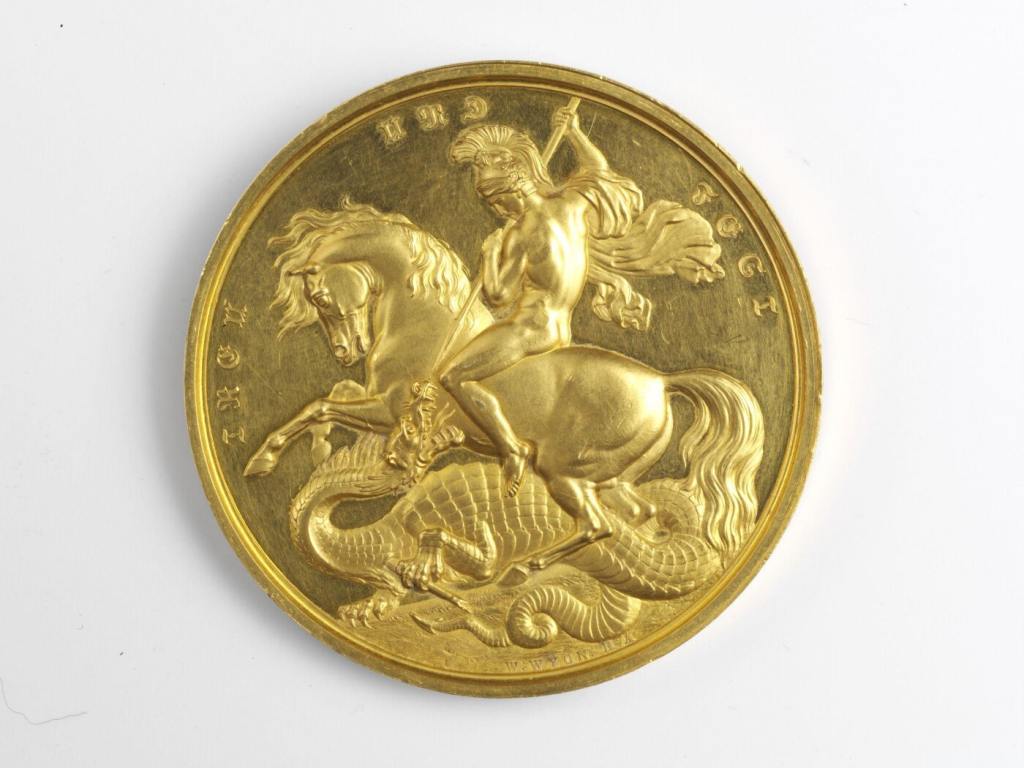
On current coins its St. Michael who defeats the devil
This particular theme of good vs evil , spring/summer vs autimn/winter, good vs evil, day vs night has been regurgitated and remodelled for centuries as can be seen in the Horus vs Set version of the louvre museum
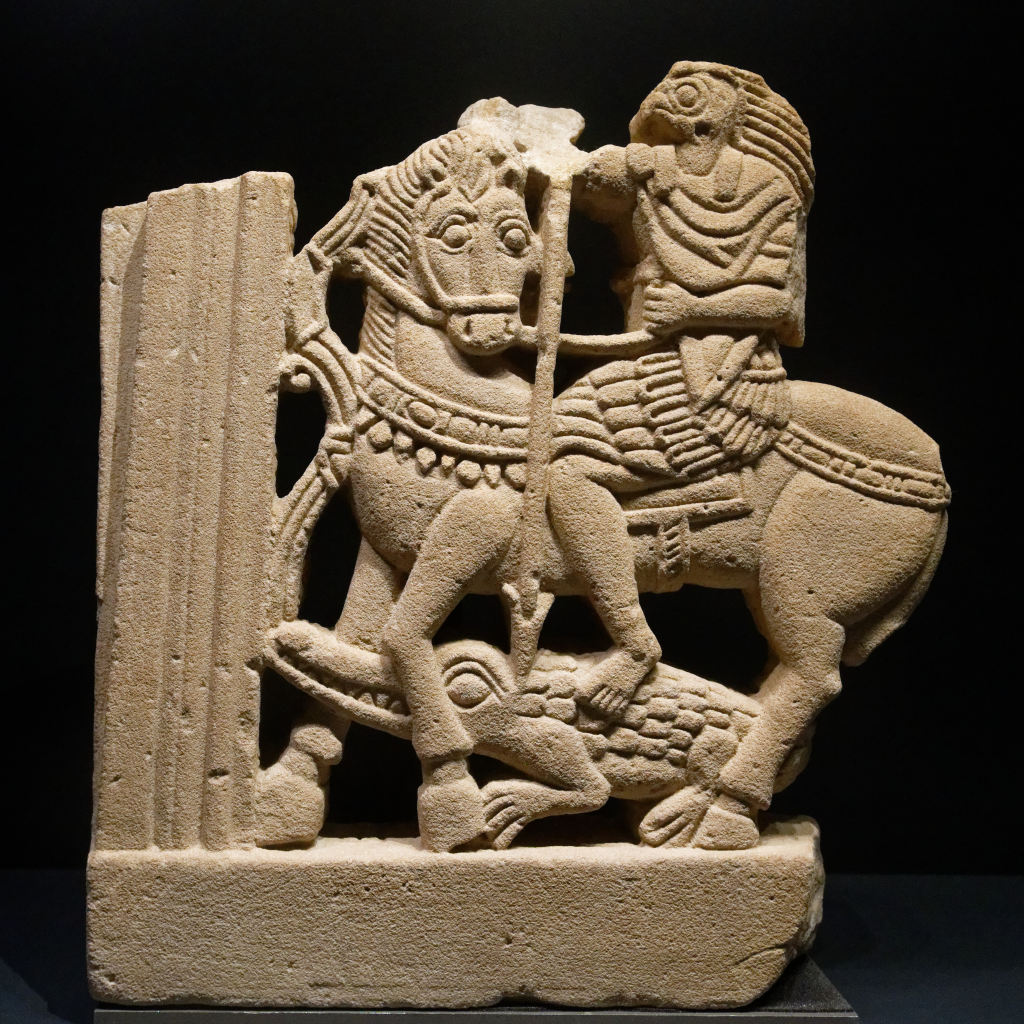
Images: St. Michelle top statue, mont St. Michelle France. https://www.wikimanche.fr/Statue_de_saint_Michel_terrassant_le_dragon
Hercules and Iolaus (Ophiucus) vs the Hydra. Malibu 83.AE.346, Caeretan hydria, c. 525 B.C.
Main panel: Hercules slaying the Lernean hydra
Collection of the J. Paul Getty Museum, Malibu, California
St. George and the dragon Source: https://collections.vam.ac.uk/item/O1264482/prince-alberts-medal-medal-william-wyon/
Horus vs Seth in horseback image. Louvre museum https://en.wikipedia.org/wiki/File:Horus_horseman_Louvre_E4850.jpg, public domain
Quote Wikipedia: “The constellation Hydra was known in Babylonian astronomical texts as Bašmu, “the Serpent” (𒀯𒈲, MUL.dMUŠ). It was depicted as having the torso of a fish, a tail of a snake, the fore paws of a lion, the hind legs of an eagle, with wings, and with a head comparable to the mušḫuššu.[5][6]” Source: https://en.wikipedia.org/wiki/Mu%C5%A1%E1%B8%ABu%C5%A1%C5%A1u#:~:text=The%20constellation%20Hydra%20was%20known,head%20comparable%20to%20the%20mu%C5%A1%E1%B8%ABu%C5%A1%C5%A1u.
This makes it very clear that Hydra and the Chimera are linked to each other as the personification as evil and that later imagery of hero vs the dragon is derived from this. Its also the good vs evil celestial fight and where evil is the Chimera, the snake, scorpion, Nergal, the war god, winter, the goat capricorn etc vs Orion as fertility and the good season.
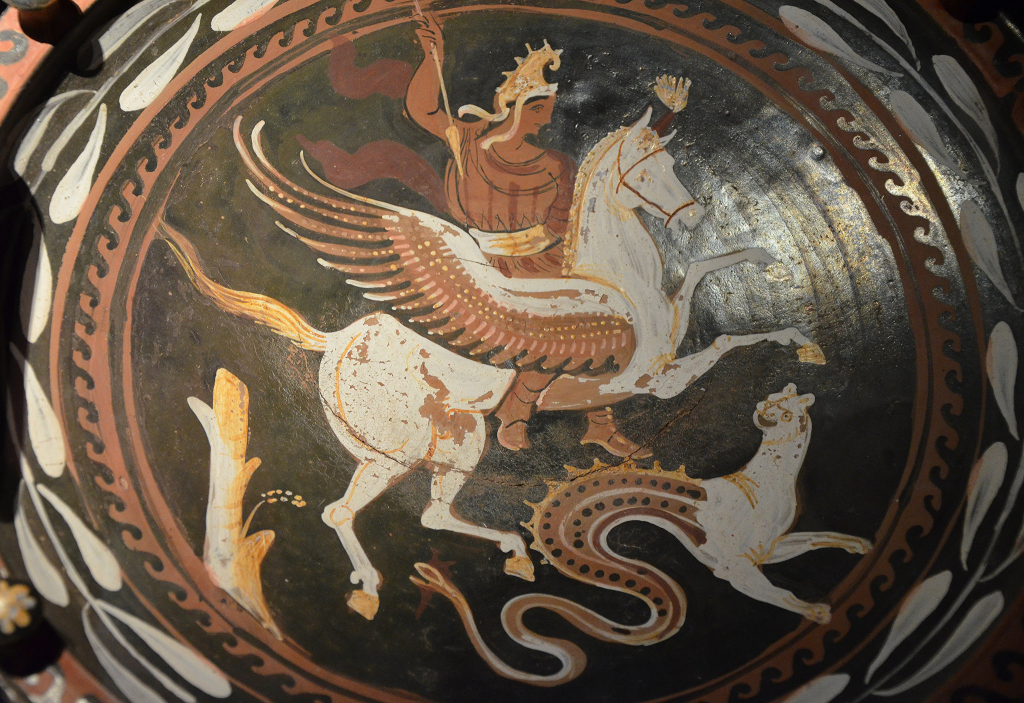
Bellerophon riding Pegasus and chasing the Chimera, by the Baltimore painter, second half of the 4th century BCE.
This will explain the later adoption, renaming and the relations of the god fighting the hydra like Hercules and many others.
Like most important figures in history, these are all Orion. (Baal, Teshub, HadadMerqat, Hercules, Osiris, Horus, Jesus, Adam etc) This good vs evil opposite zodiac symbolism is also evident in the story of Gilgamesh and Enkidu and in the later St. Niklas and Krampus. Where St. Niklas with his shepherd staff (like bishops) are the Orion/True shepherd of Anu version, against the devil/wargod or, against “the serpent”

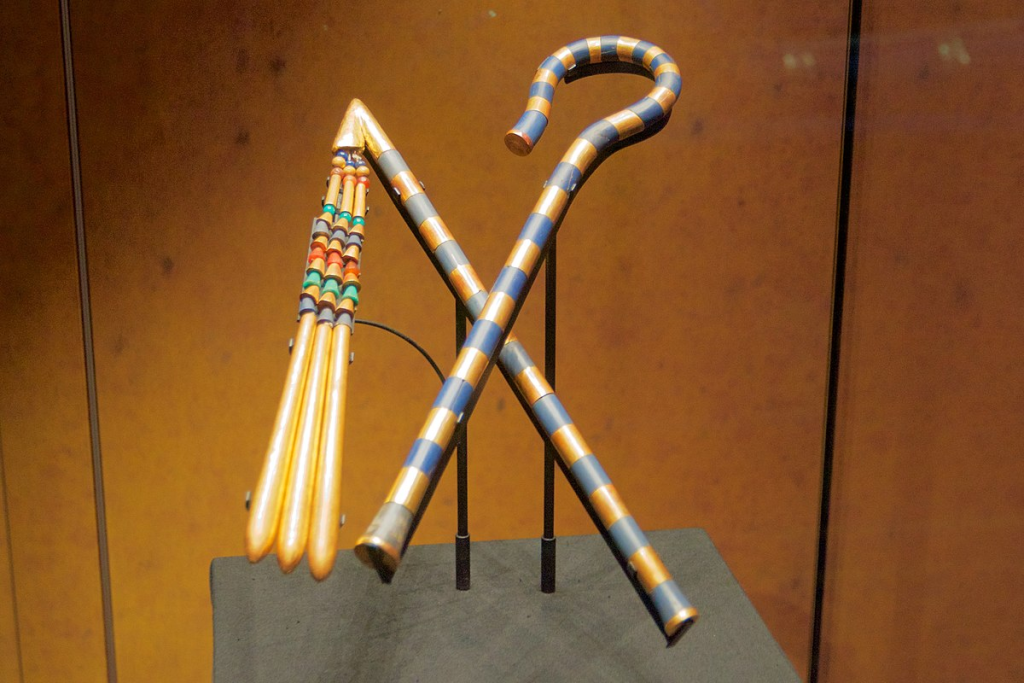
“The opposite ends of the zodiac tale” has been told in many forms. For example in the Dutch Sinterklaas Story (I wrote a seperate artile on that here.) , which also used the crook and flail in symbolism, Good vs evil has been used since ancient egypt times.

Detail from Original Sin, Adam and Eve in The Garden Of Eden, late c. 19th. (Twitter)
Adam is Orion, Eve is Virgo, the devil is the wargod at Ophiucius. Its an astromomical allegory like the below Qetesh stele where the 3 characters are also present. Orion/Min (Adam) Virgo+Leo/Inanna and Ophiucius Nergal/the war god (devil)

Storm gods and serpents
It is important to note that the stormgod vs Serpent story has been told in many cultures in various forms and all are linked relates to the rotation of the sky and in the bigger sense, the worldly battle of good vs evil.

So many cultures had a storm god that weilded lightning, an axe or a hammer as their main god, all of them battled a serpent. Some have said the snake was chaos or forces of nature or even day battling the night, however as far as the author is aware there is no published explanation on this specific symbolism, nor an explicit link being made between the symbolism and deities across the different cultures worldwide showing that all these religions are adoptions of1 particular methaphore.
- Symbolism of the male sky god
- The skygod (or eagle) vs the snake/dragon/alligator
- Symbolism of the female earth goddess
- Depictions across cultures
- The Vaijra / dorje and the bel of budhism
- Symbolism of the male sky god
- Hammer
- Axe or Double axe
- Lightning, trident / double trident, Vaijra
- Sickle
- Thunderbolt
- Horse
- Snake/dragon/aligator
- The skygod (or eagle) vs the snake (dragon/alligator)
Every culture depicts this in the same way individually in the exact same manner with different names for their main storm deities. This can impossibly be coincidence and a common source or cultural exchange for this global symbolism is evident. Lets start with the numerous examples across different cultures.

Engraved shell plaque of unknown provenance; 39 mm high, ca. 2600-2300 BCE (Bible Lands Museum, Jerusalem). Right: stone cylinder seal from Tell Asmar, Iraq; 32 mm high, ca. 2271-2154 BCE (Iraq Museum, Baghdad). Source: Green 1997a, plates 13 and 14 (= ANEP 671 and 691).
- Marduk and Mušḫuššu,
The mušḫuššu is the sacred animal of Marduk and his son Nabu during the Neo-Babylonian Empire. It was taken over by Marduk from Tishpak, the local god of Eshnunna.[4] Tishpak (Tispak) is an Akkadian god, who replaced Ninazu as the tutelary deity of the city of Eshnunna
The myth of Tishpak batteling the dragon is mentioned in this article in full. https://www.jstor.org/stable/606370?read-now=1&seq=1#page_scan_tab_contents


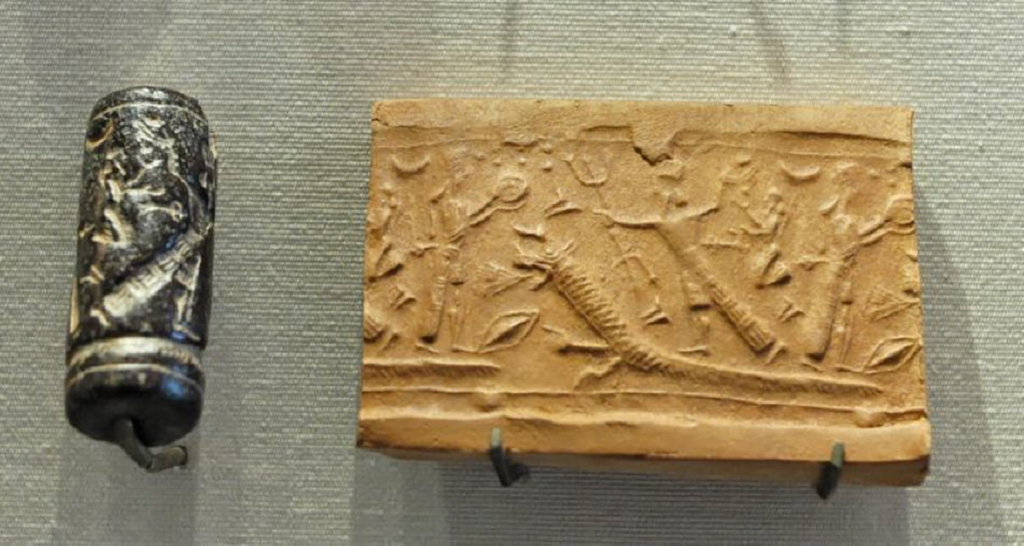
Louvre Paris Scroll Seal AO 22347
Marduk killing Kingu
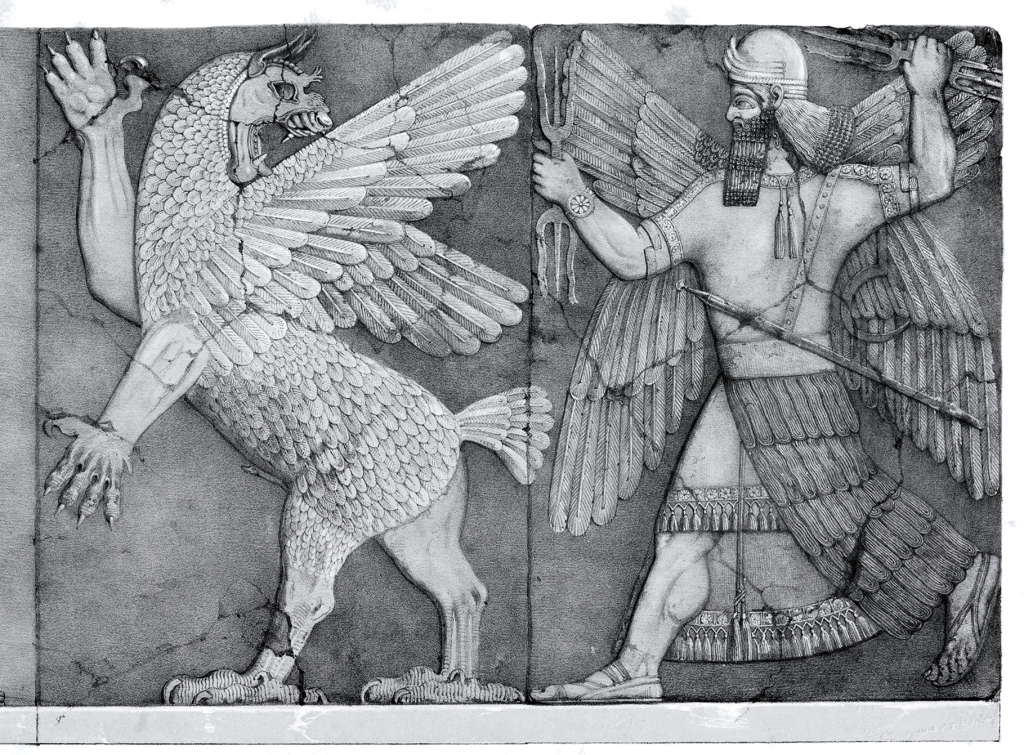
- Marduk vs Kingu, a composite animal of the other 3 zodiac cardinals, is where the Chimera and Pegasus/Bellerophon(Orion) comes from. Again, this is good vs evil. A clear syncretized lineage of succession becomes vissible to the later “St. George and the Dragon”.
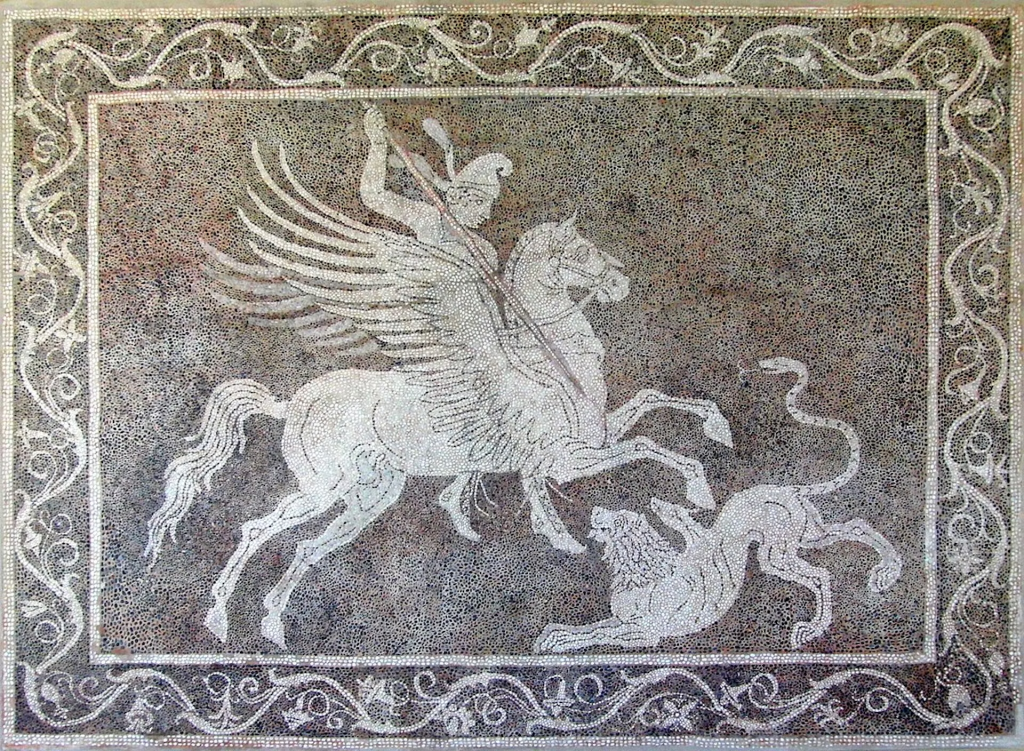
Mosaic depicting Bellerophon killing the Chimera (ca. 300–270 BCE). Rhodes Archaeological Museum, Rhodes, Greece. TOBYJPUBLIC DOMAIN
The Sumerian Marduk made its way to Candi Sukuh Java. Even though this visual relation was noted in 2005 by Wayne Hershell, the explanation why and which exact symbols those where not mentioned.
Symbols that makes this “Marduk” – Note the two lightning bolts, the sickle and the 3 tiered headdress (Of bullshorns)
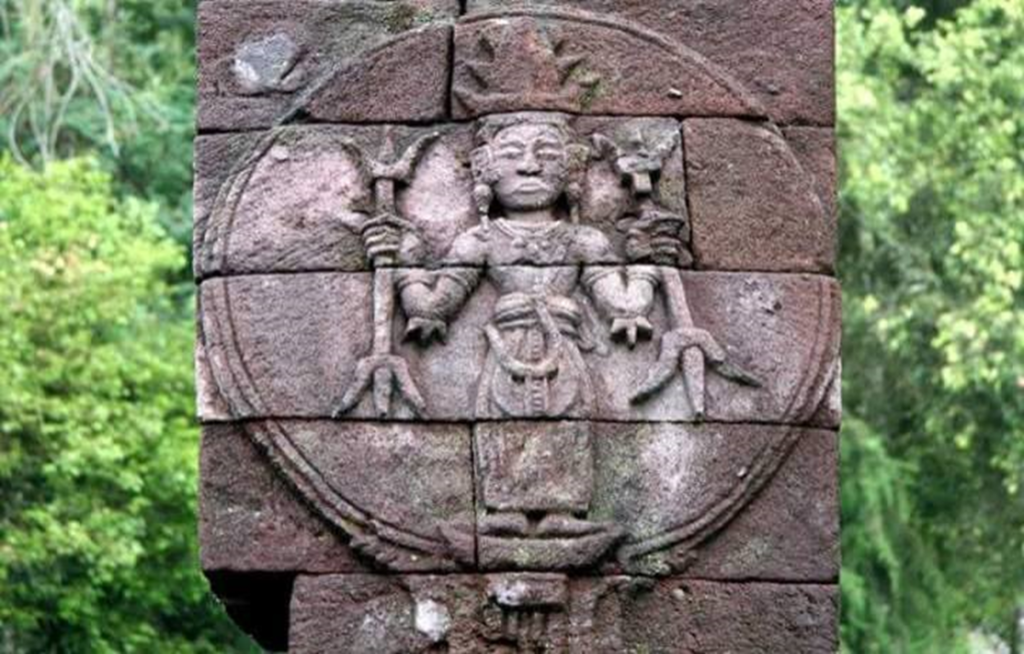
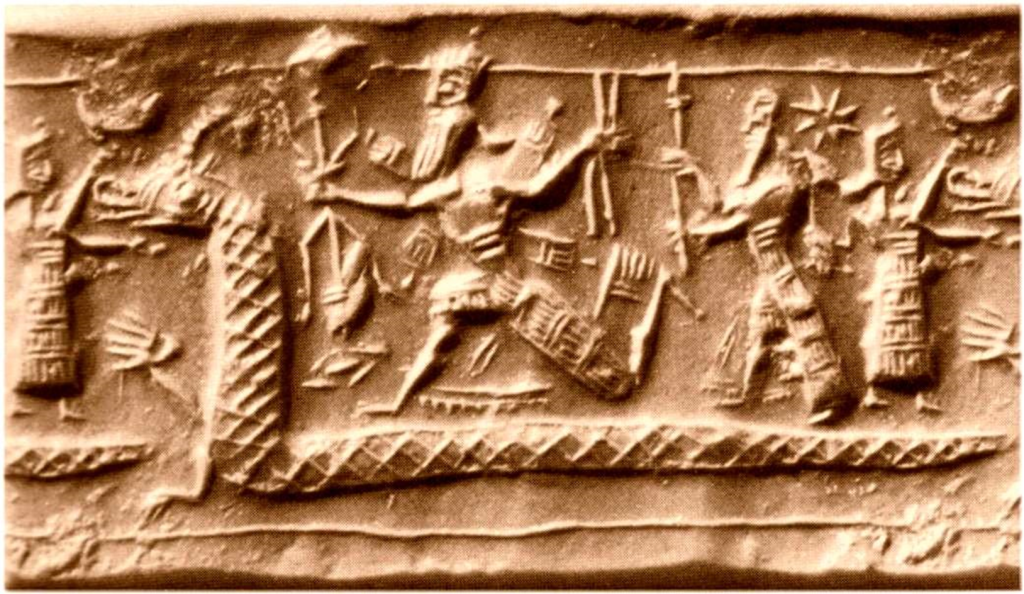
Assyrian cylinder seal, ca. 800-750 BCE
But the main reason is that its describing the same zodiacal turning of the skies. Over and over again its the same story where the names of the characters are different, but the story the same.
There are poetic and linguistic links between many dragon-slaying stories, too, as argued by Calvin Watkins in his classic study How to kill a dragon (1995). https://en.wikipedia.org/wiki/How_to_Kill_a_Dragon
- Krishna overcomes Kaliya (Indian)

- Indra vs Vitra (Indian)

- Shiva VS Vasuki (Indian)
- Vishnu vs Ananta-Shesha (indian)
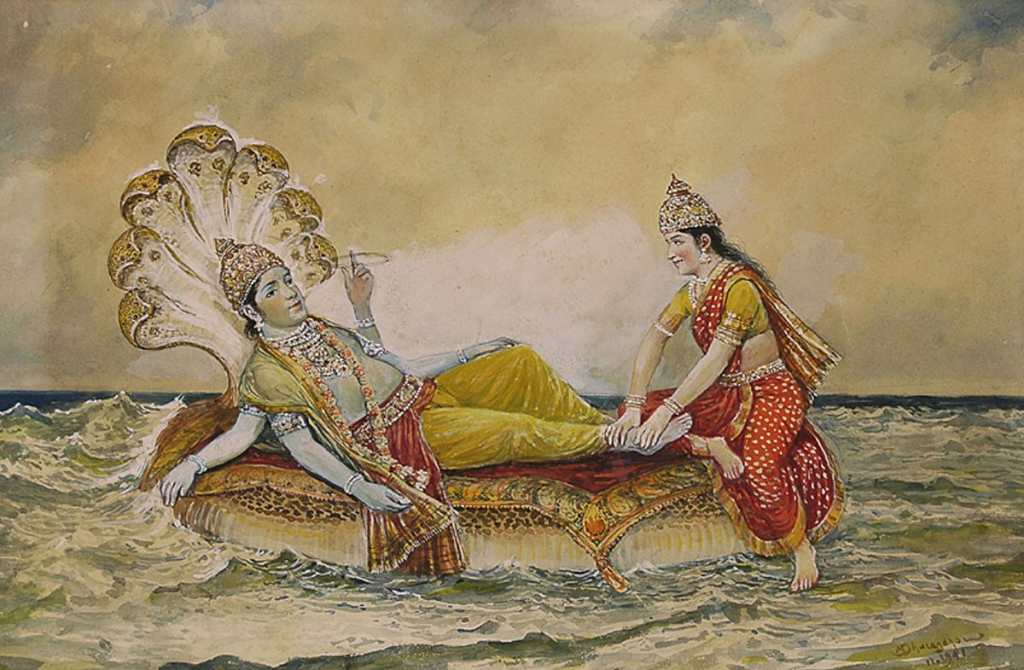
- Ra vs Apep (Egypt)

- Atum and the snake Apophis (“the snake in the tree”, sounds familiar?)
- Set speared Apep
- Horus (hero) vs sobek (Egypt) (Horus under the form of a horseman piercing a crocodile with his spear, louvre museum)
- Zeus vs Typhon (Greek)
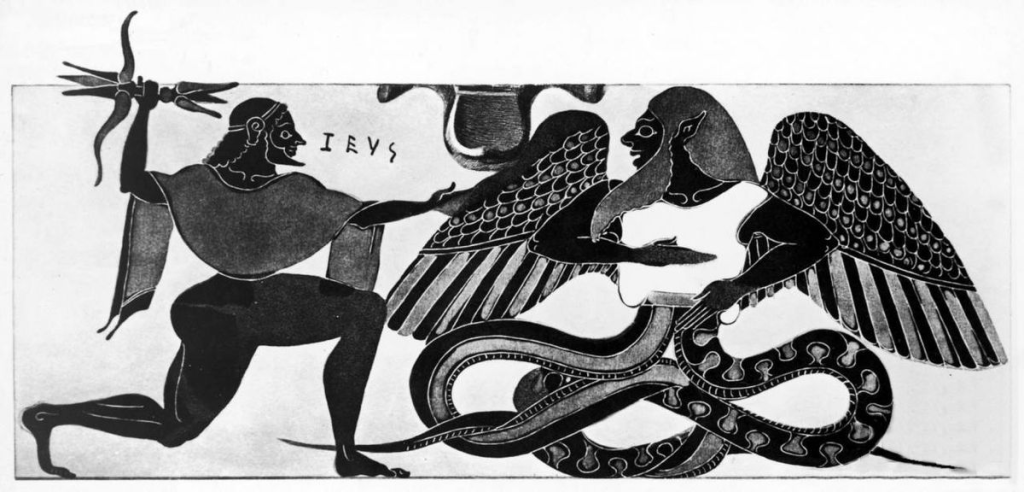
Zeus as stormgod is well known. Note the specific lightning bol shapes, which I will discuss later as the Vaijra symbol
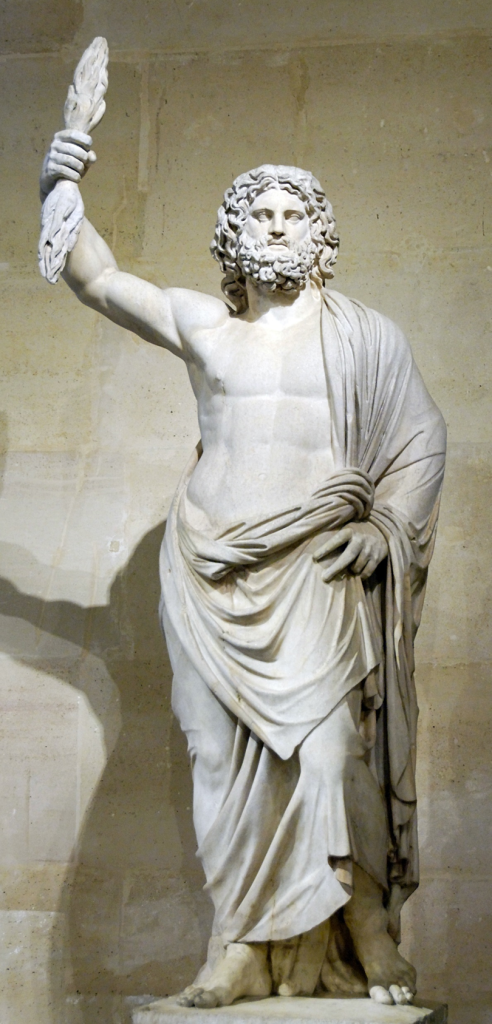
https://upload.wikimedia.org/wikipedia/commons/c/c8/Jupiter_Smyrna_Louvre_Ma13.jpg
Hercules vs the Hydra
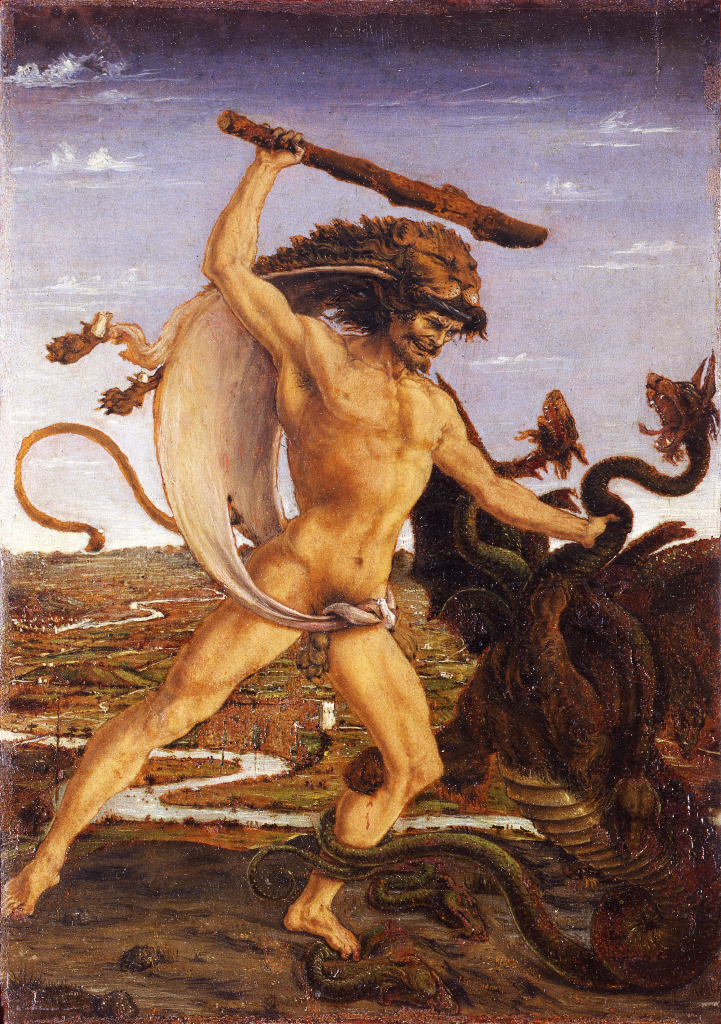
Thor vs Jörmungandr’s (Nors) Thor


Marduk or Bel vs Tiamat (Sumerian) Note again the specific shape of the lightning in Vaijra shape.
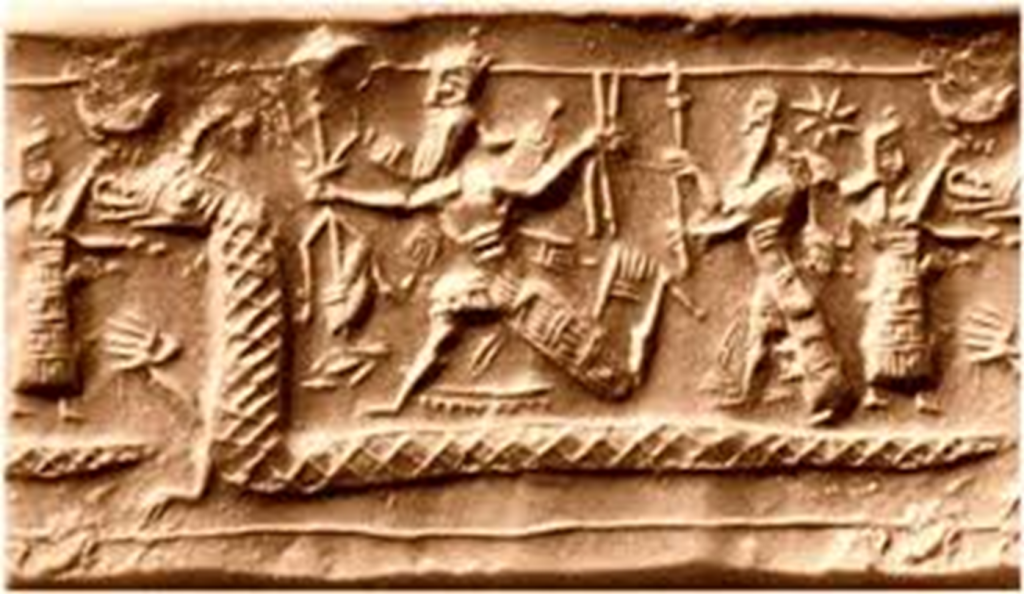
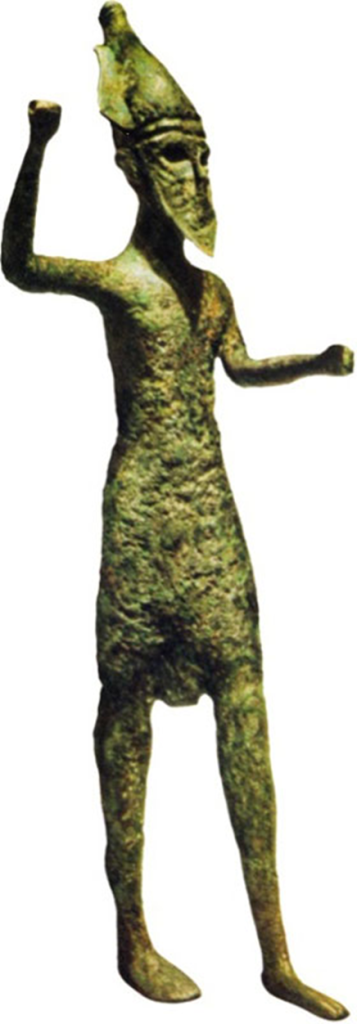
Bronze statue of Melqart, bearing a strong resemblance to the Stele of Baal. Melqart (milqartu, tutelary god of city of phoenician city of Tyre)
- Hadad vs Têmtum (Mesopotamia) https://eprints.soas.ac.uk/7076/1/JANER8%3A1offprint.pdf
According to what became the dominant genealogy, Iškur/Adad’s father is the sky-god An/Anu. (This is relevant as Hercules was son of Zeus, Jezus of Jaweh. The same story using different names. However, in Sumerian literature Iškur is sometimes the son of Enlil; the disparity probably reflects two local traditions (see further Schwemer 2001a: 166-8; 2007: 132-3). A mother of Iškur/Adad is mentioned only once, in an Old Babylonian prayer where Iškur is called the son of Uraš (Schwemer 2001a: 168). The storm god was equated with other Near Eastern storm gods including north Babylonian/Assyrian Wer, Hurrian Teššub and Hittite-Luwian Tarhun(t) (see Schwemer 2001a for more detailed information).
- Teshub / Tarhunz (hittite) vs Illuyanka/Heddamu (Hurian)
- Tarhunt and the dragon Illuyanka (hittite)

Tarḫunz (stem: Tarḫunt-) was the weather god and chief god of the Luwians, a people of Bronze Age and early Iron Age Anatolia. He is closely associated with the Hittite god Tarḫunna and the Hurrian god Teshub. Again the exact same symbolism.
Here a statue in Aleppo: https://upload.wikimedia.org/wikipedia/commons/b/bc/Hetite_God_in_Aleppo.jpg
There are many many hero vs the slaying of the dragon stories in varies cultures. They all tell the same astronomical story and in essence base hemselves on what is known as the Chaoskampf of good vs evil but its more than that the underlying origin is in the rotation of the skies and the zodiac. One can see that this particular story travelled the globe and was retold with many characters in a classic example of old wine in new flasks.
- Taranis (The link to Taru, Tarhan is obvious)
- Baʿal vs Lôtān (send by seagod Yam) (Canaanite /Syrian) or Tannin (Tannin is sometimes associated with Tiamat and, in modern Hebrew, the name tannin means CROCODILE) https://en.wikipedia.org/wiki/Tannin_(monster)
- Perun vs Veles
- Sigurd vs Fafnir Depicted on the ramsund rune stone, this story has parales with the story of King Arthur and Excalibur. In the case Of Sigurd he gets a sword embedded in a tree from a hidden odin and nobody can pull it out but Sigurd. He then uses it to slay the dragon Fafnir. The tale of king arthur is also zodiacal in nature, with a “round table” that has 12 knights,again Orion and the 12 zodiac constellations. The sword, from the “lady of the lake” he gets from the bottom part of the zodiac (the war/ evil part where also the dragon (hydra resides) There are also dragon tales related to Merlin in the King Arthur story. He was known as a slayer of dragons. A dragon can be seen on the coat of arm of Wales.
Quote:
“The red dragon is the people of Britain “ replied Merlin “the white dragon is the invading Saxons. At the moment they seem to be winning the war but one day a leader will come who gives the British the heart to fight back and drive the Saxons from their lands.’” Source: https://www.quora.com/How-many-dragons-are-there-in-Arthurian-legend”

One can clearly see the paralels and the zodiacal origins of the story. Arthur and his 12 knights relates more to Hercules and its 12 labours or the Jezus and 12 apostel story (Orion and the 12 constellations), than to the hero fighting the dragon version of the zodiacal tale. (Orion vs Hydra)


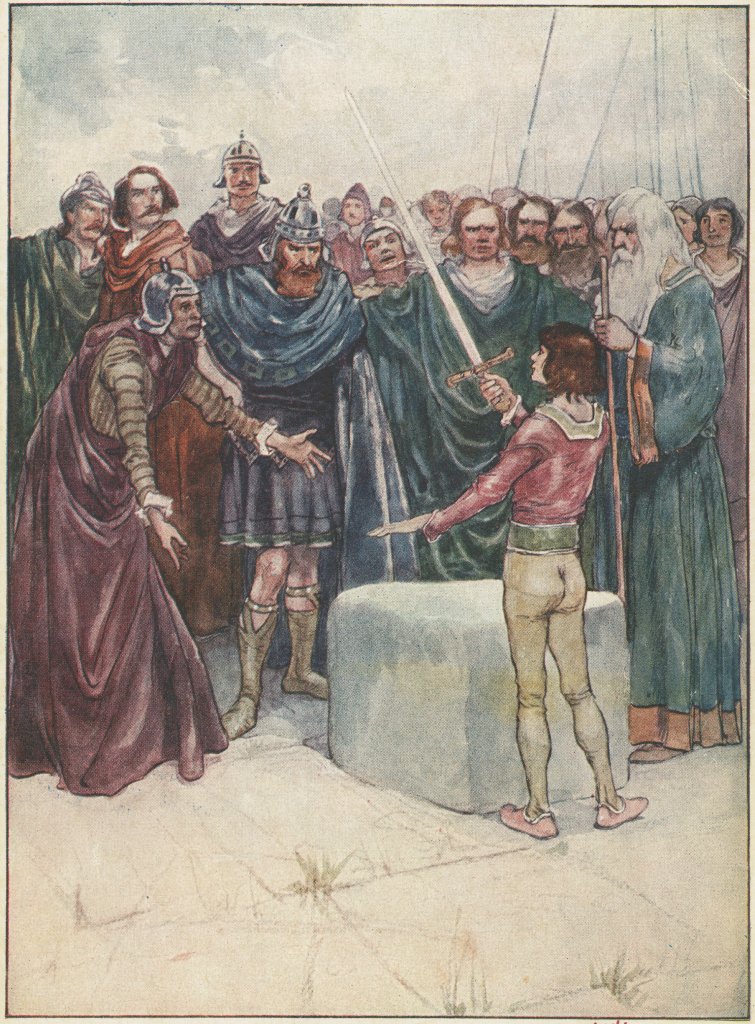
Rune Stone showing Sigurd slaying the dragon, Source: https://en.m.wikipedia.org/wiki/File:Sigurdsristningen_-KMB-_16000300013664.jpg
Odin asking people in the Sigurd story to pull the magic sword Gram out of the tree. Source: https://thevikingdragon.com/blogs/news/sigurds-origin-andvaris-curse-part-iv
Image of Excalibur lodged in a stone. Source: https://en.wikipedia.org/wiki/Excalibur
- St. Michael vs Satan
- George and the Dragon
- Jaweh vs Levithian Hebrew)
- Jaweh battled a snake, Tiamat.
- Hydra vs Hercules (Greek)
- St. George vs Dragon AND St. Theodore and the dragon
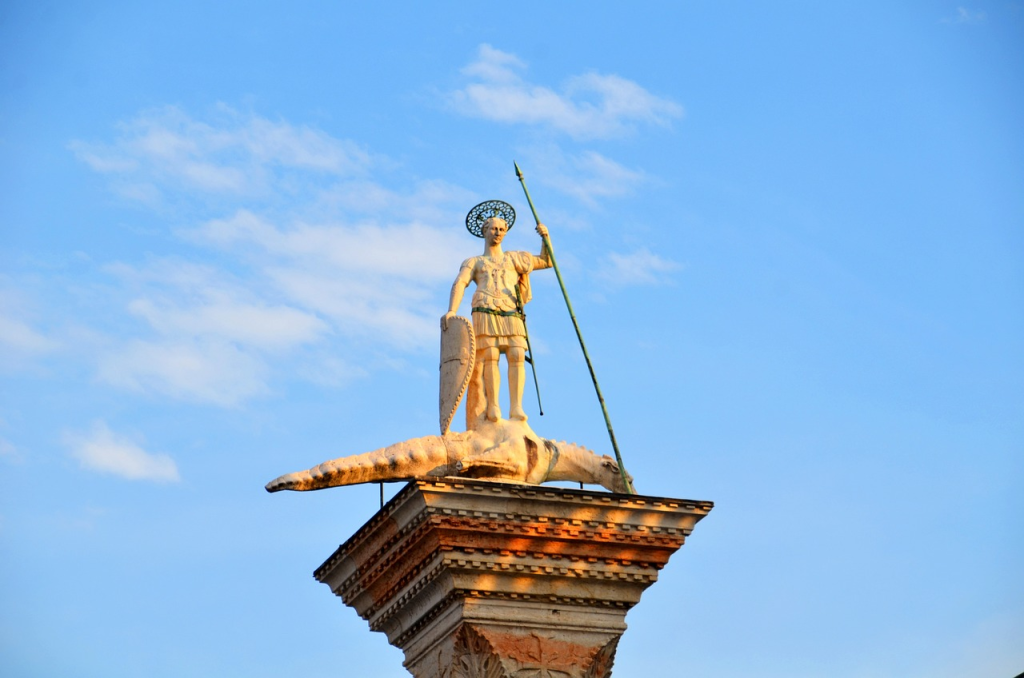
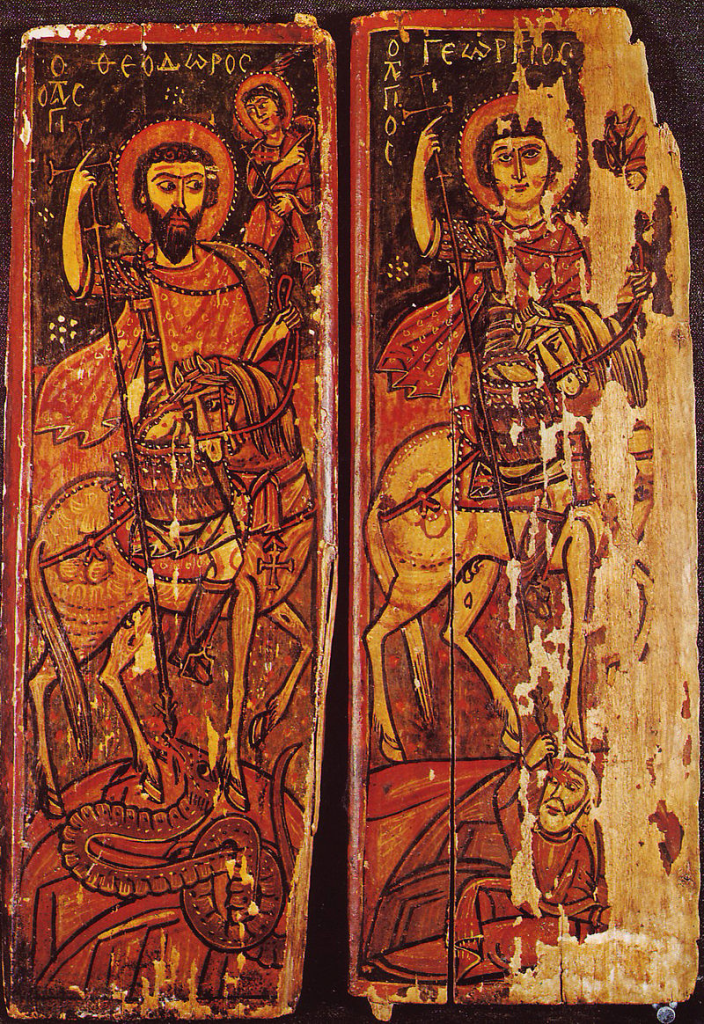
Saints Theodore and George shown side by side as equestrian heroes. Theodore kills a dragon and George a human enemy. Saint Catherine’s Monastery, Sinai, 9th or 10th century. This is where it gets interesting, it speak about two individuals slaying the dragon, St. Theodore AND St. George. This is most likely derived from Hercules and Iolaus.

Above is described as: Heracles, Iolaus and the Hydra, Athena. Black-figure lekythos C5th B.C., Musée du Louvre
The crab in this story is the constellation of Cancer which were two donkeys before it became the current constellation of cancer.. The original constellation of Cancer has been a turtle, donkeys, amongst others. But it is 100% astronomy and not just “mythology”. This is very evident when one looks at the starmap and sees the crab next to the Hydra.

Quote Wikepedia: “In Ancient Greece, Aratus called the crab Καρκινος (Karkinos), which was followed by Hipparchus and Ptolemy. The Alfonsine tables called it Carcinus, a Latinized form of the Greek word. Eratosthenes extended this as Καρκινος, Ονοι, και Φατνη (Karkinos, Onoi, kai Fatne): the Crab, [the] Asses, and [the] Crib. In Ancient Rome, Manilius and Ovid called the constellation Litoreus (shore-inhabiting).
The story of apollo and the scorpion its scorpio.
Astacus and Cammarus appear in various classic writers, while it is called Nepa in Cicero‘s De Finibus and the works of Columella, Plautus, and Varro; all of these words signify a crab, [a] lobster, or [a] scorpion.[24]” Source: https://en.wikipedia.org/wiki/Cancer_(constellation)
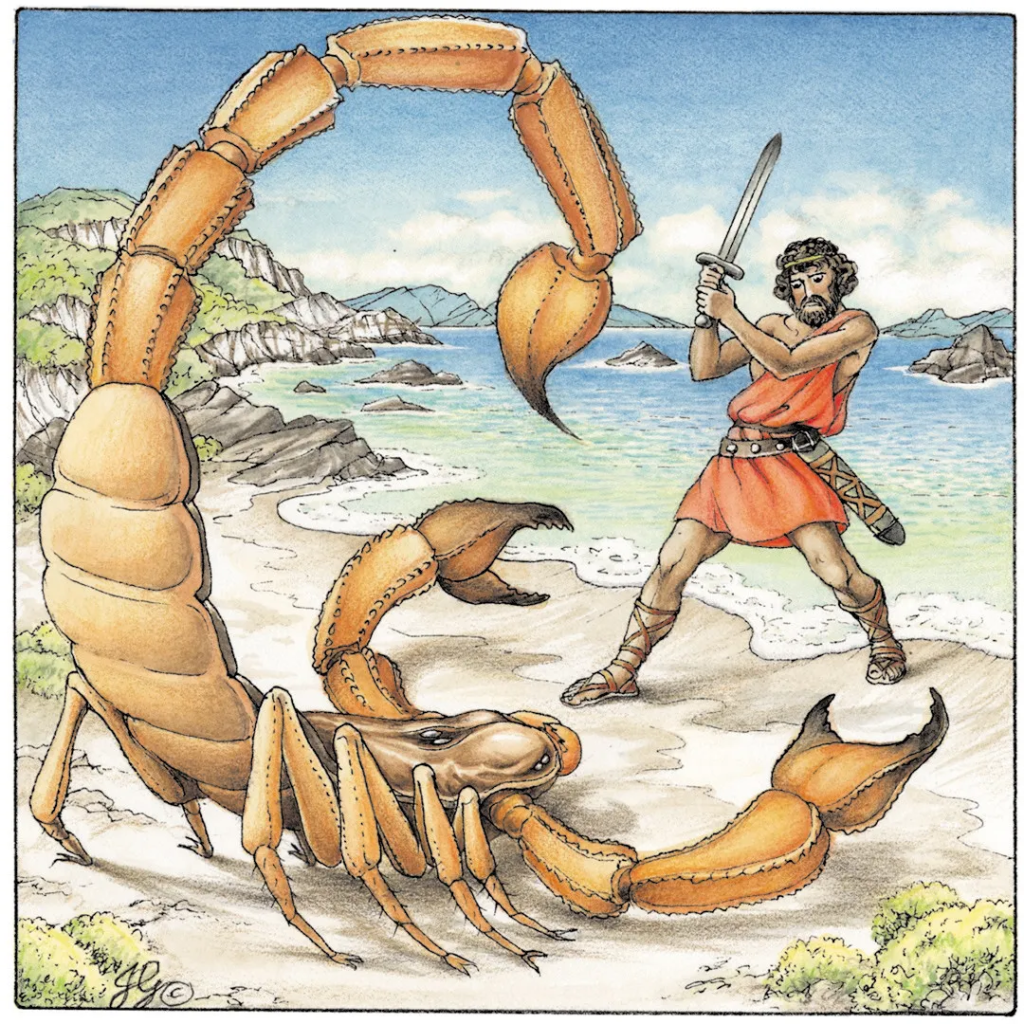
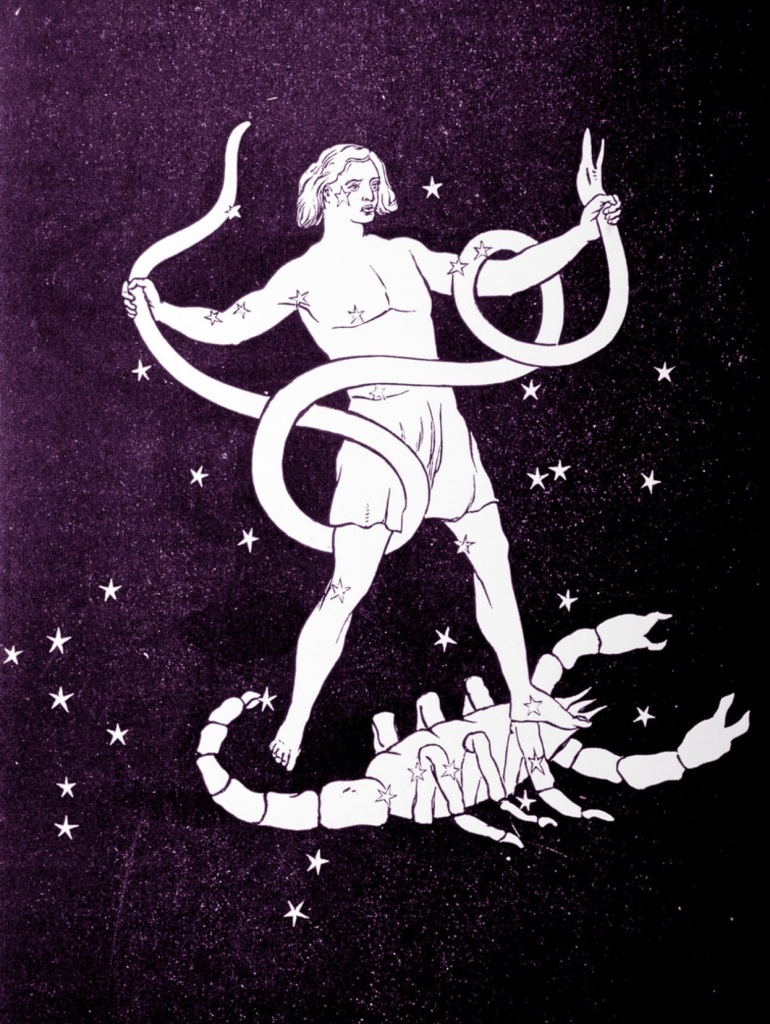
https://www.recordonline.com/story/lifestyle/2009/02/09/tell-me-story-artemis-orion/52106109007/
That said I think its Orion and Perseus (or Orion and Bootes) on the vase are fighting the dragon together and that the mystery man labeled as athena, that is killed besides the serpent Hydra by St. Theodore is in fact, Ophucius. This is in line with the Qetesh stele and the man with the spear, the war god personification or Nergal or the Devil in later times.
But ophiucus can also be a version of Hercules, fighting the Hydra and the scorpion, or, for that matter Apollo fighting Python.Ophucius was Appolos “son” so it would make sense its appolo there in a way. It was him who send the scorpion to Hercules, but it was Hercules who fought it with the Hydra. Its rather overlapping and complicated as characters are said to do the same thing and its multiple levels of stories using the same template.
- Mdugud vs Ninurta (Sumeria)
- Făt-Frumos (Romanian) vs Balaur or Zmeu
- Cadmus fighting the dragon
- Bellerophon vs Chimera He was “the greatest hero and slayer of monsters, alongside Cadmus and Perseus, before the days of Heracles“,[1]
This is a list of all the heros or gods fighting a snake, all of these are the same story and is astronomical in nature.
The eagle/bird of the skygod
The arches show usually the sun, Zeus or the skygod on the keystone, or, on the original design, leo, the summer constellation. The oldest depiction is of the skygod in eagle form, holding the caduceus (twin snake winged solar disk from Egyptian symbolism) on the temple of Jupiter in Baalbek
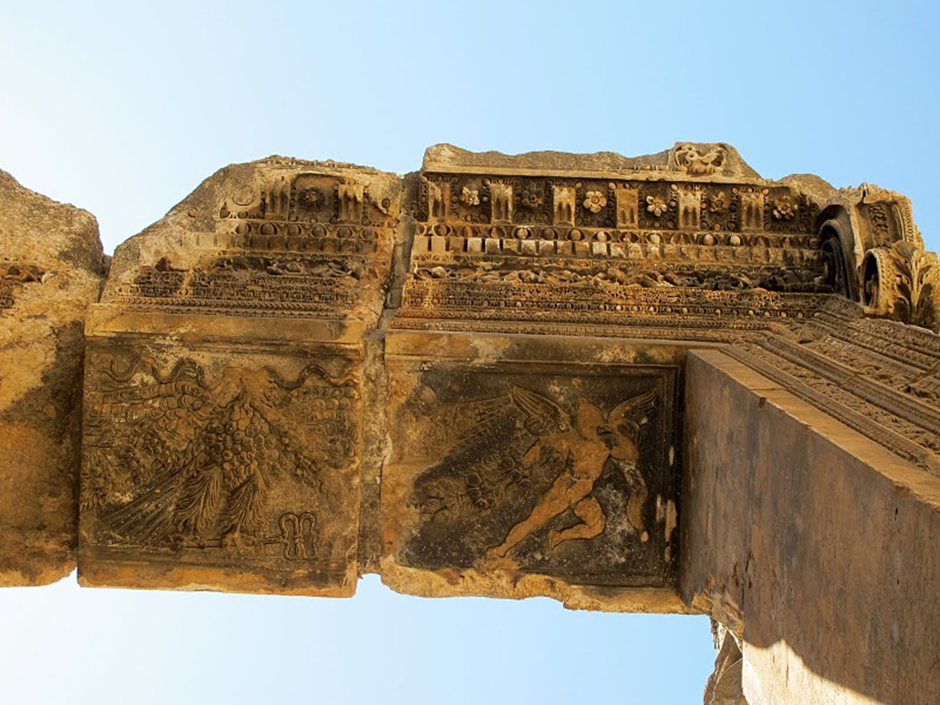
Image: Skygod Jupiter in his eagle form, flanked by two angels and holding the caduceus and garlands, one of the oldest depictions of the two “angels” flanking based on earlier Egyptian symbolism of the winged solar disk with the two snakes, the true origin of the caduceus.
Source: https://ancientarchives.wordpress.com/ancient-structures/baalbek-closeup-of-lintel-bacchus-temple/
The bird symbol of Jaweh was taken from the eagle of Zeus and turned into a dove. The eagle has been the Roman, Third Reich, USA icon, the doubleheaded eagle symbols of Hittites, India, Russia and Freemasons. The author suspects the reason is that sky has two heads, the sun and the moon, or the fact there are two birds there, vulture volans and vulture cadens (Aquila and Lyra) both a possible reason for the biphalic bird.
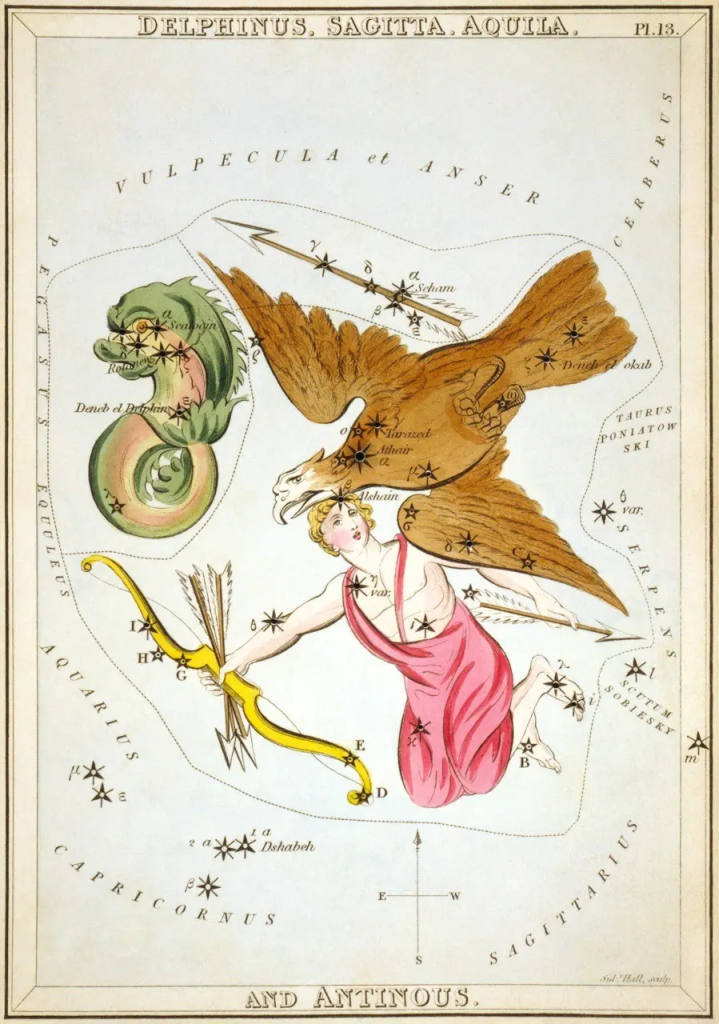
Aquila Constellation Meaning in Astrology
Aquila represents the Eagle, thought to be Jupiter himself, that carried Ganymedes to heaven.
Possible arguments for diffusion between the old and new world based on astronomical concepts
The swastika AND the bird on Pakals tree, relates to the constellation of the big dipper, in many cultures, even the mayas, where a swastika shape can be seen if one rotates the big dipper over the 4 seasons, which is the origin of the swastika. The nazis adopted both, the eagle of Zeus and the swastika symbol in their iconography. This came directly from the Romans (and the greeks) as can be seen on the only suriving roman Scutum shield which combines the swastika and the eagle of Zeus on it.
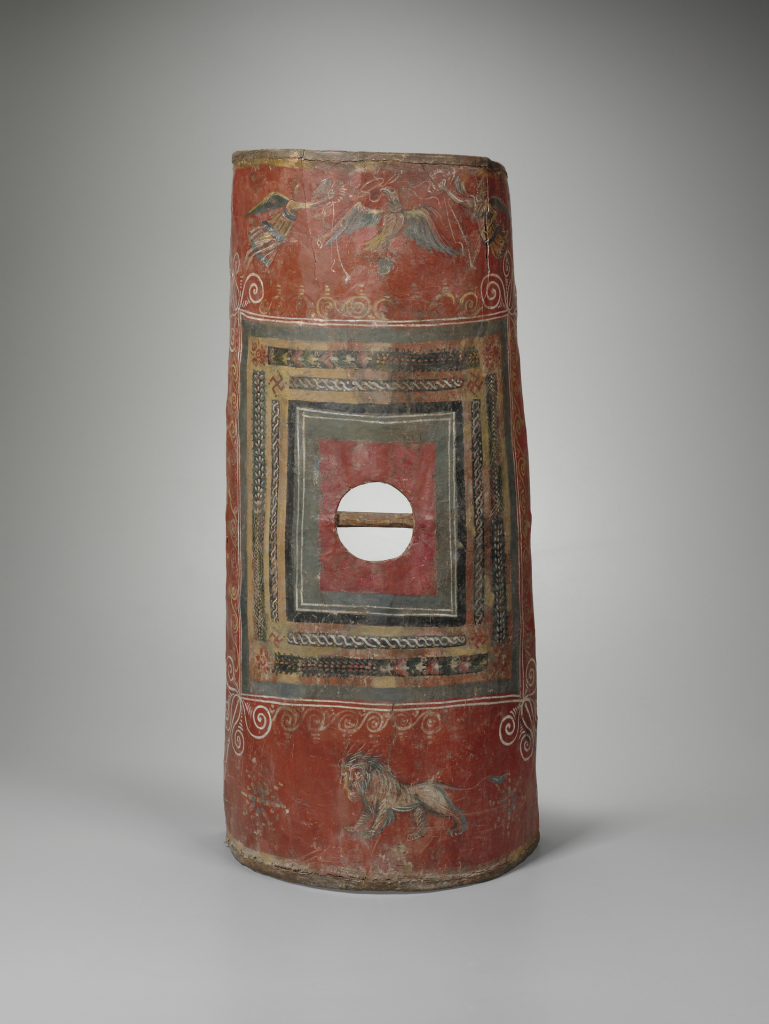
Image: Only surviving Roman Scutum shield with swastika and eagle. Source: https://en.wikipedia.org/wiki/Scutum
Now seen as a hate symbol, the true origins of it are lost to many. Similar swastika and eagle symbolism can be seen with the native American Indians, where there is, also a thunderbird eagle on top of the totem pole, their pillar of heaven.


Images: Rare Old Navajo Whirling Log Thunderbird Bracelet Cuff with Repoussé and Stamping, from the 1930s. The Whirling Log symbol is not associated with the Swastika and pre-dates WWII
Although there are no known or proven relations in cultural exchange with the americas, even the Mayas have a few astronimical similarities with the old world. These are the tree of life, the bird on top of it and tales about the twin brothers. For example quetzalcoatl and tezatlipoca and the hero twins.
This astronomicall allgory where elements of two brothers are used in their stories, does hint at possible cultural exchange between the two continents. This goes all the way back to babylonian depictions. where we see the central god and his two sons.



Tezcatlipoca as a jaguar or ocelot in the Codex Borbonicus
Not only the two sons of the skygod but also the tree of life symbolism is used on both sides of the pond. All this is astronomy. It is well known that the bird on Pakals tomblid represents the big dipper. This is the central sky. It doesnt take much convincing to see that even the iconography is extremely similar.


Image: Pakals tomblid and codex borgia. Basically these are zodiac crosses and the 4 directions, with constellations being the players. Orion is the maizegod, swallowed or “murdered” by the earth monster godess. Just as Shiva is murdered by Kali. The fertility aspect sits in the top of grown corn, the war/death aspect of the seasons sit at the bottom where corn shaped knives are used to kill oponents.
The earth monster, is a FEMALE godess. The maizegod fighting the earth monster that swallows him.

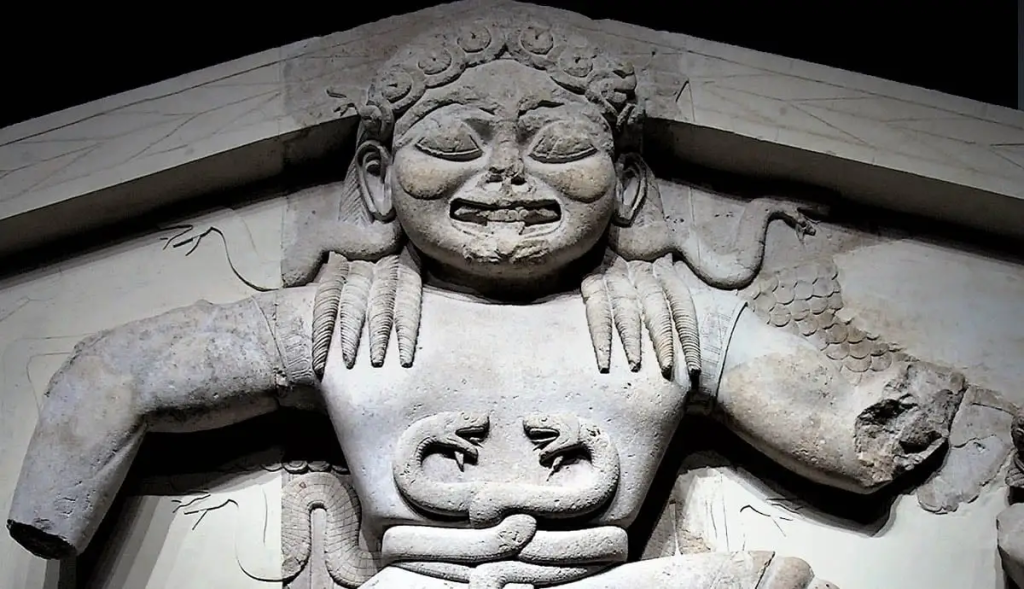



The earth monster, sits at the bottom of the zodiac.
https://en.wikipedia.org/wiki/Tlaltecuhtli#/media/File:Tlaltecuhtli_monolith.jpg
- The two thieves


Image: Crucifixion by Giovanni Donato da Montorfano, 1495, opposite Leonardo’s Last Supper, depicting the scene of Jesus being hanged between “Two thieves” Convent of Santa Maria delle Grazie, Milan
Great Twins (Gemini) The Great Twins are closely related to Nergal, the king of the dead in Mesopotamia tradition. The Twins stand guard, weapons at the ready, at the entrance to the underworld – their divine role being to prevent the living from descending to the realm of the dead, and perhaps more importantly to prevent the dead from rising up to overwhelm the realm of the living.
What does the bible say about the thieves?
Quote: There is a distinction made between the two thiefs, a “good thief” and a “bad thief” Only the Gospel of Luke describes one of the criminals as penitent, and that gospel does not name him. According to tradition,[21] the Good Thief was crucified to Jesus’ right and the other thief was crucified to his left. For this reason, depictions of the crucifixion of Jesus often show Jesus’ head inclined to his right, showing his acceptance of the Good Thief. Source: https://en.wikipedia.org/wiki/Penitent_thief#:~:text=Two%20men%20were%20crucified%20at,numbered%20with%20the%20transgressors%22).
This aligns with the fresco in the convent. If one looks closely, the good thief on the left of the viewer, the right of Jesus, has an angel above him, whilst the thief for the right of the viewer, the left of Jesus, has a devil figure above him. Jesus head inclines to the right.

Detail of the “bad” impenitent thief. https://en.wikipedia.org/wiki/Impenitent_thief
Luke 23:39-43
One of the criminals who hung there hurled insults at him: “Aren’t you the Messiah? Save yourself and us!”
But the other criminal rebuked him. “Don’t you fear God,” he said, “since you are under the same sentence? We are punished justly, for we are getting what our deeds deserve. But this man has done nothing wrong.”
Then he said, “Jesus, remember me when you come into your kingdom.”
Jesus answered him, “Truly I tell you, today you will be with me in paradise.”

Detail of the “good” penitent thief. https://en.wikipedia.org/wiki/Penitent_thief
This is the “known” story about the thieves. Is there a hidden explanation? Something not told? We again see the classic arch “triptych symbolism” that should give the first clues, to what this scene really means.
We need to look at astronomy. Jesus/Orion is again, the spring constellation or perhaps autumn here in this case when he “gets crucified” disappears from the sky. We see him surrounded by 4 angels, for the 4 seasons.

Detail of Jesus surrounded by the 4 seasons.
The good thief is the summer solstice and the bad thief the winter solstice, as the earlier solar image of the position of the sun on the horizon aligns with the triptych symbolism.
Both “thieves” “steal the sun” as it bounces between the northern and southern hemisphere. Yet summer is “good” and winter is “bad”. Capricorn, or the devil, is associated with winter. That is “the bad thief”.
Jesus telling “the good thief” that he will be in paradise with him, is because they represent spring and summer together and that’s when Orion is in the sky. They go hand in hand in the best seasons of the year, which is, paradise.

Detail the triptych, note how the sky is dark (night sky) on top and the crosses reach all the way to heavens, a pointer to look there.
It is a stretch perhaps to equate the two thieves with Gemini, as thats where Jesus was crucified. But its also where the two guardians of the underworld were and they would definetely be a good candidate in the bigger picture. Hence “one was good” and “the other bad” refering to the two sides of the year.
- The “son of god”
This came from the story of the Roman gods. Jupiter and his son Hercules, which in turn were adopted from Greece, the story of Zeus and his son Heracles. It is important here to note that variations of “the son of god” story occur in the old and the new testament. In the the old testament its adam and in the new testament it is Jesus. The author will separately address the Adam story as being the first man, made from clay.
Hercules, the son of the previous Sky god, Zeus, had an interesting story, he had to undergo 12 labours.
Quote: The goddess Hera, determined to make trouble for Hercules, made him lose his mind. In a confused and angry state, he killed his own wife and children. When he awakened from his “temporary insanity,” Hercules was shocked and upset by what he’d done. He prayed to the god Apollo for guidance, and the god’s oracle told him he would have to serve Eurystheus, the king of Tiryns and Mycenae, for twelve years, in punishment for the murders.
As part of his sentence, Hercules had to perform twelve Labors, feats so difficult that they seemed impossible. Fortunately, Hercules had the help of Hermes and Athena, sympathetic deities who showed up when he really needed help. By the end of these Labors, Hercules was, without a doubt, Greece’s greatest hero.
His struggles made Hercules the perfect embodiment of an idea the Greeks called pathos, the experience of virtuous struggle and suffering which would lead to fame and, in Hercules’ case, immortality. (Source: Internet: http://www.perseus.tufts.edu/Herakles/labors.html)
We have to note that there is no historic doubt by anyone, that Hercules is related to the Orion constellation, as the man constellation in the sky.

Image: Orion / Uranographia constellations, 1801. It is interesting to mention that Orions clubs tip, becomes “lit by the sun” and a torch, as the bringer of light in spring. Torches are lit during the Iranian Nuwroz celebrations and other cultures have this “return of the light” symbolism as well with bonfires or otherwise.
https://www.sciencephoto.com/media/470705/view/uranographia-constellations-1801

Image: Osiris/Orion, with the bull of heaven with the sundisk between its horns, was revered long before a figure now called Jesus took its place. Source: https://upload.wikimedia.org/wikipedia/commons/d/d6/Apis_Bull_Statue_%28photo_by_Carolyn_Whitson%29.png
Why was Hercules, the “son of god”, besides being born from the sky god Zeus and mortal women Alcmene. Well, “God” “lives in the center of the sky”.
The world revolves around the central pole star. The Indians called this star Dhruva, or immovable. That is, where the skygod “resides” and thus, Orion was the known visible “man constellation” of the sky, turning around that central pole as the year goes by like the 12 known regular constellations and was labelled as “gods son”. That is, sun constellations, as the Indian have 28 Lunar mansions and a different system altogether to name the stars. There the constellation of Orion is the deer Lunar mansion.
There are other relations to the gods in relation to them living on “mount Olympus” in Greece, the Indian gods, on Mount Meru and a link to Jaweh meeting Moses on mount Zion. All this is a reference to the constellations, “living on the mountain”.
- Jesus is often depicted or related to the symbol of the fish.
The symbol of the fish is related to the constellation of Pisces. This is because of a phenomenon that is called the precession of the equinoxes due to the wobble of the axis of the earth, which is a slow rotation of the whole pattern of stars around the ecliptic axis, which affect which constellation is vissible, at a certain month each for a duration of 2000 years. A new constellation is the spring constellation every 2000 or so years for a total cycle of 25920 years, a great year. Pisces is the spring constellation in the year 0. We are since the year 0 in the age of Pisces. Also to the story of Jesus as a fisherman, the fish represents knowledge. The Mitres of the popes are in the form of fish heads. The age of Pisces is going to end, as every 2000 years a new constellation appears, the new one will be the age of aquarius the next new sprint constellation.
- Jesus was regarded the lamb of god and man was created from clay or mud.
This relates to the fact that the main creator god in ancient Egypt, Knuhm was depicted as a Ram. Jesus as the son of god, is then thus a lamb.

Knuhm and his potter wheel, making humans from clay. Sounds familiar? Even the greek Tytan Prometheus made humans like this. Jaweh was not very original.
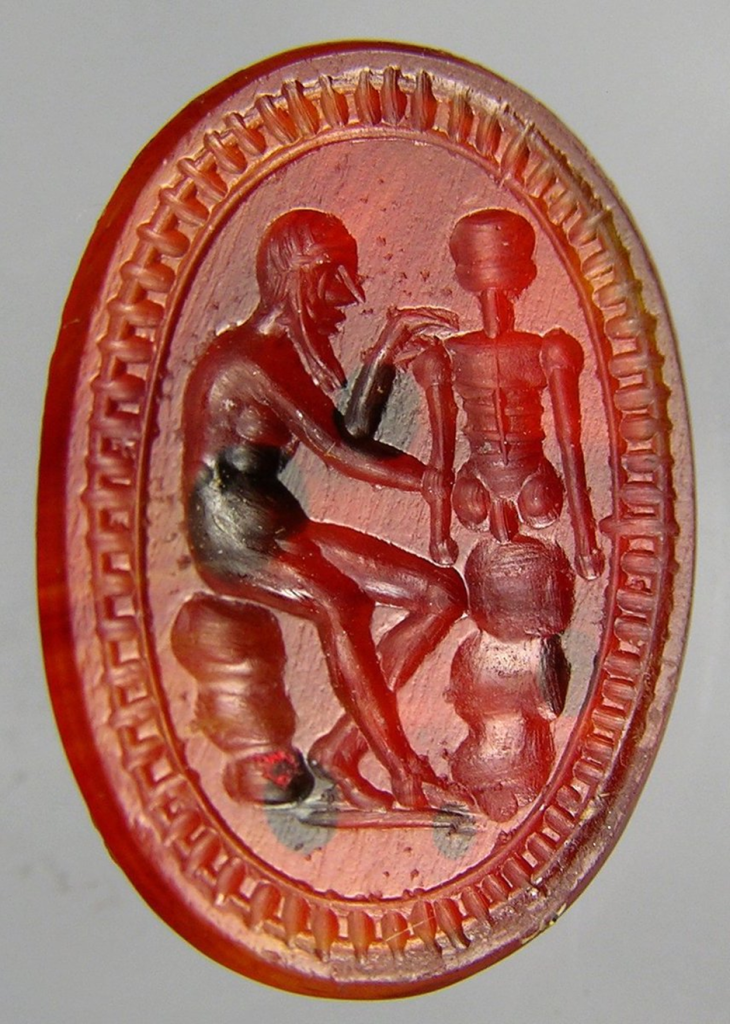
Image: Prometheus making humans. Prometheus shaped man out of mud, and Athena breathed life into the clay figure. Prometheus made man stand upright as the gods did and gave him fire. https://onlineonly.christies.com/s/masterpieces-miniature-ancient-engraved-gems-formerly-g-sangiorgi/italic-carnelian-ringstone-prometheus-26/147123
- “Walking on water” and “Immaculate conception”
As a constellation, “Jezus” can easily “walk on water” hoovering above it. It also explain “an immaculate conception” as a constellation is not born from a womb. but rises seasonaly. From a virgin, relates to either Virgo or Sirius.
- Entering Jerusalem through its gates as a saint and the muslims blocking it with a cemetery.
Again, the specific gate likely lined up with Orion, hence Jezus entering Jerusalem through that gate. The muslims putting a cemetery in front of the gate, or bricking it up to prevent a profet from entering, will not stop a constellation or the sun from alligning with it. In this case, it can also be a reference to “the sun entering the gate” on the equinox, since its an “eastern gate”. Blocking the gate would prevent this astronomical allignement and display of the gate framing the sun, from happening.

‘Golden Gate’) is the only eastern gate of the Temple Mount, and one of only two Gates of the Old City of Jerusalem that used to offer access into the city from the East side. The gate has been sealed since 1541, the most recent of several sealings. Its interior can be accessed from the Temple Mount. Source Wikipedia: https://en.wikipedia.org/wiki/Golden_Gate_(Jerusalem)#:~:text=’Golden%20Gate’)%20is%20the,city%20from%20the%20East%20side.&text=The%20gate%20has%20been%20sealed,accessed%20from%20the%20Temple%20Mount.
However, there is still a functional “golden gate” in the world. This phenomena is known as California Henge. A “henge” is when the sun aligns precisely with the street grid, and in this case, it happened around 6:45 a.m. at Gough Street and California Street.

It is noteworthy that the “golden gate” and the “silver gate” are astronomical markers in the sky for Ophiucius and Orion respectively. More on that later.
The easter bunny
he easter bunny
Besides easter where Christians celebrate “The resurrection” (Jesus as Orion coming back in the sky), other modern easter iconography is, the easter bunny. But hardly anyone knows why there is an easter bunny in the first place and why I has coloured eggs.
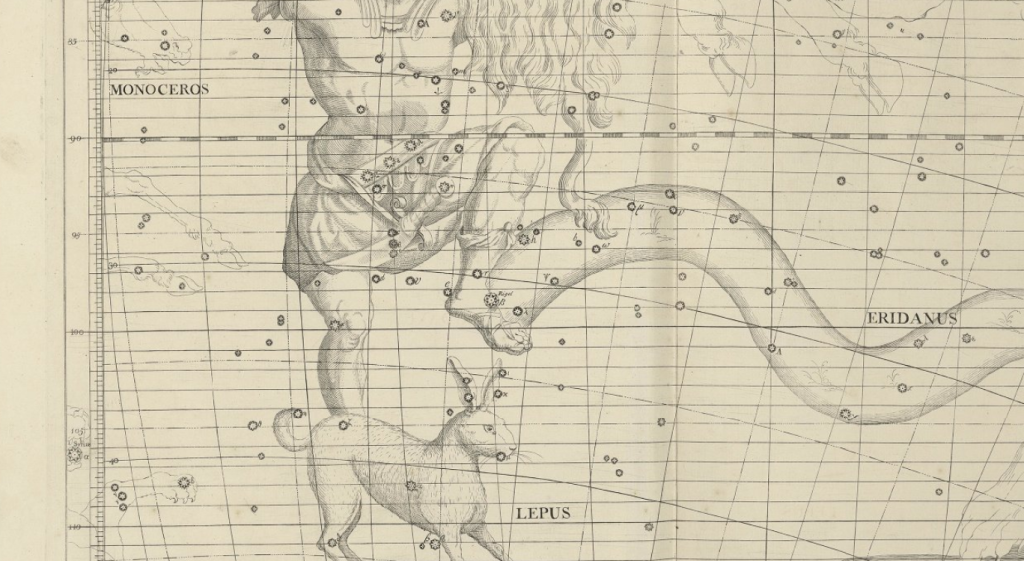
The origins of the easter bunny can be traced back to the German goddess Ostara.
In short, Ostara, the ancient Germanic goddess of the spring, transformed a bird into a hare, and the hare remembering it was once a bird, still layed eggs. The hare and the eggs are fertility symbols, symbolizing the fertility of the land at spring. Hare and Eggs fertility are symbols of spring.Under Orion, that hare is Lepus, and the story of it being a bird at first, relates to the Babylonian zodiac where Lepus was initially was a rooster.
Indeed the earlier bird / rooster was thus “transformed into a hare”. The Church kept the symbol as a rooster where it crowned church towers but disguided it as “Peters rooster”. See the article codex Dei.


Images: Paderborn, Germany: Dreihasenfenster (“Window of Three Hares”) in the cloister’s inner courtyard of Paderborn Cathedral. It shows the hare rotating through the year in an astromomical fashion. Image: The easter bunny, the hare with its eggs. Source: Wikipedia https://en.wikipedia.org/wiki/Easter_Bunny#/media/File:Paderborner_Dom_Dreihasenfenster.jpg and https://en.m.wikipedia.org/wiki/File:Easter_bunny.JPG
However on Church towers and links to Mercury the messenger of the gods it stayed a rooster for the same spring lepus and Orion relations.
The rooster and the true shepherd of Anu
We earlier touched on the rooster of the messenger of the gods, Mercury and showed its origin in Babylonian astronomy.

Gavin White Babylonian Star lore: https://solariapublications.files.wordpress.com/2011/10/jpeg-map21.jpg
This is also the real reason for the presence of the rooster on the church tower, its “pillar of heaven” tower, as an ancient obelisk.
The story of St. Peter after the Last Supper. In the biblical passages describing these events, it was said that Peter would deny Jesus three times “before the rooster crowed.” Because of this, the rooster became known to Christians as the symbol of St. Peter.
Sometime between 590 and 604 A.D., Pope Gregory I, took this a step farther, declaring that the rooster, emblem of St. Peter, was the most suitable symbol for Christianity. It is thought that this declaration led to the first roosters appearing on top of weathervanes.
The Rooster Becomes Law
In the 9th century, Pope Nicholas made the rooster official. His decree was that all churches must display the rooster on their steeples or domes as a symbol of Peter’s betrayal of Jesus. In accordance with the decree, churches started using weathervanes with the rooster.
Indeed, the current “occupants” of “St. Peter basilica” have “betrayed and denied the true meaning of Jesus” by telling people a false story, an astronomical allegory for over 2000 years.
The image of the Babylonian zodiac gives you the answer where the “shepherd figure” Jesus came from, as in Babylon, Orion was called “the true shepherd of Anu”. Anu, like Zeus, the main sky god, that later became Jaweh.

Image of St. Peter. The imagery here is not good at all, it shows the upside down cross, the papal crown, the rooster of betrayal and the two keys of heaven, (more on those) later.
Source: https://springfieldmuseums.org/collections/item/st-peter-currier-ives/ and https://springfieldmuseums.org/collections/item/st-peter-nathaniel-currier/

Image: This rooster from a stylistic viewpoint is datable to the ninth century. Pope Leo IV had it placed on top of the bell tower of the old Constantinian Basilica. Source: https://stpetersbasilica.info/Interior/Sacristy-Treasury/Items/Museum-8.htm
Not on the current Vatican, it was removed from the first vatican and never put back. Its an important clue in to understanding that Jezus is Orion. Just like Shiva. Another important object was made less important. The Pinecone washing fountain, instead, it was regrouped to form a “byzantine tree of life symbolism”, also clearly astronomical in nature, in a courtyard nearby.
The rooster is also a symbol of vigilance and to announce the break of day after the darkness of the night, or in the astronomical seasonal sense, the crow after winter as spring is announced.
Maybe one day, the rooster will be put back on St. Peters Basilica, to announce once again, “The betrayal of Jezus”. To choose St. Peter is a fitting apostle for the popes, as he was given the keys to rule.
It was also the one who also have “betrayed christ”. Perhaps for that reason the rooster did not make it back onto the new basilica as a remembrance to that fact and of course to the Babylonian version of the Lepus constellation.
The Cross
Why has Christianity a cross then if all of this is astronomy and not a “real crucifixion”?
For this one needs the pillar of heaven as the vertical stick and the horizontal stick represents the ecliptic path of the constellations. Hence, Orion/Jesus, dies and resurrects on that virtual cross, every year. Jesus is always there, never left and was never a real historical figure, instead, it was the syncretism of previous astronomical allegories.
It is a 2000 year regurgitated lie, old wine in new flasks, kept going by the priesthood and monarchies for power and control of people, to instill the fear of god and the devil.
It takes no rocket scientist to understand that the earth is ancient. Much of the older history of man, for example, why they build pyramids is debated. The author is of the opinion is that the pyramids, MR, was the same as the Indian “mount Meru”, symbolizing the primordial mount of Atum which is prominently featured in Egyptian religion, the benben bird on the top the central polestar or the constellation the big dipper, just like the eagle of Zeus, The mayan 7 macaw bird on top of the tree on King pakals tomblid and the thunderbird eagle of the Indians on the totempoles.
The cross as such is not a real cross, for a real life crucifixion. Its it’s the figurative cross in the sky, which the 4 evangelist perfectly mark.
And as such, Christianity was surely not the only one to depict this in 4 sections. The royal stars divided the firmament long back.
We can also see that “same cross” back with the Mayas, where its not Jesus, but their maize god was the dying and resurrecting god as depicted on Pakals tomblid. But mostly at Chichen Itza, where we see a perfect cross from the sky, taken by a poster on reddit, without permission.
It is a beautifull picture and clearly shows one “the cross”. You could say its just a byproduct of the structures architecture, but its not. Its intentional. Also this pyramid aligns perfectly to the 4 cardinal directions.
The temple has 365 steps—one for each day of the year. Each of the temple’s four sides has 91 steps, and the top platform makes the 365th. Devising a 365-day calendar was just one feat of Maya science. Incredibly, twice a year on the spring and autumn equinoxes, a shadow falls on the pyramid in the shape of a serpent. https://www.nationalgeographic.com/travel/world-heritage/article/chichen-itza#:~:text=The%20temple%20has%20365%20steps,the%20shape%20of%20a%20serpent.

Image Drone photo from Chichen Itza, initially posted on Reddit.
Lastly, there is a “red” jaguar throne inside one of the nested pyramids. More on this later.
The author chose specifically this image of it from Wikipedia as it gives a clue to the relation between the Chaac Mool figure and the Jaguar symbolism. It has to do with the symbol on the top of the Chaacmools “Hat”, where the rays shine directly to the Jaguar throne. I highly doubt this was noticed before as one needs to understand the relation between the two to notice it. When observing it, the author suspects the hat can be “read from the top” as an astronomical circle, the nose, the two side markers on the hat marking the 4 corners. The central mark is the pole star.

Red Jaguar throne inside one of the nested and older Chichen Itza pyramids. With Chaac Mool figure in front. Note how the hat, shines to the Jaguar throne. Source Wikipedia: https://upload.wikimedia.org/wikipedia/commons/a/ad/The_Jaguar_Throne_inlaid_with_jade_behind_the_Chac_Mool_…%28no_longer_on_display_since_2006%29_%2821161769963%29.jpg

Image: Mayan turquoise-mosaic Disk AD 900-1200, found within the throne seat of Chac Mool at Chichen Itza. The center of the stone is a pyrite mirror. And the four images, according to the experts, are dragons. Source: Wikipedia https://commons.wikimedia.org/wiki/File:Disque_Chichen_Itza_Mayas.jpg

Image of a mayan king with “the circle”: https://www.metmuseum.org/art/collection/search/318345
The symbolism of the circle for the rotating skies has been used in many cultures in many forms. Either with or without, the cross inside. The statue above also has the 4 directions seasonal markers dots.
There is a lot to say about this iconography found at Chichen Itza. But in short, it’s the rotating skies, the swastika shape for the 4 seasons, in this case likely marking the rotation of Draco. The bird rotating around the pole is the big dipper. That is the “bird of Zeus” or the eagle, thunderbird in native americans or 7 macaw on top of king Pakals tomblid, the tree of life.
The Chaacmool is the representation of the central Sky god, just like Zeus (thunder and rain god) and Jaweh. Symbolized with the pole star on his hat. The hat can be seen from the top, likely again divides in 4 directions. (Need a picture from top and back of a chaac mool) On his chest, a mirror, circle, as a reference to the sky
The leopard throne, is for his “son” who rotates around him, Orion, or the man representation in the heavens. Gods son, not unlike the symbol of Dyonisus, sitting on his leopard..

Image: Dionysos riding a leopard, Macedonian mosaic from Pella, Greece (4th century BC). Pebbles, terracotta and lead. 2.70 x 2.65 m. Source: Wikipedia: https://upload.wikimedia.org/wikipedia/commons/d/d0/Dionysos_on_a_cheetah%2C_Pella%2C_Greece.jpg
The priest garments in Egypt, Mayas , the chiefs in Africa and the clothes of Shiva who all used the leopard. Even the Etruscan tomb of the leopards, flanking the tree of life, symbolism usually done by other felines, like the Myceanean lions gate, the Aker lions, the chines temple lions and many other examples.
So one can ask, what does this side tour have to do with Christianity? These cultures, according to current academia, developed independently from each other and all of his “has nothing to do with each other”
All religions are astronomical allegories with references to the stars. Their iconography used in such is similar across cultures and all have borrowed the core symbolism from one another. But in essence, they are regurgitating. Putting old wine in new flasks. Telling the same story of the rotating skies with different characters, in essence, all saying the same.
The two snakes
The Chichen Itza tempel has two snakes on it, that display a specific shadow show at the equinoxes. Nice and decorative of them right? One would be a fool to look at it as such seen that the whole pyramid is related to time and the rotating skies, one has to question the intent. Could it also have some astronomical meaning?
The author wrote an extensive research paper on the symbolism of these snakes. (Source: https://www.academia.edu/100311409/The_meaning_of_snakes_and_dragons_across_world_cultures_on_religious_buildings_and_in_their_iconography) These occur in Egypt but mostly in Asia. Again, two cultures that seemingly had not influenced each other or had contact with each other. The current view of the author is that these two snakes are most likely related to the Milkyway, the big snake in the sky, to the ecliptic path or a combination of both.
The symbolism of the usage of two snakes is global. From the two snakes of Egypt, to the two snakes of the minoan snake goddess, to the Caduceus of Mercury, “the messenger of the gods”.
A voice of God, like a prophet or in modern times, what priest, bishops, popes or other “holy people” deem themselves to be. To think they, the popes, the priests, the cardinals, the rabbis, the imams are special and gods voice is rather arrogant. They are temporary, mortal and replaced soon by successors when they die like the rest of us.. The world does not revolve around them. It revolves around the central pole star.
“The universe resides in all of us and every thing.” – Isu Trikanda”

Image: Mercury, messenger of the gods. Mercurius by Artus Quellinus the Elder , Amsterdam royal palace. Its symbolism, a rooster (!), winged hat/shoes, a ram and a his caduceus, his famous double entwineed serpent staff. Source: https://upload.wikimedia.org/wikipedia/commons/2/20/Amsterdam_Royal_Palace_2747_%28cropped%29.jpg

There are a few variations of a bishops staff, called a crosier, one in style of a shepherds staff,
One with double snakes and one in a curved Tau cross. The author suggest that the shepherds staff is a link to Jesus staff, or, the true shepherd of Anu’s staff / Orion, the Tau cross to the curved ecliptic band. The “two snake staff” is not Moses single snake staff, whose staff, turned into a snake and backwards, “eating the Pharaos magicians staffs” as sometimes claimed, but a direct knock off of the earlier mentioned symbolism. In fact, The eastern style crosier, is, a miniature Chichen Itza in staff form, cross and two snakes. Astronomic symbolism at its finest. For further reading on the symbolism of the snakes please refer to the separate paper as its to much to include here to not deviate to much from the current subject.
The two Vatican keys (The keys to gates of heaven)
Quote: In the Gospel of Matthew 16:19, Jesus says to Peter, “I will give you the keys of the kingdom of heaven, and whatever you bind on Earth shall be bound in heaven, and whatever you loose on Earth shall be loosed in heaven.”
“The keys of heaven or keys of Saint Peter are seen as a symbol of papal authority and are seen on papal coats of arms (those of individual popes) and those of the Holy See and Vatican City State: “Behold he [Peter] received the keys of the kingdom of heaven, the power of binding and loosing is committed to him, the care of the whole Church and its government is given to him”.” Source: https://en.wikipedia.org/wiki/Keys_of_Heaven
The silver and golden key of the Vatican is again astronomical in nature and refers to the golden and silver gate, gateways of the souls. It is the section where the ecliptic path crosses the milkyway. When the sun passes the golden gate it becomes summer and when the sun passes the silver gate it becomes winter. They are the keys to the fictional gates in heaven.
Quote: “After his own death on a hunting trip at the hands of Scorpius, the healer Aesculapius (identified with Ophiuchus, who learned the art of healing from a snake) brought Orion back to life with his magic serpent’s aid. This angered Hades, who petitioned Zeus to kill them both by thunderbolt. Zeus, for once feeling bad about murder, then awarded Orion, Ophiuchus and all their surrounding animals with constellations memorializing them, keeping Orion and Scorpius at the sky’s opposite ends.
To a majority of ancient Mediterranean and Near Eastern sources, it seems these points mark what are dubbed the “gateways of the soul”. One, at Orion’s hand, marks the “silver gate”, or the Gate of Man. The other, more sparsely attested gate in Ophiuchus marks the “golden gate” or the Gate of the Gods. Both are gates on the road traversed by the souls of the dead, often equated with the Milky Way, and both show us why it’s so crucial that it was Ophiuchus who bested Scorpius and resurrected Orion in the Greek myth.” Source: https://medium.com/interfaith-now/orion-ophiuchus-the-silver-gate-the-journey-of-souls-981d19463d28

Image: Orion and Ophicius Orion and Ophiuchus, respectively, engraved by Sidney Hall (1824)

Image: Vatican crest with golden and silver key https://en.wikipedia.org/wiki/Keys_of_Heaven
Watch and beware the teachings of these “shepherds”, who are leading the “flock, the house of Judah” astray with their teaching, leaving them to become the “lost sheep of the house of Israel”.
Like Shebna, they hold the “keys to the House of David” on their shoulders while they “sit on the Seat of Moses”.
The “silver” gate. Where the ecliptic crosses the milky way at Orion.
Image sources: http://www.germanicmythology.com/ASTRONOMY/MilkyWay2.html
The “golden gate”. Where the ecliptic crosses the milky way at Ophicius.
Image sources: http://www.germanicmythology.com/ASTRONOMY/MilkyWay2.html


The Vatican Pigna fountain
The famous Pigna plaza in Rome is a composition of objects from different time periods and countries, some centuries apart. The pinecone, and likely the peacocks judging by the old picture (although they seemed to have earlier sources before that), came from the previous vatican basilica, where it hold a prominent place as a fountain before entering the basilica, for travellers to wash themselves before entering, not unlike todays mosques. The pinecone itself is a fountain.


Image: installation with bronze pine-cone in the atrium of Old St Peter’s Basilica, Rome. Drawing by Cronaca
Image: pianta di Roma di Etienne Du Perac (1577), particolare del Vaticano.
In its form its hold the mathematics of creation, Phi and the Fibonacci sequence, like the great Egyptian pyramid and some others slope or, Greek temples and churches, which have it also encoded in their construction.

Image: Explanation how Phi is encoded in a pinecone
Source: https://slideplayer.com/slide/8500843/
The lions and the peacocks, the pinecone, “the fruit of the evergreen pine” makes up the tree of life, a metaphor for the rotating skies and time itself, where creation itself, is its fruit. The arrangement of these objects into a new composition, was not random.

Image: Pigna fountain, Vatican
Source: https://www.arrivalguides.com/en/Travelguide/Rimini/doandsee/pigna-fountain-17468
Its intend can be clearly seen when we are putting these images together.

Image: Byzantine tree of life motive
As one now can clearly see, the Pigna fountain is an arranged Byzantine “tree of life”, metaphor for the rotating skies, combies earths lions with the skies birds(usually eagles) that together form the gryphon. That symbolism of the gryphon can be seen on the old basilica picture above, similar to the myceanen lions gate of two lions flanking the pillar of heaven but more like the delphi sarcophagus. The pillar of heaven, the trunk of the tree of life.

Image: Delphi sarcophagus, iconography of gryphons flanking the pillar of heaven, the fire the sun.
Source: https://commons.wikimedia.org/wiki/File:07Delphi_Sarkophag.jpg
In its center, the thunder skygod bringing rain as a waterfeature in its center. Also the 4 pillars, symbolizing the 4 seasons.
It is noteworthy that “the rotating skies” or milkyway had a few metaphors. Being a tree (“canopy with fruit”), the sea, a grape vine, a mountain (Meru). There is a reason the great pyramid was a 4 sides pyramid perfectly aligned to the cardinal directions, that there where 4 sons of Horus (Imsety, Duamutef, Hapi, Qebehsenuef ) or 4 godesses (Isis, Serket, Neith, Nepthys) linked to the cardinal directions, even placed as such in King Tuts Shrine. They are also seen on the Denderra zodiac.
There is 1 similar pinecone fountain, the Aachen cathedral one, watering holes on the tips of the leaves and on the 4 corners in figures that are now damaged said to represent the personified rivers, but I am not 100% sure of that as it could be the 4 seasons also,
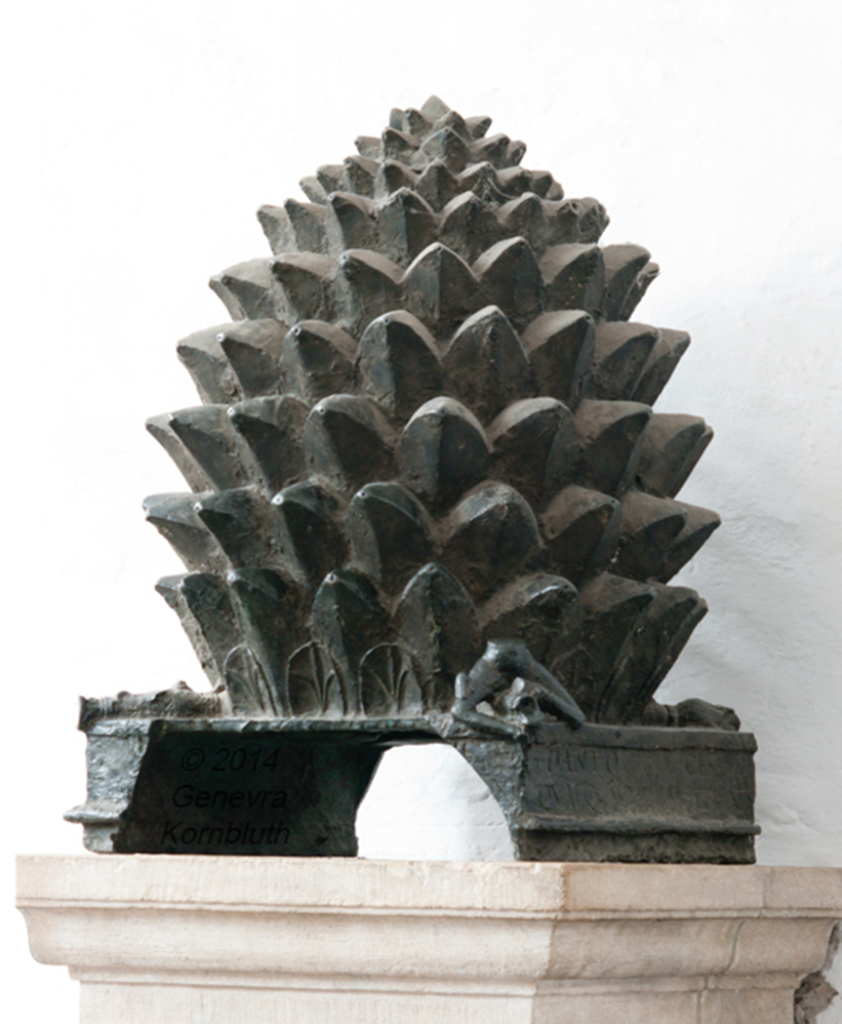
Image:s Aachen Cathedral pinecone. Bronze, height 91 cm, diameter in center 68 cm (35.8 x 26.8 inches), around 800ad or 1000ad. Base with inscription tenth century. Probably part of a fountain in the cathedral atrium, set on a column next to the door by the late 15th c.taken to Paris 1794, returned to Aachen 1815, placed in vestibule 1893
inscription: “Water gives to this world whatever they bring to its growth; the fertile Euphrates, the Tigris fast as an arrow. The maker Udelrich the pious abbot sings thanks.” Source of Images: https://www.kornbluthphoto.com/AachenPinecone.html



One can argue that symbolism of the pinecone, has fallen out of fashion, remembering previous symbolism of Dyon-ISUS thyrsus staff.

Image: Staff of DyonISUS. https://en.wikipedia.org/wiki/Thyrsus
The popes and their cardinals
These are a reference to the “cardinal” directions.
The old testament
He will be great and will be called the Son of the Most High; and the Lord God will give Him the throne of His father David; and He will reign over the house of Jacob forever, and His kingdom will have no end.” [Luke 1:32-33]
And the key of the house of David will I lay upon his shoulder; so he shall open, and none shall shut; and he shall shut, and none shall open. [Isaiah 22:22]
The old testament
What about the old testament, the creation of the world in 7 days and Adam and Eve?
What kind of main story lines we find here:
- Adam and Eve
- Adam son of god, Eve made from Adam.
- Created from clay
- Serpent in the tree of the garden of eden
- Expelled, after eating the apple, by the serpent
- Two sons
- Great flood
- Ark with animals
Eden, is the spring summer season, when everything is green and lush and there is plenty food. When Adam and Eve, Orion and Sirius respectively, (like Osiris/isis, Sah and Sopdet) “ate from the apple in the tree” which is the sun in the metaphor of the stary sky, the tree of life, the seasons turned into autumn, they literally “where expelled from the garden of eden” by the snake, which is Hydra as they disappeared from the sky and the land turned barren.
So where did this Adam and Eve story come from? From Egypt, where it was first Sah and Sopdet and later, Isis and Osiris, but the basis of these personified constellations goes back to Egypt. It is Ra who defeats the snake Apophis (also known as Apep) is the Great Serpent, enemy of the sun god Ra, in ancient Egyptian religion
The snake was always the adversary and represented evil, just like the snake in the garden of Eden as it indicated the barren autumn and winter season.
This story of “defeating the snake” found its way in later history where the hero George slays the dragon. There are images of Horus on horseback slaying the serpent that preceeds these. Horus, sits in between Isis and Osiris in the zodiac and is “their child” .The area next to Orion is called the constellation “the manger,” where “Jesus was born” in between the ox (taurus) and the donkey (Cancer)
So is Jesus, Orion, Hercules, Osiris the same thing? Yes it is. And Melqart from the Phoenicians and even Shiva the cosmic dancer with its Trident (the 3 headed spear) as the orion constellation. Often accompanied by a deer, which is the later name for the Orion Nakshastra lunar mansion, the deer. The hunter, the lord of the animals (zodiac) and the female version, the mistress of the animals, being Sirius, or, the great mother, as the brightest star in the sky.
Life as a deck of cards
Even in a simple set of playing cards, one can find time. In fact, a deck of cards is a calendar, it has 4 suites, for the 4 seasons, 52 cards, for the 52 weeks, 12 picture cards for the 12 months and if one counts all the values one comes to 365 for the days, with the added joker, for the leap year.
The Alice in wonderland white rabbit with the watch
As Lepus the hare under Orion “keeps time” and is a fertility symbol at spring as the easter bunny, with his eggs, also the bunny appears in the moon, which again is related to fertility in the female menstrual cycle. This moon rabbit relates to the Chinese story of the hare, who had nothing to give, threw himself in the fire for his flesh. This act of selfishness was rewarded by putting him on the moon where he mixes the elixir of life in his mortar and pestle.
personified constellations. Spring and the spring constellation as the start of the new year plated a large role in these stories.
Conclusion
Even though a lot was discussed here, explaining symbology and personified astronomy used in religion and mythology, does not answer what is the cause of creation or what determines life and death, who you meet in life, what your destiny or path is.
It does answer what the Bible was truly about, a syncretized astronomical allegory based on previous astronomical allegories/religions that influenced it and was the basis for the stories in the old and new testament. This document tried to explain what the story of Jesus and the 12 apostels or, Adam and eve and the snake, was derived from, being an astronomical allegory but in doing so tried to give the reader a bigger picture. It also expanded on other religions to show the similarities in stories derived from a celestial battle between two brothers or between Orion and Hydra. A fertility part of spring and summer vs a war part of Autumn and winter.
The italian word Infernos for winter, closely resembles the word for hell. Although nobody has identified the links between the two. These links are astronomical.
There we find Capricorn the goat in the so called “underworld of the zodiac” It was there were the scorpion, snake, Nergal wargod (apollo) lived. It was this zodiac that was the basis of the one brother slaying the other, the 12 apostels, the 4 evengalist, the story of the donkey jesus rode and many other references described here.
By no means Jezus and his 12 apostels was an historic account of real events, regardless what the current status quo on this is or wat 2.4 billion people believe currently due to a repetative lie that has been peddled for over 2000 years. The author tried to highlight that the bible was two seperate astronomical allegories and that all religions and mythology eventually derived from astronomy by describing both the rotation of the skies in a separate allegory, with personified constellations as Characters, which has always been the basis for any “god” / “gods” or mythology stories. Mythology as its called today, is astronomy that is not understood or recognized as such.
Zeus and his gods “lived on mount Olympus” Jaweh met Moses on the mountain, Jesus went to heaven, its all personified constellations and planets and god being the central pole star.
The bird, always in relation to god, wether an eagle or a dove or a macaw, was a representation of the big dipper constellation. circling the pole star. This circeling of the pole star also was the basis of the swastika and thus in combination with the eagle, stolen from zeus, both a reference to the big dipper on the circle laurel of time.
One can call “god” any name you want and people have done so for centuries, fought each other as their “god” was better, build different houses of worship to the phenomena of life, which the Egyptians executed perfectly in created a Pi pyramid, the math of nature. Even the Greek temples adhered to the math of Pi in their designs.
As if one would have to build a building to the the principle of creation and life itself, surely one should follow the math of Pi and Fibonacci in its design. A football stadium is not a church. Nor is any building that was not designed as such and then converted into “a house of god”.
A priest does bot conduct a mass. It’s a place of “mass deception” that severed and lost all symbolism that is encoded in a true church or cathedral as the building itself told a story like a book, the story of the seasons and time itself and Orion dying and resurrecting on the cross, plus the story of the rooster, the companion the true shepherd of Anu or the “messenger of god”.

Hi there, I appreciate you reading my blog! 👀
The information presented here is free to read, with no ads. If you like this content, please consider supporting my writing by clicking on the link to become a member at Patreon Instead of a monthly recurring Patreon membership, you can also make a once off donation via Paypal or subscribe to my Youtube channel or follow me on X. 👇🏻
Thanks for your support!
If you liked this research article please consider supporting the author, by scrolling down for various options, on the main page or sharing a link to this blog post or blog www.isutrikanda.com on your social media so others can also read it. You can also follow me on X @stijnvdhoven Thank you!
www.isutrikanda.com – IsuTrikanda – Copyright © 1999 – 2024 – All Rights Reserved.




